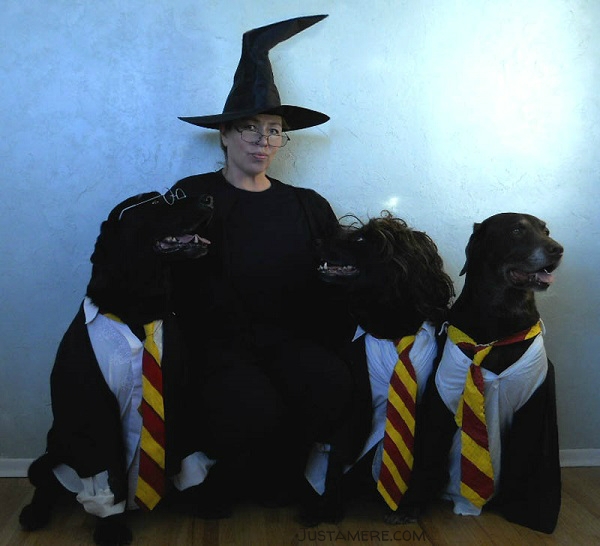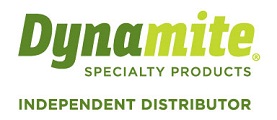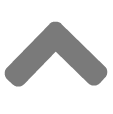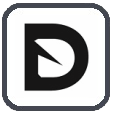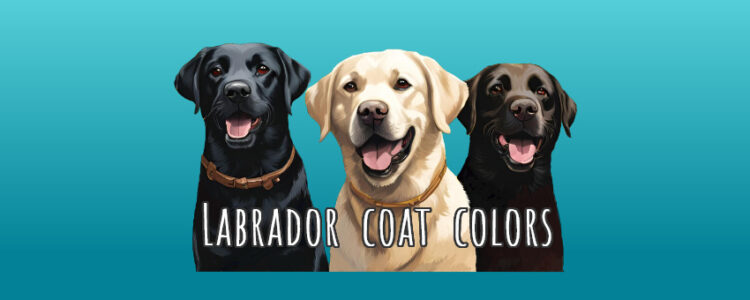
Have you ever wondered about Labrador coat colors? Such as how two black Labs can have chocolate and/or yellow puppies? Or why breeding a chocolate to a yellow often produces all black puppies?
Well, it’s genetics that determines Labrador coat colors. But before we get into all of that, did you know Labs come in four colors? Yep, and I’m not talking about the “designer” dogs in silver or charcoal. You’ve probably even seen all four colors and didn’t realize it.
So what are they?
The three Labrador coat colors (plus one)
Well, there’s black. No surprise there. There’s also chocolate. Again, no surprise.
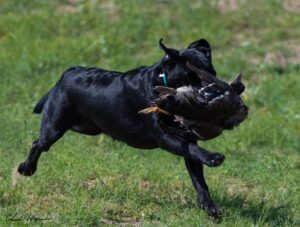
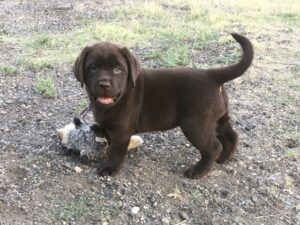
Then we get to the yellows. This color comes in shades from pale cream to rich fox red. They have a black nose and eye rims.
The fourth color looks like a yellow at first glance, but they have a chocolate nose and eye rims. These are called Dudleys and they carry the genes for both chocolate and yellow.
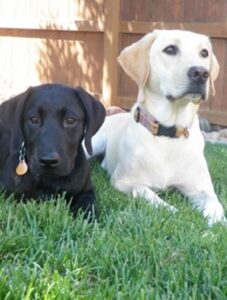
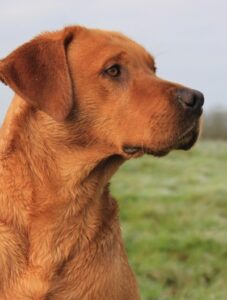
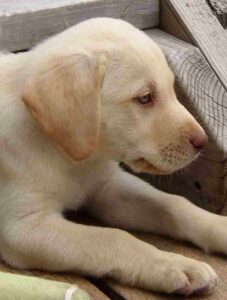
There’s nothing wrong with Dudleys, but they are disqualified in dog shows. Some people think these are light-colored chocolate Labs or a mixed breed. They are neither.
Genetic basics
To understand how the Labrador coat colors are inherited we have to take a look at some science. If there’s a term you don’t understand click to scroll down to Genetic terms.
The blueprint of each dog is contained in its DNA which is made up of 39 pairs of chromosomes. Half of those chromosomes came from the dog’s father and the other half came from the dog’s mother.
Along those chromosomes are genes. Each pair of genes controls a portion of that blueprint. The gene pairs can be the same which is written with two capital letters such as “BB” or two small letters such as “bb” (homozygous). Or they can be different (heterozygous) which is written with a capital and a small letter such as “Bb”.
If they are different, the dominant gene will show and the recessive gene will be hidden.
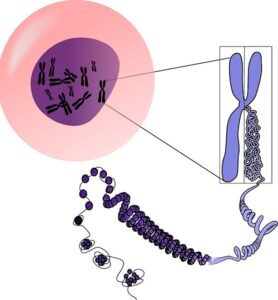
This is a cell with chromosomes and genes.
Applying genetics to Labrador coat colors
In Labs, the gene for black (“B”) is dominant to chocolate (“b”). The “B” or “b” shows that these are two versions of the same gene and that the one with the capital letter is dominant to the small letter.
If the dog has at least one of the “B” genes, he will be black. With an exception we’ll get to. So BB and Bb mean the dog is black, but bb means the dog is chocolate.
Yellow is determined by different genes which can be EE or Ee or ee. The “E” gene determines whether the dog will be yellow or not yellow. If the dog has one copy of the “E” version of the gene, he will be black or chocolate depending on the “B” gene. But if the dog has two copies of the “e” version he will be yellow. That is the exception. Usually a Lab with “BB” genes is black, but if he also has “ee” genes he will be yellow. In this case the yellow gene will override the black gene.
Labs with two copies each of the “b” and “e” genes (“eebb”) will be yellow with a chocolate nose and eye rims. These are the Dudleys. Other people say they’re “NBP” which is short for No Black Pigment.
Labrador coat colors
Okay, so that was a somewhat simplified version of genetics, now we can get into colors.
Dogs need at least one copy of the “B” gene to have a black nose and eye rims. If they also have at least one copy of the “E” gene, they will have a black coat.
A dog with two copies of the “b” gene will have chocolate pigment on the nose and eye rims. If he also has two copies of the “e” gene, his coat will be yellow. However if he has one or two copies of the “E” gene his coat will be chocolate.
Clear as mud? Here’s a chart:
| Lab Colors | Color Code | Description |
|---|---|---|
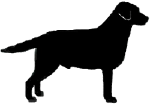 |
EEBB | Black, no hidden color |
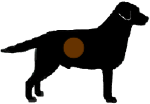 |
EEBb | Black with hidden chocolate |
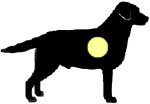 |
EeBB | Black with hidden yellow |
 |
EeBb | Black with hidden yellow and chocolate |
 |
EEbb | Chocolate with no hidden color |
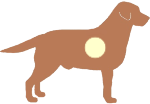 |
Eebb | Chocolate with hidden yellow |
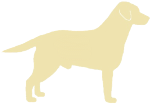 |
eeBB | Yellow with no hidden color |
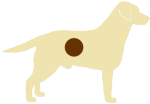 |
eeBb | Yellow with hidden chocolate |
 |
eebb | Yellow with chocolate pigment, including the nose and eye rims – a Dudley |
So those four colors we see break down into nine different colors when we look at the genetics.
Punnet Squares
A Punnet square makes it easier to calculate what colors and approximate percentages we might get in a litter. The father’s contribution is listed along the top and the mother’s contribution is along the side.
Let’s try combining the genes. For the sake of clarity we’ll start with just the black/chocolate gene. If both parents are black, but they carry the gene for chocolate their code is “Bb”.
So we put a “B” and a “b” across the top and a “B” and a “b” along the side.
Here’s how the square looks filled in:
| B | b | |
|---|---|---|
| B | BB | Bb |
| b | Bb | bb |
In this case the genes have a 25% chance of combining as “BB”, a 50% chance of combining as “Bb” and a 25% chance of combining as “bb”. Only the “bb” would show as chocolate.
If the litter size was large enough—more than 100—you would probably see a distribution of colors fairly close to these percentages. However because litter size is much smaller you could get all blacks or all chocolates or somewhere in between.
Here is yellow vs not yellow:
| E | e | |
|---|---|---|
| E | EE | Ee |
| e | Ee | ee |
The EE is basic black. Ee is black that has hidden yellow. And ee is yellow.
Combining the traits
If both parents are black and carry the genes for chocolate and yellow they would be “EeBb” (Ee = hidden yellow, Bb = hidden chocolate). That means they could have black, chocolate, yellow, and/or Dudley puppies.
Below is the Punnet Square combining both “B” and “E” genes. Can you figure out which combinations will be black? Or yellow? Or chocolate? No cheating!
| EB | Eb | eB | eb | |
|---|---|---|---|---|
| EB | EEBB | EEBb | EeBB | EeBb |
| Eb | EEBb | EEbb | EeBb | Eebb |
| eB | EeBB | EeBb | eeBB | eeBb |
| eb | EeBb | Eebb | eeBb | eebb |
Yeowie!! That looks a lot, but there’s really only nine different combinations. The percentages break down like this:
- 25% EeBb
- 12.5% EEBb
- 12.5% EeBB
- 12.5% Eebb
- 12.5% eeBb
- 6.25% EEBB
- 6.25% EEbb
- 6.25% eeBB
- 6.25% eebb
How about the chocolate bred to a yellow that produced all blacks? Was that a mistake?
| Eb | Eb | |
|---|---|---|
| eB | EeBb | EeBb |
| eB | EeBb | EeBb |
Well, let’s see. If dad is “EEbb” (chocolate) and mom is “eeBB” (yellow), all of their offspring will be “EeBb”. The dominant form of “E” is not yellow and the dominant form of “B” is black. So, all of the puppies will be black, but will carry the genes for both chocolate and yellow.
Determining parents’ color
You can also work backwards from the puppies to the parents. For example, if a black male has even one chocolate puppy in his lifetime, he is “Bb”. If he’s been bred to a few yellows and never produced a yellow puppy, he’s probably “EE”. However we wouldn’t know for sure without testing.
If a yellow female has been bred to a black male and they had black and yellow puppies, but no chocolates, what would you conclude? Well, we know dad carries yellow, because he had yellow puppies. But dad’s yellow is hidden so he’s “Ee” and mom is yellow so she’s “ee”.
Because dad is black he must have at least one “B”, but we don’t know anything about the other in the pair. He might carry chocolate while the mother doesn’t have it or she might carry chocolate and he doesn’t. Or it could be that neither carry chocolate. Or they could both carry chocolate and Mother Nature just didn’t pair the genes for the chocolate to appear. So dad would be “EeB?” and mom is “eeB?” (where the ? means an unknown gene). However if mom has a chocolate nose she would be “eebb”.
The “Silver” Labs
Several decades ago a man decided to breed Labs to Weimaraners to get silver-colored “Labradors.” Obviously these are not purebred Labradors despite what some owners think.
Purebred Labradors are “DD”. Weimaraners are “dd” which dilutes their coat color. When these two breeds are bred together you get puppies that are “Dd”. This cross-breed looks similar to Labs, including the coat color, however they carry the dilution gene (“d”). When they’re bred together they can produce the so-called “silver Lab” depending on the color of the original Labrador. Other variations are called charcoal (diluted black) and champagne (diluted yellow).
Unfortunately AKC has allowed these cross-bred dogs to be registered as purebred Labrador Retrievers. It is a mess that needs cleaning up.
Coat Mismarks
When the St. John’s Dog (our Labs’ ancestor) arrived in Britain, there were too few of them to keep the line pure. Some were bred to Pointers or Flat-coated retrievers, others to Collies or Rottweilers.
The St. John’s Dog had strong genes and often produced puppies that looked like a SJD despite the other parent. However some characteristics of those other dogs were added to the gene pool. Most have been bred out, but surprises pop up now and again. We call these dogs mismarks.
Most common is a small white spot on the chest. It’s allowed, but not desirable. Gray hairs from scars or aging are not penalized.
However tan markings, such as Dobermans have, and brindling are disqualifying traits. As is any color other than black, yellow with black nose and eye rims, or chocolate.
Here is a brindle. These are tan or brown dogs with slender black stripes. The color is seen most often in Boxers, Great Danes, and Greyhounds.

Some Labs have tan markings like a Doberman or Rottweiler.

Others are splashed with white or sometimes with black. It’s not common, but I have seen a Lab with a white blaze on his face and another that had white toes. Both dogs are purebred Labradors.
Most interesting of all are the chimeras. This is a rare genetic mutation that happens when two embryos fuse together. In this case, it looks like an embryo of a black puppy fused with a embryo of a yellow puppy.
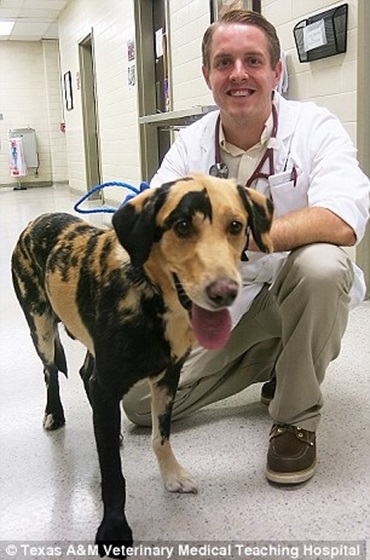
A good Lab is a good Lab, no matter the color
Now you know about Labrador coat colors, both the colors you see and the ones that are hidden. You know Labradors come in black, yellow, or chocolate and sometimes have hidden copies of those colors.
How many unique crosses do you think there are, taking into account the seen and unseen colors? For example, you could breed a black Lab with hidden chocolate to a black Lab with hidden yellow. Or a black Lab with hidden yellow to a yellow Lab with hidden chocolate. Or two black Labs and neither has hidden yellow or chocolate. So these are three to start off, but there are a lot more.
Hint #1: Use the color shorthand. For example, “EEBB” for black with no hidden color. Or “EEBb” for black carrying hidden chocolate.
Hint #2: Be methodical. List all the black variations. Then pair the first variation with each of the variations. Then pair the second variation with each of the variations. And so on.
Frequently asked questions:
Can two black labs have yellow puppies?
Yes, but only if both parents carry the hidden yellow gene.
What color Labradors can you get?
Labrador coat colors are black, yellow, or chocolate. Black is wholly black, although it may have a small white spot on it’s chest. Yellow can range from nearly white to a rich orangish red. Chocolates are supposed to be, well, chocolate.
Is there a coat color test for Labrador Retrievers?
Yes, several laboratories can test for color. I use DDC because they are helpful, with a fast turnaround time, and are less expensive than some other labs.
Does Labrador coat color matter?
For a pet, no, it doesn’t matter. However if you plan to compete in the show ring, it can matter if the dog has any mismarks. Also the so-called “Silver Labs” tend to have color dilution alopecia which is a genetic condition affecting their skin and coat.
Do different color Labradors have different personalities?
Years ago there were rumors that chocolate Labs were hyperactive, yellows were lazy, and blacks were the best of all. Having had many Labs over the years, I’ve never seen temperament connected to coat color.
Which color of Labrador is the best to buy?
It depends on your preference. Some people say chocolate Labs don’t live as long, but my chocolate boy lived to 17. I know someone whose black Lab lived to 18.
Do white Labrador retrievers exist?
Not really. The “polar bear white” Labs that some people advertise are really just a yellow dog with very light pigment.
Should I get a silver Lab?
I would advise against it. They’re not purebred Labradors, but have been mixed with Weimaraner. Plus they’re prone to color dilution alopecia and are often more expensive than purebred Labs.
Genetic terms
Genes
The basic unit of inheritance. Genes are passed from parents to children and contain the information needed to specify physical and biological traits.
Alleles
Different variants of genes. Each parent provides one allele of a pair.
Chromosomes
Thread-like strands that contain hundreds, or even thousands, of genes
Dominant vs Recessive
If one allele in a pair always makes a trait appear, that allele is called “dominant.” The other allele is recessive. For example, a Lab might be black (a dominant trait) and carry an unseen chocolate allele (a recessive trait). The dominant allele is shown as a capital litter and the recessive allele is shown as a lower-case letter, for example Bb.
Genotype
The entire set of genetic material of a dog (or cat, person, etc).
Phenotype
The physical characteristics of something living, especially those characteristics that can be seen
Homozygous
The same alleles of a gene from both the parents (written as two capital letters, such as BB)
Heterozygous
Different alleles of a gene from the two parents (for example, Bb)
A costume contest for pets got me thinking about what Halloween costumes for dogs might be available. I also needed coordinating costumes as my dogs, Chip, Tory and Arwen, would all be participating.
And, rather than buying something ready-made, I wanted to make the dog Halloween costumes myself.
Come along with me to learn about my thought process, dog costume ideas, what supplies I bought, and how I made the costumes.
The 3 Musketeers started it all
All for one, one for all!
Designing the costumes was interesting because they had to be instantly recognizable, but my dogs also had to walk in them. After a quick Google image search, I decided on hats with feather plumes and the signature musketeer tunic. I also bought plastic swords for all of them, but could only convince one dog that they weren’t chew toys.
I started by measuring each dog from just below their collar to just above their front feet. Then I measured in back from just below their collar to the base of their tail. I also measured across their chests, from the outside of one leg to the outside of the other leg. And finally I measured across their chest and shoulders and back around to the front. This measurement, less across the chest, gave me the top of the cape measurement. (Just in case, I added 2 inches.)
Next was calculating the amount of fabric needed and making a list of supplies.
After cutting out and test fitting, I stitched together the tunic and cape at the top corners. Then I glued gold braid around the edges of the fabric. I saved painting the crosses for last so I didn’t risk smearing the paint.
Next I reshaped the hats using moist heat and lots of patience. I attached the white feathers with a couple spots of glue. And finally I added some thin elastic as chin straps to keep the hats on their heads.
Luckily Labs don’t mind playing silly games like dress up! They did spectacularly and even won the costume contest at the local Labrador club.
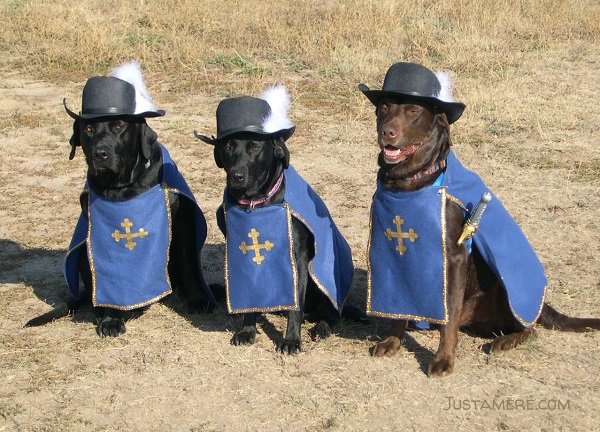
Supplies
- blue felt fabric
- gold braid trim
- gold fabric paint
- 3 black cowboy hats
- 3 fluffy white feathers
- 3 plastic swords
- hot glue gun and glue sticks
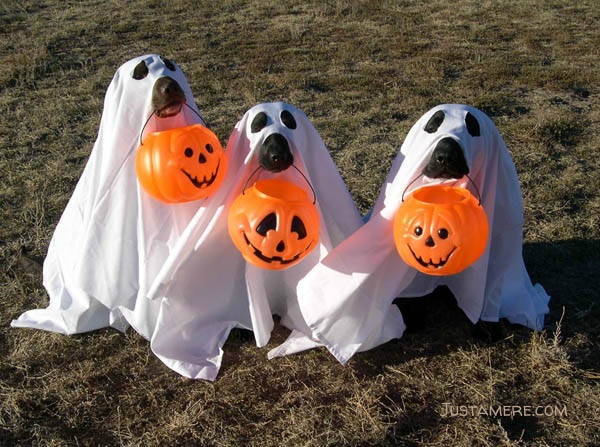
Supplies:
- 3 white flat sheets
- 3 plastic jack-o-lanterns
Trick or treating ghosts
What could be more iconic than ghosts on Halloween? Except these ghosts had four legs!
That year was a test of their obedience skills. They had to sit with sheets over their heads and carry plastic jack-o-lantern buckets.
Buying three flat sheets and three jack-o-lanterns was the easy part.
Next came draping a sheet over each dog and determining the best place to cut holes. It took some trial and error – with each dog – to find the perfect place and sizes for the holes. I made sure to start with small holes and test fitted before making the holes bigger.
My dogs were all taught to fetch on command, but it took a bit to convince them that fetch also applied to the thin bucket handles. After all, they were used to retrieving birds or a bumper.
Then they had to learn that I wanted them to sit, with a sheet draped over them, AND hold the bucket. And they had to do it at the same time and for long enough to get pictures.
They did it and got plenty of treats!
Four-legged duck hunters
The next year had to be something simple because I didn’t have time to make elaborate costumes for Halloween. So I dug out some hunting clothes – ball caps, camo shirts, duck calls, whistles, etc.
After getting them all dressed, something just didn’t look right. Off I went to the nearest thrift store where I found three pairs of kid’s pants in tan and green.
Getting all three dogs to wear the hats, shirts, whistles and duck calls was easy. Putting pants on them took a bit more work. =D
When they were dressed and sitting attentively, I took the picture. And just then the shotgun fell over. No, it wasn’t loaded, but it got their attention. As they moved, hats fell off, pant cuffs were stepped on and general mayhem ensued.
Good thing that one photo turn out so well!

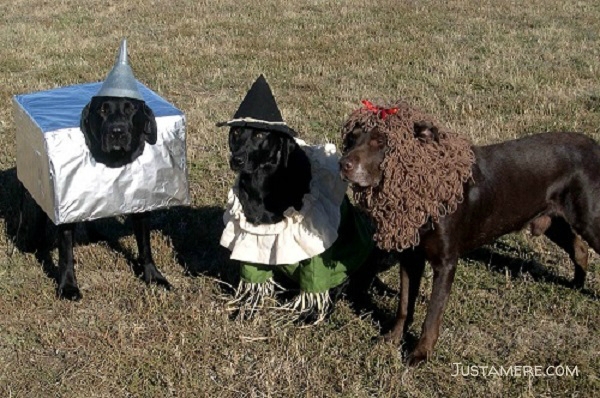
Follow the yellow brick road
As Halloween drew nearer, I was trying to come up with a theme so each dog would have a unique costume but be recognizable as a trio. Pairs are easy, threesomes take more work!
The Tin Man costume
I found a box as long as my dog from chest to tail. Next I taped the flaps to the inside and flipped the box over. Then I cut a large hole with about half on the front and half on the top. The hole should be just big enough for the dog’s head to slip through.
I tried painting the box silver, but it didn’t look metallic enough. Instead, I covered it in aluminum foil. It looked better, but made a crinkly noise when moved. It took some patience and a few practice sessions before Tory felt comfortable wearing the box.
I used an old metal funnel for the hat. After drilling a couple holes near the top of the funnel, I added some thin elastic to go under his chin.
Good thing he had learned the Stand for Exam obedience exercise!
The Scarecrow costume
Arwen‘s Scarecrow costume took some sewing and several fittings to come close to fitting her. I started with a shirt pattern, but made the front narrower and the back wider. In hindsight, using a plain green t-shirt would have been easier. For the collar, I stitched a piece of creamy white fabric into a circle and added elastic near the top.
For the hat, I glued black felt into a cone shape. The wide end needed to be about the width of the dog’s head. Next I cut a circle that was about 2″ wider than the base of the cone. I glued it to the cone and cut out the center portion. Thin black elastic kept the hat in place. I also glued short bits of raffia to the brim.
Just before taking the photo, I tucked some raffia into the sleeves.
The Cowardly Lion costume
What took the longest to make was Chip‘s lion mane. I took a measurement from about the middle of his forehead to the top of his shoulder blades. Then I cut a piece of stretchy fabric to that length and sewed it into a tube. One end was a snug fit around his head while the other end fit around his shoulders. During the final test fit, I marked around the top of each ear. After removing the tube, I cut holes for his ears.
For the mane, I wrapped yarn around three fingers and tied one end tightly before cutting the bundle loose. I used a whole skein of yarn making these bundles. Then starting at the narrow end of the tube, I sewed each bundle to the stretchy fabric. To finish, I tied the ribbon in a bow and stitched it in place between the ear openings.
I’m not sure if they were starting to enjoy Halloween dress up or if they were just resigned to my shenanigans.
Old west characters
In early October the next year I found myself wandering the Halloween aisle in the local store. I was trying to come up with another trio of costumes. Looking at this and that, I found a red bustier (corset) that was sized for a child. There were also cowboy hats and six guns nearby. Hmmm.
Arwen’s costume was pretty easy. Tie some red ribbon in a bow and attach to the wig. Check. Lace her up in the bustier. Check. Add a table prop to help her sit up and show off her costume. Check!
The black-wearing outlaw took a little more work. I added a thin piece of elastic to hold his hat in place. Then cut the black fabric, folded it into a triangle and tied it around his neck. Added his belt and holsters and he was ready.
The sheriff’s outfit took a little more work, but not too much. I added a thin piece of elastic to hold his hat in place. Then I cut and sewed the tan fabric into a tunic. The belt with holster held the tunic closed. Finishing touches were the red bandana and the sheriff’s badge.
Tory and Chip were perfect in their roles as the outlaw and the sleepy sheriff. Arwen was not pleased though. I don’t think she liked having to wear a girly outfit with a wig AND sit up. She would have made a good outlaw, but for this year she was the dance hall gal.
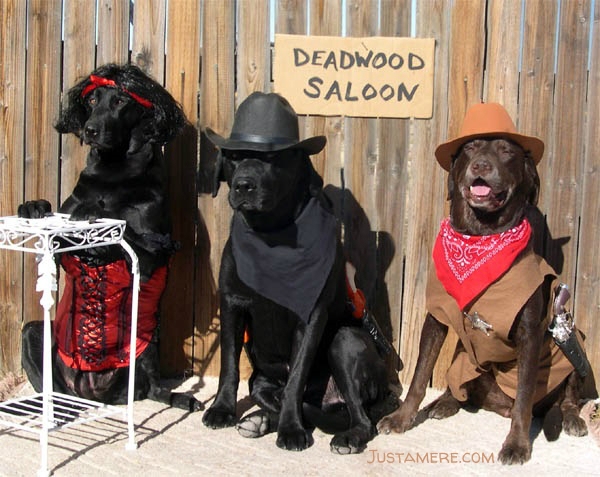
Supplies:
- red bustier
- black wig
- 8″ piece of red ribbon
- a black cowboy hat
- a brown cowboy hat
- two sets of six-guns with belts and holsters
- a sheriff’s badge
- a red bandana
- fabric pieces in black and tan
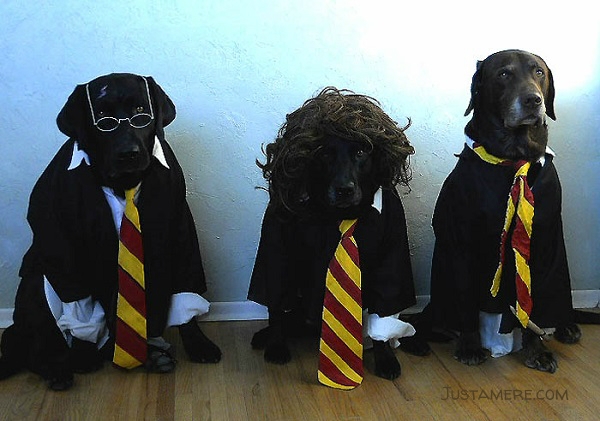
Supplies:
- 3 white shirts
- 3 men’s ties
- red and yellow fabric paint
- black witch’s hat
- 2 pairs of reading glasses
- white chalk
- white paint
- black fabric
You’re a wizard Harry
The next year I decided to show them that dressing up isn’t all that bad. So I joined them.
Another trio – Harry, Hermione and Ron – plus one – Professor McGonagall.
Starting with the ties, I turned them into Gryffindor ties with SEVERAL coats of the red and yellow paint. Notice how one turned out a bit wrinkly? That was Ron’s tie. His shirt didn’t tuck in well either. I also sewed the black fabric into robes for all four of us.
Got us all dressed with white shirts, plus the ties and robes.
Next was sweet talking Tory into wearing glasses and Arwen into wearing the wig again. The glasses didn’t show up well on a black dog, so I took the lenses out and painted the glasses white. Much better!
I added a lightning bolt on Tory’s forehead with white chalk and told them to say ‘cheese’! And, yes, they smiled! They also got to go to the Halloween party and schmooze everyone for tasty treats.
Tip: Start your shopping at local thrift stores. I bought all the shirts and ties for less than $10. The stores will usually also have lots of ready-made costumes for sale.
I’d just as soon kiss a wookiee
The next Halloween became an homage to the Star Wars movies, but which three characters should it be? Darth Vader, of course. And when you have bad, you need good.
Should it be Luke, Leia or Yoda? Costume-wise, Luke was boring and I didn’t want to try hanging cinnamon rolls on my dog’s head, so Yoda was it. And, of course, you need the iconic R2D2.
Next was figuring out which parts of the characters were needed for people to recognize the costumes: Yoda’s ears and light saber, Darth’s light saber, cape, chest plate and helmet (well, most of it because the mask wouldn’t fit) and R2D2’s shape and coloring.
Do you have any idea how long it takes to paint a bowl and fabric to look like R2D2? And that was just the start.
Darth’s helmet and Yoda’s ears both took several fittings, plenty of sewing and LOTS of interfacing to make them stiff enough to look right.
Then more sewing to make Yoda’s robe plus painting Darth’s chest plate and two light sabres.
Luckily last year’s Gryffindor robe worked great for Darth too.
It was worth it though because this was one of the most popular sets of costumes. They were dubbed R2-Dog2, Dog Vader and Yo Dawg.
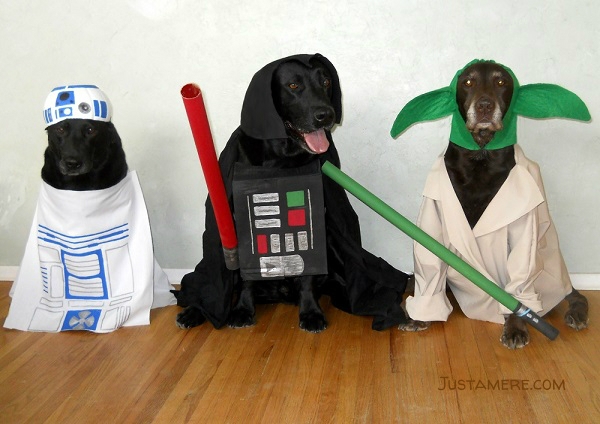
Supplies:
- a white, plastic bowl
- white fabric
- acrylic paint in white,blue, green, red, silver and black
- a cardboard box about the size of a ream of copy paper
- fabric pieces in black, green and light tan
- fusible interfacing
- two cardboard cores from Christmas wrapping paper

Supplies:
- silver acrylic paint
- black fabric (I repurposed the Gryffindor robes)
- white shirts (I repurposed the shirts too)
- 3 black hats with broad brims
- red satin fabric
All of us has an El Guapo to face
If you can’t tell, I choose characters that are usually a bit over the top to make interesting costumes. So it should be no surprise that Chevy Chase, Martin Short and Steve Martin made an appearance on the next Halloween as the Three Amigos!
With a lot of patience and some silver paint, the Gryffindor robes became sparkly jackets. The white shirts were reused. I also painted the hats. Then a bit of sewing turned the red fabric into ties and cumberbunds.
It’s amazing how detailed the real costumes were and I tried hard to replicate the look.
I think Arwen finally liked her costume.
Down the rabbit hole
Liking her costume was short-lived. The next year I put Arwen in a pink Cheshire cat costume and had her lay down on a bench. If looks could kill…
For the hat, I glued green construction paper into a tube shape with the top wider than the bottom. The bottom needed to be about the width of the dog’s head. I cut two circles – one for the brim and one for the top. The brim should be about 2-3 inches wider than the bottom of the tube. I cut the top piece a little big and cut off the excess after it was glued to the tube.
To finish the hat, I added some green ribbon around the base of the hat. I made a card with “10/6” written on it and tucked the card in the band. Thin black elastic under his chin kept the hat in place.
Adding a wig, jacket and green tie completed the Mad Hatter’s costume.
Making a White Rabbit costume required some creativity. I nixed the idea of painting my black Lab white and instead used features to hint at his identity. I made rabbit ears out of white and black construction paper with light gauge wire glued inside. The wire made the ears bendable and also attached the ears to a plastic headband. Next I repurposed a tie from the Three Amigos costume and added a matching jacket. The white rabbit’s large pocket watch was made by painting a whipped topping container lid.
There was a fourth player too, but it wasn’t me this year. In the story, there is a Dormouse who pops out of a teapot. I tried James the rat as a stand-in, but he never got his cue right.
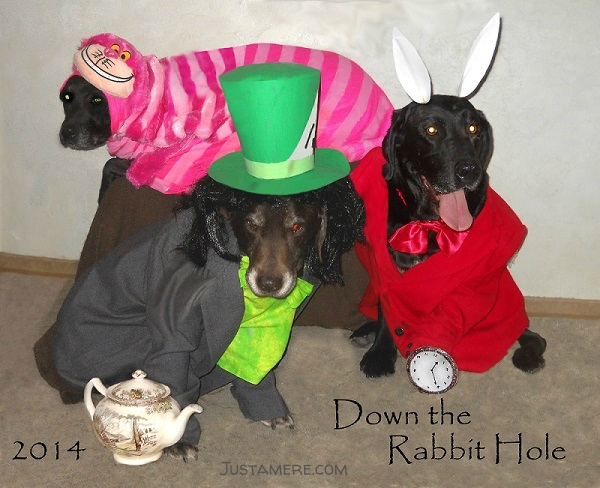
Supplies:
- Cheshire cat costume from a yard sale
- 2 jackets repurposed from my closet
- red tie remade from the Three Amigos costumes
- white, black, and green construction paper for the hat and ears
- acrylic paint in white, black, gold
- black Sharpie-type pen
- about 12 inches of 1 inch wide green ribbon for hat band
- thin piece of elastic for the hat
- a small piece of green fabric for the tie
- wig
- about 36 inches of light-gauge wire for rabbit ears
- plastic headband for the ears
- plastic lid from a whipped topping container
- teapot
- hot glue and glue gun
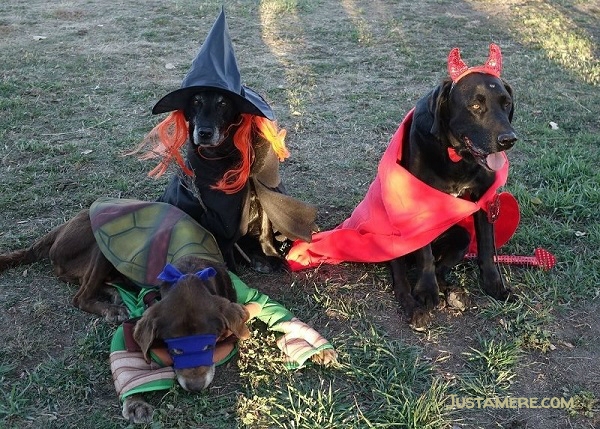
Kids costumes for dogs
By Halloween 2015 we were winding down. Chip was nearly 17 and slept a lot. Tory had been diagnosed with cancer. And I was heart sick. I felt I needed to do one more Halloween photo, but it would have to be simple.
Off to the store again where I found some ready-made costumes – a devil, a witch and a ninja turtle.
I lost Tory just a few days later and Chip in December.
Easy to make deer costume
Although 13 years old, Arwen was still willing so back to the store I went. For her first solo, she was a deer. A trophy deer.
I cut a big piece of cardboard into a shield shape with a hole in the middle just big enough for her head. Then I added some ‘wood grain’ with a Sharpie.
Next I cut the felt into some oval shapes with the brown felt pieces slightly larger. For a Labrador these pieces were about 8 inches long and 3-4 inches wide. I layered the tan inside the brown felt then rolled and glued one end to make an ear. I repeated the process to make the other ear.
Using some wire, I attached the ears and some twigs to the headband. To introduce her to the cardboard, I let her sniff it and then put it on her head. Note: the cardboard only went over her face. I made the hole small enough so the cardboard would not slip over her ears and down her neck.
With a little persuasion, Arwen sat with this contraption on her head while I took pictures.
Isn’t she cute?
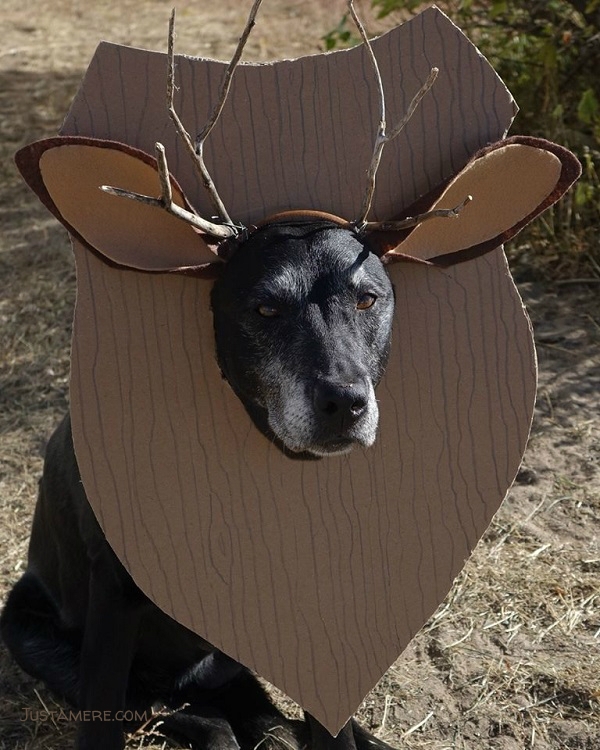
Supplies:
- large piece of sturdy cardboard
- Sharpie pen
- brown and tan felt
- girl’s plastic headband
- light gauge wire
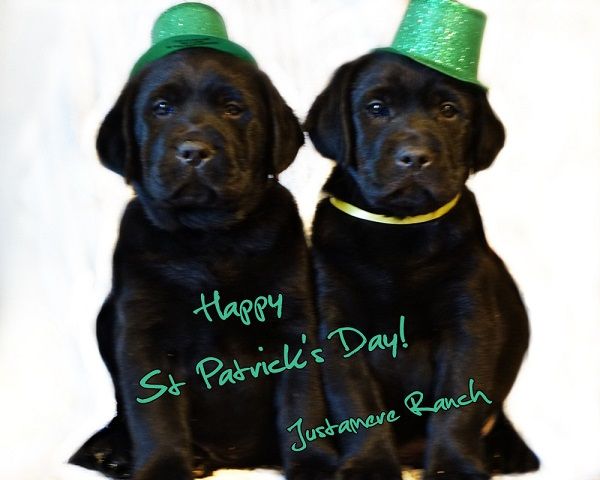
Supplies:
- small party hats
- thin black elastic
- a friend willing to help
Simple costume for St Paddy’s day
After eleven years of Halloween costumes, it was a time of change. More dogs went to the Bridge, but eventually young dogs “volunteered” to carry on the tradition.
In the spring of 2018 I had a litter of puppies who were ready for their 7-week evaluations. A good friend came over, we evaluated puppies, took lots of pictures and decided to give costuming another try.
I already had a bag of small, sparkly green party favor hats. After poking small holes on each side of the hats, I threaded thin black elastic to help hold them on the puppies’ heads. Luckily the puppies had run off some energy, but weren’t quite ready for a nap. Perfect!
We put two puppies on a table as my friend stood to the side to hold them still. Checking the pictures afterward, we saw the background was just too busy. Bless her heart! She let me throw a white blanket over her head while she stood behind the puppies, keeping one hand on each puppy’s hip.
It took a little Photoshopping to blur the background and add a St. Patrick’s Day wish, but the final photo was worth the effort!
Which witch is which?
In 2019 I was finally ready to try Halloween costumes again. Tisket and Wynk were both obedience trained, so although skeptical, they were willing to sit as I fussed.
For the hats, I rolled some black construction paper into cones with glue to hold it. Then I cut a couple donut shapes for the brims and glued those to the base of the cones. After adding some black elastic to keep the hats in place, they were done. But they were kinda boring. Hmmm. Hot glue gun to the rescue! I added several stripes of glue to the cones and brim to give the hats a little sparkle.
The broomsticks were fairly easy, although a bit messy. I wound raffia into two bundles about 10 inches long and wrapped rubber bands near one end. After sticking the dowels into that end, I cut apart the other end and skrunched until it looked right. To hide the rubber bands, I wrapped some raffia over them and tacked it in place with hot glue.
To solve the problem of no hands to hold the broomsticks, I used more black elastic. I cut two pieces about 8 inches long for each dog. Then tied the ends in a knot that was tight enough to hold the broomstick, but not too tight. I slid them on each dog’s leg and slid the broomstick along the leg and under the elastic.
I hoped to take the photos in front of some small trees that had already lost their leaves, but it was too cold and windy. Back inside, I taped a gray sheet on the wall as a background and started taking pictures. But after checking, I decided the background just wasn’t right.
Photoshop to the rescue. I removed the background and made it transparent. Checking Pixabay images I found a colorful sunset that looked great, added it with a bit of text and my signature. Done!
What do you think of my pretty witches?
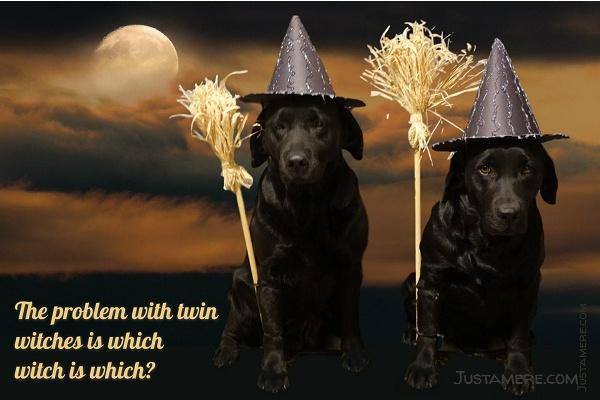
Supplies:
- black construction paper
- thin black elastic
- hot glue gun and glue
- 2-1/2 inch dowels
- raffia ribbon
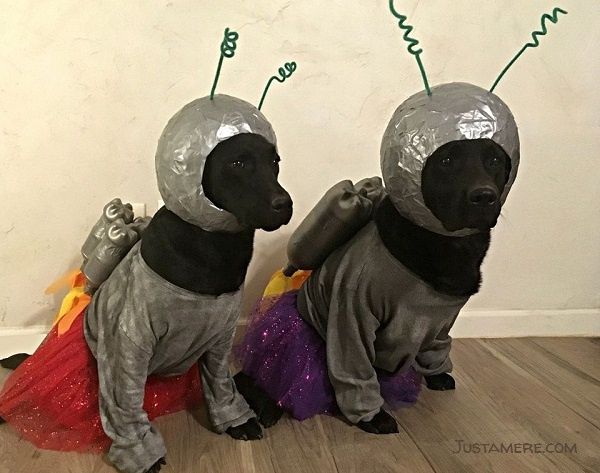
Supplies:
- two stretchy pullover shirts
- yellow and orange tissue paper
- a bag of big pipe cleaners
- a bag of blow up balloons
- lots of duct tape
- several empty soda bottles
- gray spray paint
- about 6 inches of Velcro
- two really cute tutus in sparkly red and purple
Fun space cadets costumes
I had an idea I wanted to try for Halloween, but it’s a good thing I started early.
First task was testing the concept. I blew up a round balloon and covered it with criss-crossing duct tape, leaving a large hole on one side. It took a LOT of tape. When I thought it had enough tape to hold it’s shape, I popped the balloon. Nope, it needed more tape.
But before adding more tape, I decided to test fit it. Splash was willing, but thought I was certifiable. I made a few modifications and continued adding tape. I also added pipe cleaner antennas. Then duplicated the process for Sketch’s helmet.
Next were the power packs. I had a few plastic soda bottles and painted them silver. While I was at it, I also painted both stretchy shirts. When the bottles were dry, I taped them together. I added Velcro to the bottles and backs of the shirts. Then I added some tissue paper to the ends of the bottles to simulate flames.
Now the test. Would they wear all this stuff AND sit still? Obedience training sure helps, but it was hilarious watching them step on the tutus.
Introducing Space Cadets Sketch and Splash from the Department of Intergalactic Security and Information (DIS-Info.com) ready for service.
By the way, their great grandmama Arwen would be proud!
Christmas party costumes
For Christmas 2020, Sketch, Splash and Wynk got their party on!
Starting with the easy outfit, I added a piece of black elastic to the Santa hat to hold it on. After test fitting, I also added a stitch to hold the pompom in the right place.
Next up was Sketch’s Christmas tree. I cut two pieces of the green felt into a Christmas tree shape. Using an old clothes hanger, I cut and shaped it into an upside down V shape. With the hanger ends sticking out of the bottom about an inch, I hot glued the hanger to the felt. I bent the ends and left them long for support at the back of the tree. Then I glued the front and back together and to the hanger. I added some small decorations. It did take a bit of tweaking to keep the tree from falling over.
Splash’s antlers were made similarly to the tree. I made the red nose from a circle of red felt stuffed with cotton balls. It weighed nothing, but Splash thought she should hold it in her mouth instead of balancing it on her nose. Tiny black elastic to the rescue.
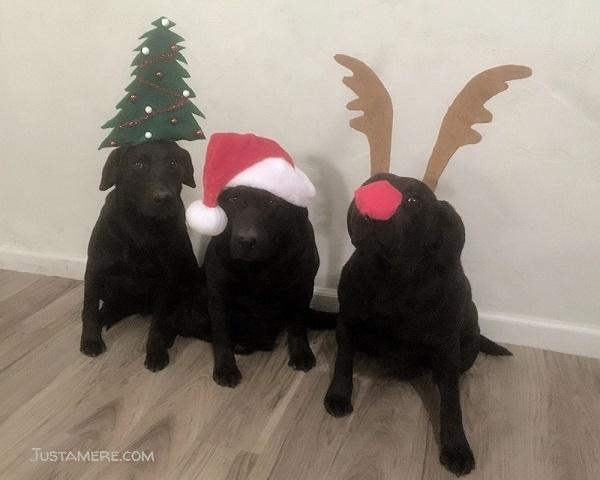
Supplies:
- Santa hat
- green, tan and red felt
- 2 plastic headbands
- tiny Christmas decorations
- glue gun and glue sticks
- thin black elastic
- a couple of old wire hangers
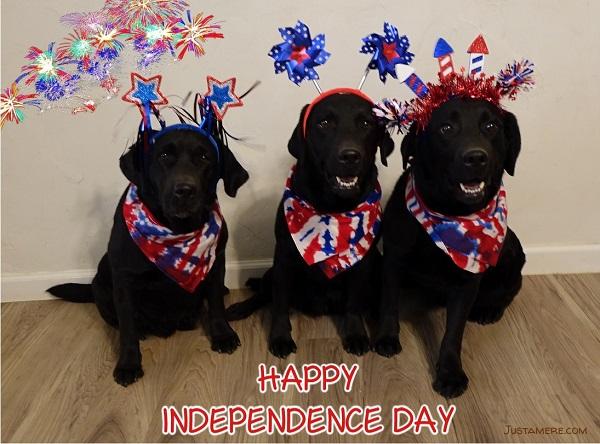
Supplies:
- 3 red, white and blue bandanas
- 3 decorative headbands
- fireworks sticker
Super simple costumes for July 4th
Costumes for Independence Day celebrations were a snap! Bandanas, decorated headbands and a small fireworks sticker for the wall was all it took.
Wynk, Sketch and Splash really got in the spirit this time!
Inexpensive skeleton for Halloween
This Halloween was supposed to be two canine skeletons. Alas, there was only time enough for one.
I tried white chalk, but it didn’t cover well enough on a black dog. Instead I used nearly a bottle of white acrylic paint. It took quite awhile to paint and Splash needed several breaks. She was carefully supervised so she didn’t spread the paint around the house.
Even a first year veterinary student would probably laugh at the bone placement, but I think she turned out cute. Especially when Splash thought she saw a “ghost” popping out from behind the couch.
Splash got to model her costume for another day, then needed a bath to look like herself again.
Tip: Try colored chalk or paint if your dog isn’t black.
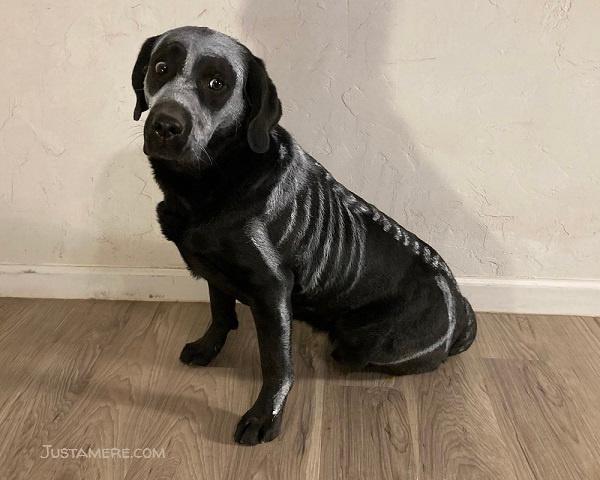
Supplies:
- white chalk or acrylic (washable) paint
- dog skeleton image for reference
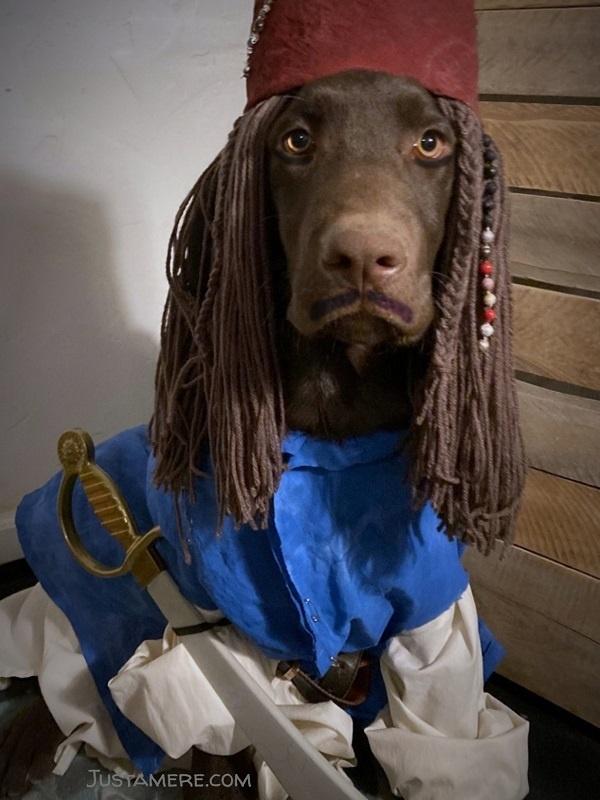
Supplies:
- blue acrylic paint
- skein of brown yarn
- 2 small strings of craft beads
- red bandana
- pieces of fabric on sale
- toy sword
Drink up me hearties, yo ho!
Halloween 2022 brought a new player to the lineup. This is 5-month old Boo, a chocolate Lab. I think he was born for the limelight!
To prepare, I looked through many images to help me decide what to get to capture the essence of Cap’n Jack Sparrow.
After loading up on supplies, the first task was cutting and gluing the fabric into a vest shape. It needed a color boost and a bit of blue craft paint worked just fine.
Next was cutting yarn into 24 inch pieces, folding them in half and gluing together into clumps. I also braided a couple pieces of yarn.
In the movies, Cap’n Jack often wears a dirty red bandana around his head. However the difference in anatomy between people and dogs presented a bit of a problem. To solve it, I first tied the bandana like it was on a person’s head. Next I glued all the yarn clumps, plus the braid and a string of beads to the inside of the bandana. I also added a string of beads to the top of the bandana.
It wound up looking like a fez, but at least it didn’t need elastic to stay put.
Next we had some rehearsals.
Wear the hat and wig while sitting? Check.
Wear the blue vest and a white shirt while sitting? Check.
Wear all of it plus the sword while sitting? Check.
Added a smudge of mascara under his eyes and on his lip. AND WE ARE READY!
Boo did a great job as the dashing, yet goofy, Cap’n Jack.
My what big teeth you have!
Boo is back; this time with momma Wynk.
I started her costume by cutting a hole big enough for her head in the closed end of the pillow case. Then I folded the corners over and tacked them down to make the shoulders look more realistic. (Note: I realized later this wasn’t necessary as they were covered by the cape.)
Next I pulled the pillow case over her head and marked where I needed holes for her front legs. I started small when cutting the holes and gradually made them bigger. A tape measure might have helped, but this way seemed easier for me.
Then I cut two rectangles out of the black fabric – about 9 inches wide and 15 inches long. They needed to be long enough to cover from her shoulders to her waist. And wide enough to cover from the edge of her chest and around her side. I decided not to take it all the way around her back as that would be covered by the cape.
I also cut four pieces of black fabric about 1/2 inch by 12 inches to criss cross her chest. Black ribbon would also work.
Placing the black rectangles on the front of the pillow case, I left about 7 inches open in the middle. I attached the criss crosses in the middle and the black rectangles on the sides, using the glue gun.
Turning it inside out, I cut the black fabric where it overlapped the leg holes. Time to test fit!
Next up was making the red skirt. I cut the red fabric at 22 inches long and glued the selvages together. Then I turned over about an inch at the top and glued the edge to make a tube. After measuring around her waist, I cut some elastic about 2 inches shorter. I slid the elastic through the tube, pulled it snug and tied it in a knot.
For the cape, I cut the fabric about 40 inches long. After folding it in half, selvage to selvage, I laid it out on the table. I drew a shallow curve along the top edge using some chalk. Next I cut and glued together the cut edges.
For the ribbon, I cut the leftover fabric about 1.5 inches wide and selvage to selvage. I wrapped this around Wynk’s neck and tied a bow to hold the cape on.
Boo’s costume was much easier. First a quick trip to a thrift store for an old-fashioned nightgown and reading glasses. Then I cut about 8 inches off the bottom of the nightgown and slip-stitched the cut edge. I carefully pulled the thread to make a floppy night cap.
As dusk was descending, I took Wynk and Boo out to the edge of the woods. I dressed Wynk first and fluffed up the cape and skirt. Boo’s costume was simple and quick. Snapped a few photos and done!
What costume(s) should we try next year? Use the contact form to let me know your ideas.
Note: Because these costumes probably wouldn’t be used again, I cut corners. I glued seams instead of stitching and left raw edges instead of hemming.
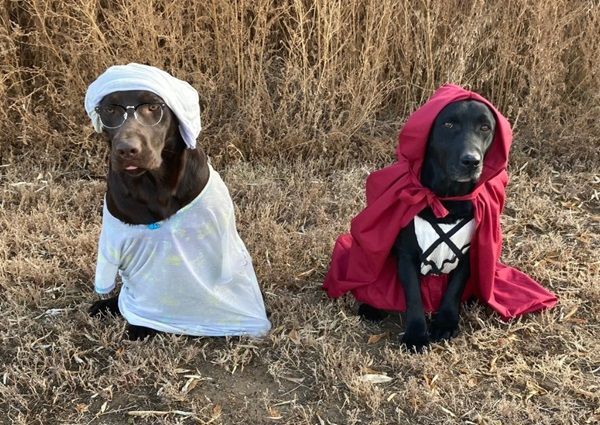
Supplies:
- old, white pillowcase
- black fabric remnant
- 2 yards red fabric
- 24 inches white lace, approximately 2 inches wide
- thread
- thrift store nightgown
- eye glasses
- glue gun and glue
This post was originally published on October 31, 2019. Edited and updated with new content on April 9, 2024.
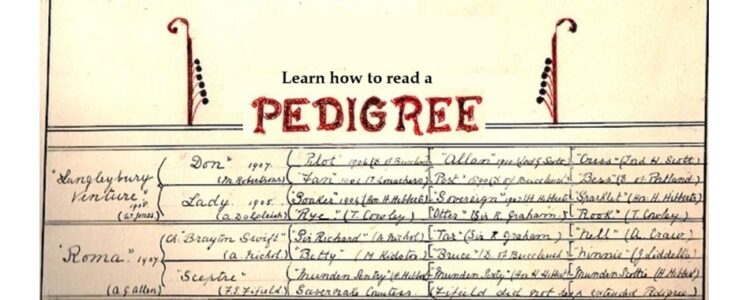
What are dog pedigrees?
Dog pedigrees are essentially family trees. They start with one dog, then his parents, then grandparents, and then great grandparents. It can continue further, but let’s start with just three generations of ancestors.
In other words, it shows the relationship between a dog of one generation and his ancestors.
Here is a simple example of Peter of Faskally’s pedigree. His name is on the left. The two slightly indented names are his parents – Waterdale Gamester and Birkhill Juliet. Indented further are his four grandparents – Spratt, Twinkle, Nith, and Susan. His eight great grandparents are indented even further.
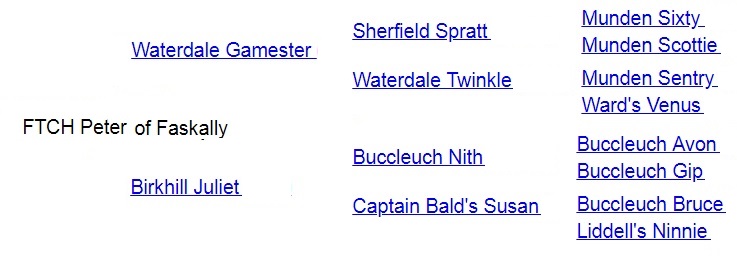
For each pair, the male is on top, the female below. So Waterdale Gamester is Peter’s father and Birkhill Juliet is Peter’s mother.
In the next generation, Sprat is Gamester’s father and Twinkle is Gamester’s mother. Nith is Juliet’s father and Susan is Juliet’s mother.
Sometimes the main dog’s name – in this case, Peter – will be at the top of the pedigree instead of on the left. Often there will also be information about him such as date of birth, color, breeder, and owner.
Most pedigrees only include direct ancestors and not siblings, as it shows in Peter’s pedigree.
Sometimes pedigrees show more generations, but each generation back doubles the number of dogs in the previous generation. It doesn’t take long to become unwieldy.
How to read a pedigree chart
A pedigree chart is another type of pedigree this time based on a grid. The top portion is used for the dog’s information and possibly a small image.
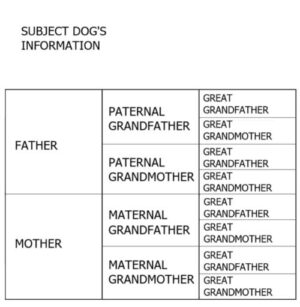
The first column has 2 rows for the parents. The father is always in the top row and the mother in the bottom row. The second column is for the grandparents with the first two rows for the father’s parents and the last two rows for the mother’s parents.
The third column is for the great grandparents and is divided into eight rows. The first two rows are for the paternal grandfather’s parents. The next two rows are for the paternal grandmother’s parents. The final four rows are like above, but are for the mother’s grand parents.
If you have a copy of Microsoft Excel or another spreadsheet program, it’s easy to set up the rows and columns. Then it’s just a matter of filling in the generations. Just refer back to your source documentation to make sure everything is correct
More information in dog pedigrees
Most pedigrees include additional information about the dogs listed. Usually they show each dog’s color and date of birth. Often they show the registration number and titles of each dog. Sometimes they show even more information such as the breeder’s name and sometimes their address.
Some pedigrees will show most dogs’ names in black type and titled dogs in red. AKC abbreviations you might see include:
CH = Show Champion
GCH = Show Grand Champion
FC = Field Champion
MACH = Master Agility Champion
OTCH = Obedience Trial Champion
CDX = Companion Dog Excellent
JH = Junior Hunter
NAJ = Novice Agility Jumper
RE = Rally Excellent
TKN = Novice Trick Dog
Other clubs and organizations, such as the United Kennel Club, Hunting Retriever Club, and Super Retriever Series offer their own titles.
Another pedigree variation
A pedigree analysis chart is another type of pedigree. It’s usually used to study heredity traits and disorders. However it can be used to show descendants of a dog or dogs.
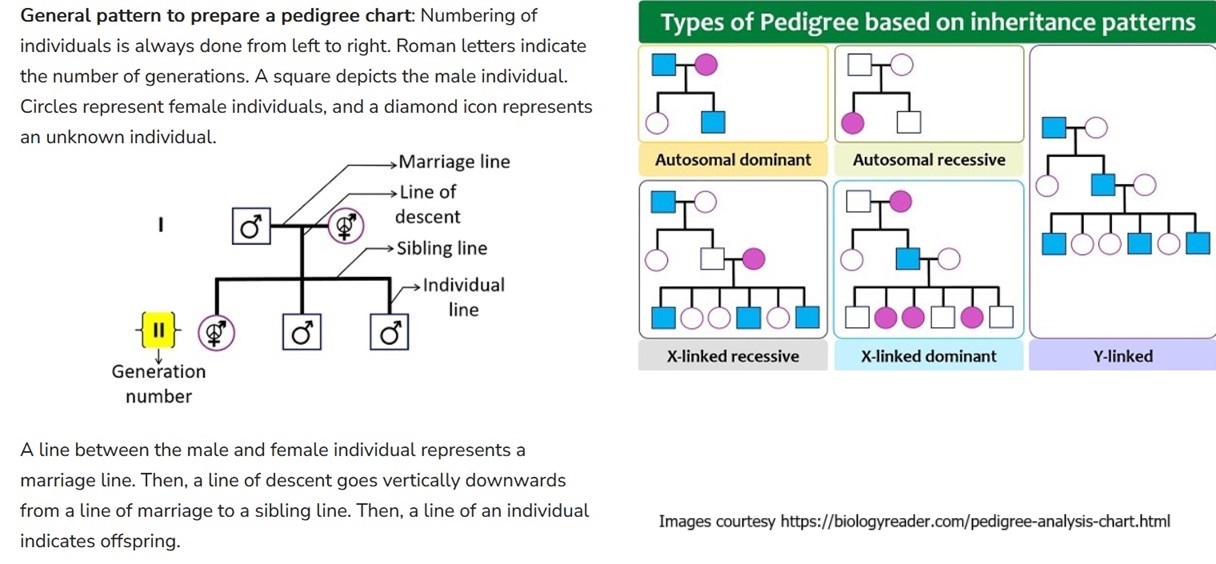
This chart starts with a father and mother and shows their offspring linked downward. Symbols are used including squares for males and circles for females with a line linking a breeding pair.
A horizontal line links the offspring together with a link from the parents joining the horizontal line.
These charts often follow only one line of descent. For example, it will have a breeding pair with their offspring below. The next generation will usually only show the offspring of one son or daughter.
This type of chart is used to track inherited traits. For example, it might track coat color with a black father shown by a black square and a yellow mother shown by a yellow circle. If the father has a hidden yellow gene we’d add a yellow dot in his black square.
Their puppies would be shown linked below the parents. Each would be colored either yellow or black with a yellow dot.
Why add a yellow dot? All the puppies got a yellow gene from the mother. While the puppies got a black gene or a yellow gene from the father. The puppies that got the black gene will be black, but also carry a hidden yellow gene from the mother. Thus the dot.
Let’s take a look at a few more examples
The first example is a page from a pedigree book. It shows five generations with some of the best bloodlines. The dog was bred by Sandylands, a very influential English kennel. He finished his show championship and was a popular stud dog. Several of my dogs descend from him!
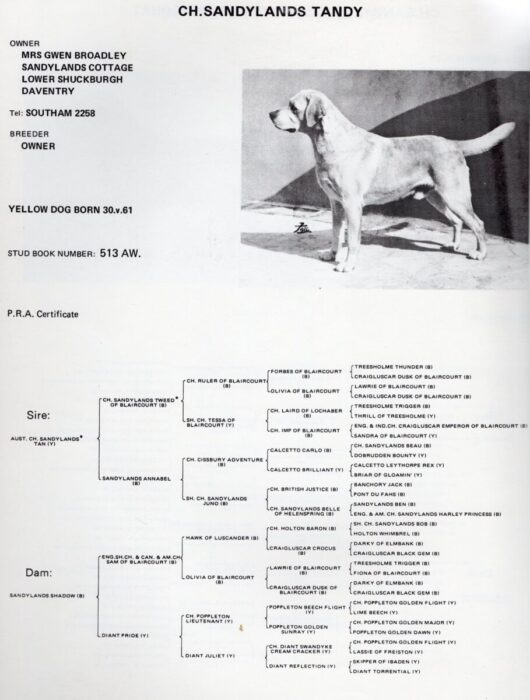
Pitch was another influential dog. She had a dual champion granddaughter and at least two show champion kids. She’s also line-bred on some very influential dogs. See if you can find the brothers in her pedigree. And, yes, she’s in the pedigrees of several of my Labs.

Now that you know how to read a pedigree, you can create a pedigree for your dog. Or you can buy one at AKC if your dog is a registered purebred.
Another option is listing your Labrador on Hunting Lab Pedigree. You’ll need to create a free account before you can add your dog.
If you’d like to include your dog’s pedigree on your website, check out this article about creating a 3-generation pedigree for your website. It’s free, and it’s not branded by the author.
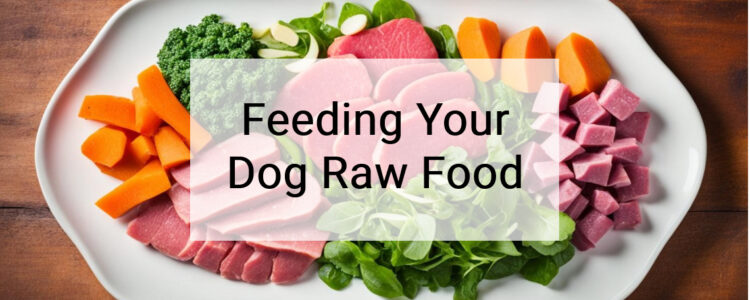
You love your dog, right? And you probably want to feed him the best food.
Looking at his teeth you can see he’s a carnivore with teeth made to rip chunks of meat. That’s very different from horse teeth that are meant to grind their food. So why feed kibble that needs more grinding than ripping?
Read on to learn more about feeding raw food.
What is a raw food diet for dogs?
This diet for dogs includes meat, organs, raw bones, and fresh produce. These foods are not cooked and don’t have any additives or preservatives. The idea is to provide a more biologically appropriate diet than dry dog food.
Why should I feed my dog raw food?
For thousands of years dogs and their ancestors hunted and ate the meat raw. When they first joined our households, they ate scraps.
Now many dogs eat commercial food which is usually kibble or canned. Those foods are often cooked which destroys some nutrients. Pet food manufacturers try to add back what was destroyed, but synthetic isn’t always as good as natural ingredients.
As an example, cats developed health problems and died when fed commercial food. Although taurine is abundant in raw meat, they didn’t know it was essential until recently.
It’s only in the last 80 years or so that people started feeding dogs commercial foods. It’s not a coincidence that dogs started developing cancer, heart disease, and allergies just like people who eat processed foods.
What are the health benefits of raw food for dogs?
Feeding raw food helps with digestion and skin health, making it a top choice for dog owners.
Raw meat is easier for dogs to digest which means better nutrient absorption and less waste. You’ll notice firmer poop and fewer tummy troubles.
A raw diet is full of fatty acids and other nutrients that make skin and fur healthy.
There aren’t harmful additives such as BHA that’s often added to store-bought dog food.
| Benefits of Feeding Raw Food | Potential Drawbacks of Raw Feeding |
|---|---|
| Closer to a dog’s natural diet | Requires a bit more thought and effort than pouring kibble in a bowl |
| Nutrient-dense so he needs less and there’s less you-know-what to pick up in your yard | Handling raw meat comes with safety considerations |
| Feeding a variety of meat sources can lead to fewer allergies | Potential for unbalanced nutritional intake |
| Healthier skin and coat | Preparation time and storage requirements |
Is a raw food diet complete and balanced?
If you give your dog a variety of raw, meaty bones (“RMB”) you will have a balance over time. Except for the raw part, that’s pretty much how we eat.
Because chicken is widely available and fairly inexpensive, many people feed mostly chicken. However you should feed as wide a variety of foods as your dog will eat (and your wallet can handle).
For example:
- chicken backs, necks and quarters,
- rabbit parts,
- turkey necks,
- pork necks,
- beef ribs, heart, liver, tongue,
- eggs (whole, including the shell).
My friends have also given me goat, fish, deer, elk, and buffalo meat.
I have several Labs so I often buy in bulk at a restaurant supply business. Sometimes their stock varies, but I usually buy ground turkey, chicken quarters, and beef heart. That’s about 60-80 pounds of meat.
When I have puppies I’ll usually start them on gruel which is kibble soaked in about 50/50 goat’s milk and water. Then they’ll graduate to ground up chicken wings, and finally to intact wings. When you see them snatch the wings you’ll realize how high they value raw food.
Again, if you feed anything with bones it must not be cooked.
And I also feed fruit and vegetables, but they’re not a big part of my dogs’ diet. For things they like – apples, avocado, carrots, celery (but not bananas, for some reason) – I chop into bite-size pieces. Other things like spinach and cauliflower get chopped up in the grinder and mixed with ground meat.
Won’t raw food make my dog sick?
Dogs and their ancestors ate a raw food diet for thousands of years. It’s only after they started eating commercial dog food that health issues increased.
For example, in 2007, hundreds of pets died of kidney failure after eating kibble contaminated with melamine and cyanuric acid. Melamine is a compound used to make Formica, plastic dinnerware, insulation, cleaning products, and dry erase boards. The contamination was traced to companies in China that make animal feed. These companies reportedly added the chemicals to “give the false appearance of a higher level of protein.”
Shouldn’t I cook the meat?
No, and there are several reasons not to cook it. First, dogs evolved to eat raw meat. Second, cooking causes bones to become brittle and dangerous. Never feed cooked bones to your dog. Third, cooking will destroy enzymes and anti-oxidants essential to your dog’s health.
In the 1930s, Francis Pottenger M.D. did an experiment with cats. He fed one group of cats a raw food diet and a different group a cooked diet.
The cats eating the cooked diet developed problems such as tooth loss, deformities, behavioral problems, paralysis, heart lesions, and arthritis. Mother cats had more miscarriages and some died giving birth.
Fortunately when they were later fed a raw food diet, many were restored to health.
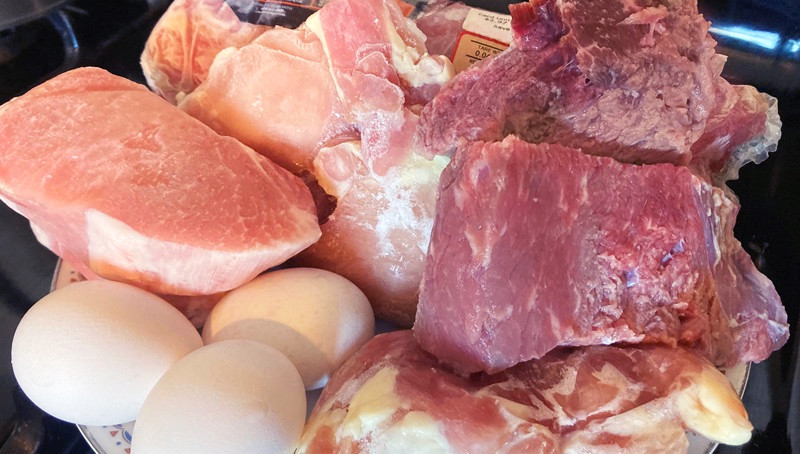
Can’t my dog choke on a bone?
Yes, dogs can (and have) choked on many things including bones, kibble, tennis balls, sticks, and socks. Dogs can also break their teeth on bones. Therefore you should feed raw bones of a manageable size, including poultry, rabbits, and non-weight bearing bones of larger animals.
Make sure the pieces are large enough so that your dog has to tear and chew rather than gulping. Gulping can cause choking. One of my dogs tried to swallow a chicken quarter whole. From then on he got to chew on the thigh while I held the end of the drumstick.
If you’re worried about feeding bones you can still get some benefits of a raw food diet by feeding ground meat. Although that’s fine for an occasional meal, your dog also needs the additional nutrients found in bones. You can add ground up bones or bone meal to balance nutrition. Check with your veterinarian for advice.
Another option is buying a raw diet, ground and specially prepared for dogs. You can find these in pet stores and some grocery stores. However there are two downsides: less knowledge about the ingredients and the cost.
Are there risks feeding raw meat?
Raw meat can carry harmful germs like salmonella or listeria. These could make your dog, you, and your family sick.
Try to buy meat from a butcher or high-quality supplier. Wash your hands and surfaces before and after handling raw meat.
Pork has a reputation that it must be cooked well-done because of a parasite that could be in the meat.
According to WebMD, “Eating raw or under-cooked pork can also result in trichinosis, an infection of parasitic roundworms called Trichinella. While trichinosis symptoms are usually mild, they can become serious — even fatal — especially in older adults.”
However, according to the CDC, “… meat contaminated with the Trichinella larvae comes from meat-eating animals such as bear, wild boar, or walrus.” (Note: I don’t feed meat from meat-eating animals.) They go on to say it “is a rare disease in the United States, with only about 15 confirmed cases per year.”
I do feed pork but I freeze it for 20 days at 5°F (-15°C) to kill any worms.
Can you give me some recipes?
Just give your dog a variety of raw, meaty bones as the main course. Chicken, beef, pork, and turkey are often easiest to find, but also look for rabbit, goat, and other species.
Add some heart or liver, plus a little boneless meat, and maybe some mashed up vegetables.
You can also add some eggs (including the raw shell), some fish (whole, if possible), and perhaps some yogurt (with active cultures).
When you’re starting out, plan a week’s worth of meals. If you feed twice a day choose nine meals of RMBs, two meals of muscle meat, and three veggie meals.
If you look in the ‘fridge and there are only packages of muscle meat when you’re supposed to be feeding an RMB, don’t worry. Give an extra meal of RMBs and relax. Your dog won’t care. Just remember you’re striving for balance over time.
By the way, you can make your own treats in addition to raw goodies. Check out these recipes for healthy dog cookies.
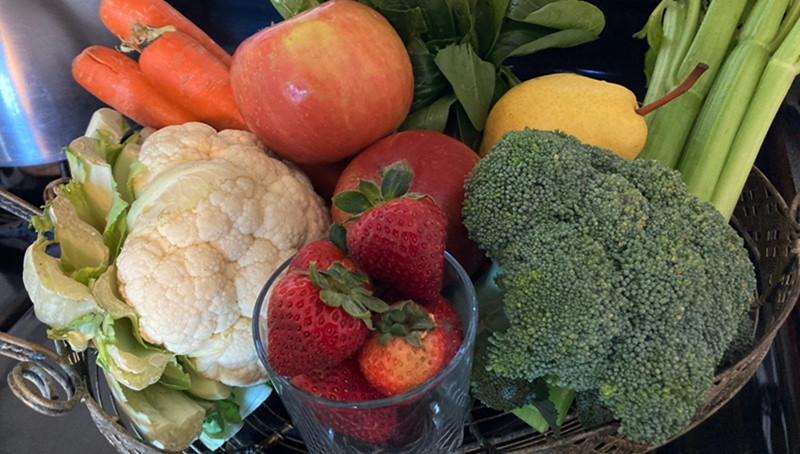
Transitioning to raw food
It’s best to start simply: one type of RMB for the first week or two. Don’t add any supplements or try different RMBs for awhile. It might take your dog a little time to adjust to this new food.
Some dogs do best on a cold turkey switch rather than half-kibble and half-raw, others may need to be eased into a raw food diet.
Keep it bland in the beginning. You might start with chicken or turkey and feed wings, necks or backs for the first few days. Some dogs may take a little while to adjust, and you may see some diarrhea. If so, you can try adding some canned pumpkin (not the pie filling) or increase the percentage of bone.
You might see a little vomiting. Sometimes it’s bits of bone that he couldn’t digest, other times it’s a yellow foam that means his stomach is empty. Raw meat usually digests faster than kibble, so you may need to feed more often.
Starting out, you might add some yogurt with active cultures or some digestive enzymes to help his digestive system. I use Dynamite’s DynaPro. It’s a pre- and probiotic and only takes a few drops to a small squirt. (Note: If you buy it after clicking on this link, I’ll earn a small commission.)
As your dog adjusts, add another type of RMB (not just a different body part, but a different species). Feed just those two meats for several days or more until your dog seems comfortable with his new diet.
Then gradually try different foods. See what your dog likes. Some love fish, some hate it. Some love veggies, some won’t touch it.
Wait to add richer foods like liver or heart until your dog is handling the basic raw diet.
How much should I feed my dog?
As a starting point dogs should eat about two to three percent of their ideal adult weight.
First you need to find out how much he weighs. Drop in at your vet’s office if he’s too big for your home scale. Then multiply by two percent and again by three percent. For a 70 pound Labrador, that would be about 1.5-2 pounds of food.
Depending his activity level and body score, you may need to adjust the amount you feed.
Puppies should also receive about 2 to 3 percent – not of their current weight – but of their ideal adult weight.
And don’t worry about giving your dog the same exact amount every day. Just keep the amount close to the two to three percent of his weight. Bump it up a bit if he starts looking thin or cut back a little if he’s getting pudgy.
Tips for switching to raw food
Switch slowly so your dog’s stomach can get used to the new food.
How much food your dog needs depends on their size and health needs.
Be sure to talk to your vet about any problems your dog might have with raw food.
To supplement or not?
Feed a variety of raw meaty bones, some muscle meat, and a bit of organ meat and you probably won’t need to supplement.
However commercially-raised animals might not be as nutritious as wild animal meat. To balance it out you can supplement with salmon or fish-body oils that contain high amounts of Omega-3.
By being careful you can give your dog the benefits of raw food. And I bet he’d love the change!
Now that you know what food to feed your dog, maybe you’d like to know what NOT to feed him.
NOTE: The information on this website is not intended to replace your veterinarian’s advice. This information is intended to provide non-technical information in an easy-to-understand format. The website author accepts no responsibility or liability for how this information may be interpreted or construed, or any actions that might be taken as a result of the information herein.
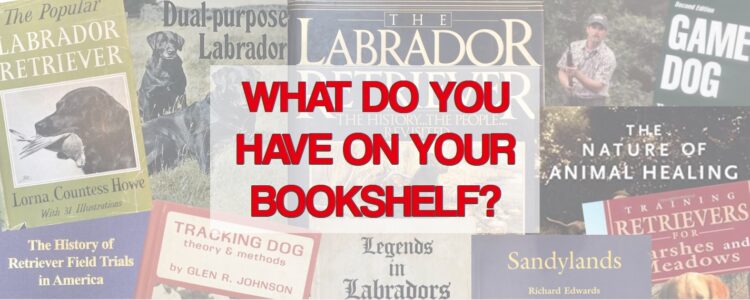
I was dusting my shelves and noticed I have a LOT of books about dogs in general and Labradors in particular. My library isn’t limited to Labs, but also includes books on other breeds, plus books on training, care, and breeding. Here’s a list to help you decide what books you need in your library.
Labrador history
The Labrador Dog – Its Home and History (1936)
– Lord George Scott and Sir John Middleton
This is one of my favorite books! It was written by Lord George Scott, brother of the 7th Duke of Buccleuch, and Sir John Middleton, the former Governor of Newfoundland. Lots of early history! Although the book’s cover isn’t in great shape, the interior is well preserved. Even the fold-out pedigrees on tissue paper are intact.
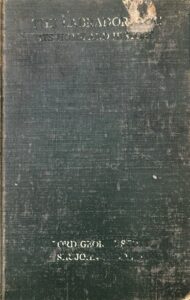
The Popular Labrador Retriever
– Lorna, Countess Howe
It’s a typical dog book, but having been written by one of the greatest proponents of the breed makes it special. She knew many of the early breeders and their dogs, often buying the best dogs she found. She wrote of the founding of the breed, the early dogs and their breeders. A story she included was about Lord Knutsford (then the Hon. Arthur Holland-Hibbert). He wanted to import a dog to add to his Munden strain and asked a friend for help. His friend didn’t find a dog, but was told “You will get a better one nearer home from a young fellow called Holland-Hibbert who lives at Munden, Hertfordshire.”
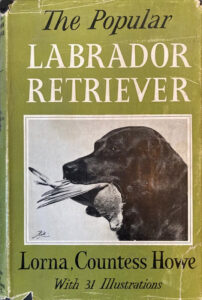
The Labrador Retriever – The History, The People
– Richard A Wolters
A comprehensive book about the Labrador Retriever. It starts with a detailed dive into the beginning of the breed based on the author’s review of early sources. He explains what sources he used and how they fit together, but it’s still like a jigsaw puzzle with some pieces missing. He continues onward discussing the Lab’s journey to England and Scotland, plus the times the breed nearly ended. Then the export to the US and breeders such as Jay Carlisle of Wingan put Labs on the path to popularity.
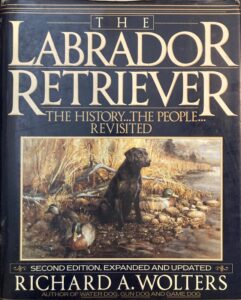
Other Labrador Retriever topics
The Dual-Purpose Labrador
– Mary Roslin-Williams
This book was published in 1969 by a woman who knew Labradors. Any book by MRW is worth reading and this one doesn’t disappoint. If you can find a copy available, snap it up. Then be sure to read the chapters on Type and Conformation. You may also want to listen to one of her lectures as well.
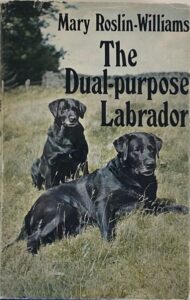
Reaching for the Stars
– Mary Roslin-Williams
Previously titled Advanced Labrador Breeding, this book is all about breeding. She discusses successful breeders and the qualities that make a good breeder. The part I found most interesting was her description of the stages a breeder goes through.
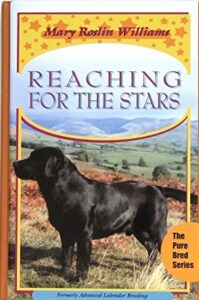
Legends in Labradors
– Nancy Martin
The author visited many important breeders, both in the UK and the US, and wrote a series of profiles. Included are Sandringham, Banchory, Ballyduff, Blaircourt, Cornlands, Hiwood, Knaith, Mansergh, Sandylands, and more from the UK. Plus Arden, Chidley, Deercreek, Earlsmoor, Franklin, Lockerbie, Nilo, Whygin, Wingan, and others from the US. The profiles aren’t long or in depth, but they give you a taste of why these kennels were so important.
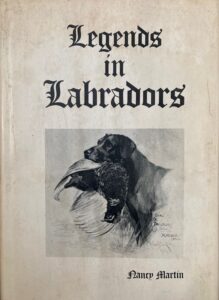
The Book of the Labrador Retriever
– Anna K. Nicholas
Starts by discussing the origins and standards of the breed, and provides advice on caring for, showing, and obedience training Labradors. But what sets it apart from many breed books is the information on kennels in the US and Canada. Kennels included Beechcroft, Broad Reach, Campbellcroft, Chidley, Finchfield, Franklin, Killingworth, Kimvalley, Lockerbie, Mandigo, Rupert, Scrimshaw, Shamrock Acres, Simerdown, and Whygin.
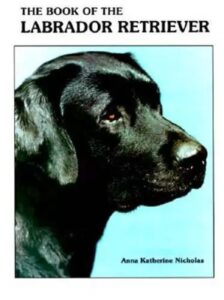
The Official Book of the Labrador Retriever
– Labrador Retriever Club Inc
Another comprehensive book about Labradors, although not so deep as Richard Wolters’ book, The Labrador Retriever. It has a section on history of the breed, but more interesting are the pedigrees and photos of Labs. Many of the highlighted bloodlines are from Europe and especially England and Scotland.
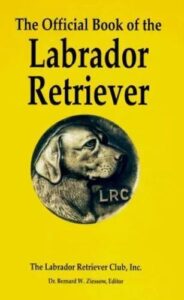
The Complete Labrador Retriever
– Helen Warwick
A lovely book that lives up to its name. If you want to learn about Labrador Retrievers – albeit at a high level rather than a deep dive – this is the book for you. Mrs. Warwick does a good job condensing the Lab’s history and yet keeping it readable. Other chapters discuss yellows and chocolates, Labs in other countries, showing, and breeding.
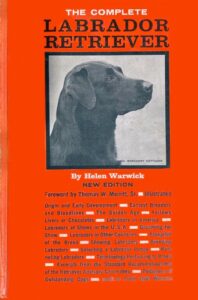
The Ultimate Labrador Retriever
– Heather Wiles-Fone
This is a large book with each chapter penned by an authority on that topic. Learn about Lab history, raising a puppy, training, showing, breeding, health, and more. And each chapter is complete enough to be its own book.
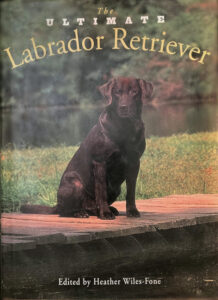
Sandylands
– Richard Edwards
A very in depth book about the Sandyland dogs – mostly Labradors, but also some other breeds. Follow along as Labs twine through Gwen Broadley’s life, from Juno through Tandy, Tweed, Mark, and many others. If you have any questions, the author is active on Facebook. And he also wrote a chapter in The Ultimate Labrador Retriever as did Marjorie Satterthwaite.
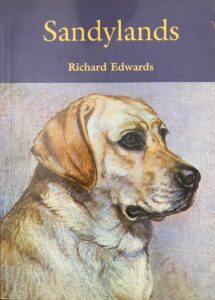
The Retriever Owner’s Encyclopedia
– Gwen Broadley
I stumbled upon this book recently and bought it because the author bred so many wonderful dogs under the Sandylands name. The book is more of a dictionary of dog terms, some simple and other lesser known terms such as haw, eclampsia, and timber. What I liked best was the sprinkling of photos including Sandylands Tweed of Blaircourt, Sandylands Tandy, Lockerbie Kismet, Knaith Banjo, and Reanacre Mallurd Thunder retrieving a fox. Although most of the photos are of Labs, there are also some of Goldens, Flatcoats, and Curly Coated dogs too.
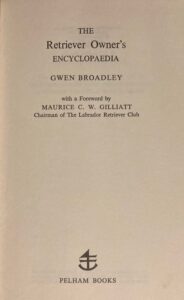
The Labrador Retriever
– David D Elliot
Numbered edition, mine is #18
A little book with basic Labrador care instructions, but what sets it apart are the number of photos of dogs from the Wingan kennel. Mr. Carlisle did an awesome job importing and breeding the best Labs. He was also very giving with his time to help other breeders. When he died he left his dogs to his trainer, David Elliot.
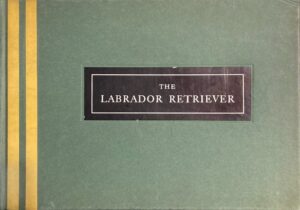
Life Magazine, Issue December 12, 1936
This issue included an article about Blind of Arden with an arresting photo of him on the cover. The article talked about his win at the “No. 1 U.S. Retriever Test” and included several photos. At that time, Labs were still new to the US.
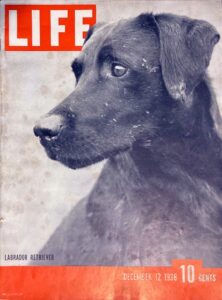
A Dog Owner’s Guide to Labrador Retrievers
– Marjorie Satterthwaite
This is a nice little introduction to Labs book, but I bought it for sentimental reasons. I met and talked with Mrs. Satterthwaite at the 2004 LRC National Specialty. She said some nice things as she went over my dog, even though we both knew Arwen wasn’t a show dog. We talked again at the hunt test when I gave her a photo of her judging my friend’s dog the day before. She passed away just a few years later.

Health
The Nature of Animal Healing
– Dr. Martin Goldstein
I got to meet Dr. Marty when he was on his book tour. He’s such an inspiration! In his book he gives several ways to help your dog live longer and healthier. If you want to jump right into raw feeding, he tells you how to do it. Not quite ready to go all the way? He has tips to ease into it. I eased in because it’s hard to give your dog raw meat – bone and all – and wonder if it’s safe. But they loved it and I got over being fearful (mostly). I also think it helped my chocolate Lab live to 17 years old.
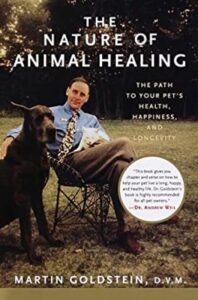
Keep Your Dog Healthy the Natural Way
– Pat Lazarus
This book is similar in many ways to The Nature of Animal Healing. It talks about feeding a natural diet and gives variations for females in whelp and another for puppies. Plus it explains why a natural diet is better. It also covers alternatives to vaccinations and the benefits of alternative medicine such as chiropractic, acupuncture and homeopathy.
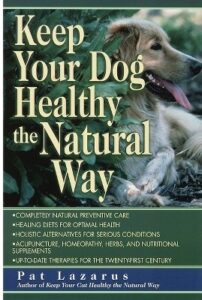
Field training and history
History of Retriever Field Trials in America
– Fred Kampo and Carolyn McCreesh
A signed, limited edition book that looks great on the coffee table. More than that it provides a detailed glimpse into the start of field trialing in the US. It includes information about the dogs’ performances, the handlers and owners, and the estates where trials were held. I love the amount of photos included and the depth of detail. However I wish that sub-headings had been used to make it easier to find specific information.
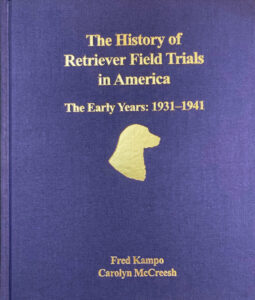
Mike Lardy’s training articles
– Collections 1 & 2
Collections of articles written by one of the most successful field trial trainers. Covers basic training through blinds, although it’s not very detailed. I recommend getting the first collection to get a good overview on field training. He also offers various videos that are more expensive, but can be a great help if you learn better visually. Most trainers I know use Lardy’s training progression or something very similar. Available through Total Retriever Training along with several great videos/DVDs.
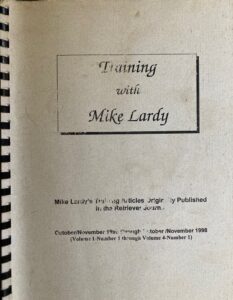
Tri-Tronics Retriever Training
– Jim & Phyllis Dobbs
Step-by-step program for retriever training which emphasizes “making it easy for dogs to learn.” Excellent section on the use of the electronic collar. There are also some concepts gathered from Schutzhund training. By the way, if you use Lardy’s program, skip this book or vice-versa. Trying to use both will confuse your dog.
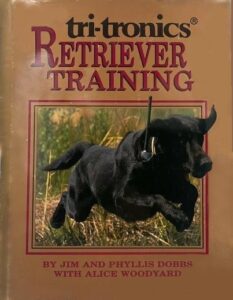
Training Retrievers for the Marshes and Meadows
– James B Spencer
A rather chatty book that starts with choosing a puppy and works its way through beginning to advanced blinds and marks. It does work, but you might want to pick up his other books that go into more detail on marking and running blinds.

Training Retrievers to Handle
– DL & Ann Walters
Very in depth book, but worth reading to understand the steps involved in teaching a dog to handle.
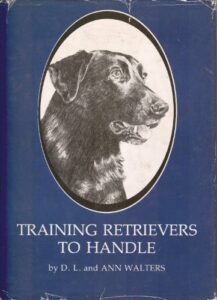
Retriever Training Drills for Marking
– James B Spencer
Because we can’t have a chat with our dogs and explain what we want – in a way they understand – we need drills. Some drills help teach a skill, others are used to refine a behavior. Drills are introduced during basics training and repeated over several training sessions. This book includes a variety of drills to help dogs pinpoint the area of the fall and go straight there.

Retriever Training Drills for Blind Retrieves
– James B Spencer
Most drills have been developed by pros who need ways to teach dogs a concept. Some drills have been shared, while other drills have stayed within a group of people. For example, wagon wheel and 3-hand casting drills are well known. This book does a deep dive into a variety of drills including the purpose of the drill, equipment needed, precautions to take, and a step-by-step description.
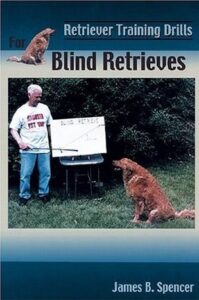
Retriever Training Tests
– James B Spencer
I wish more judges would read this book. Some judges have never hunted which leaves them at a disadvantage. They compensate by setting up a test similar to what they’ve seen as a competitor. Unfortunately they often don’t understand the ‘why’ of that set up. Other judges have lots of hunting experience which really helps them set up a realistic test. Sometimes, however, what happens in an actual hunt doesn’t transfer well to a testing environment.
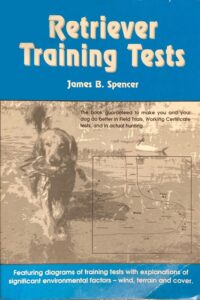
Water Dog
– Richard Wolters
A classic! Many dogs have been trained using this book, however there are newer books available. I think some of the new techniques are easier for the dogs to learn.
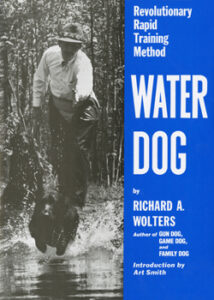
Game Dog
– Richard Wolters
Another good book and similar to Water Dog, but it focuses more on training for upland hunting. I like that it has a step-by-step method.
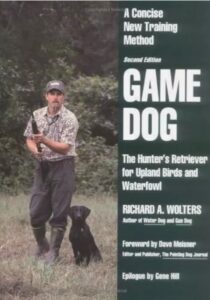
Other dog training books
Expert Obedience Training for Dogs
– Winifred G. Strickland
I have a couple of Bill Koehler’s books and his methods work. However I like more of a partnership rather than a master and servant relationship. Mrs. Strickland worked with her dogs and developed top obedience competitors that were happy and enthusiastic in their work. It also includes how to train tricks and basic tracking.
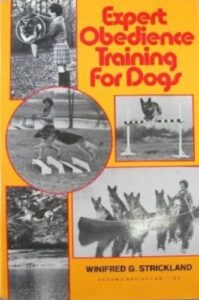
Peak Performance
– M. Christine Zink DVM
How to keep dogs fit and active by a consultant on canine sports medicine. Owners should learn their dogs’ health needs and how to keep them fit to compete successfully.

Beyond Basic Dog Training
– Diane L Bauman
A more recent book on obedience training that allows dogs to learn by trial and error. The dog isn’t corrected and so isn’t afraid of failing. I’ve heard many obedience trial champions have been trained using this method.
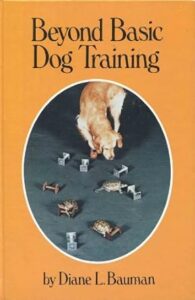
Tracking Dog Theory & Methods
– Glen R. Johnson
An oldie, but if you follow his methods your dog should be ready to run a TD test in about two months. It’s the best all-around book for understanding how to train a dog to track. It includes a schedule to train for TD and TDX titles, although it doesn’t include any information about the VST title.
Component Training For Variable Surface Tracking
– Ed Presnall and Christy Bergeon
Breaks down training for VST into specific skills. Not particularly easy to read, but it is the best book available on VST training.
Other books you need
The New Art of Breeding Better Dogs
– Kyle Onstott
This book does a good job of explaining how to combine genes to create a better dog. It includes an excellent chapter on inbreeding, line breeding, and outcrossing.
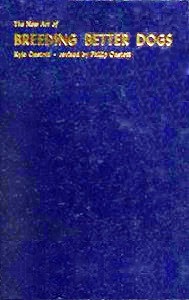
The New Knowledge of Dog Behavior
– Clarence Pfaffenberger
Research on how and when puppies are socialized makes a big difference in how well they can adapt to life with people. This led to discovering the critical stages of puppy development. If that time is missed the puppies may never be able to bond with people.
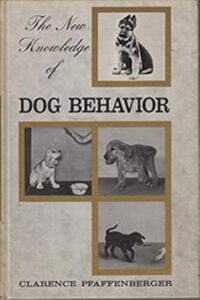
I also have a lot of yearbooks and compilations:
The Labrador Retriever Club (UK) Stud Book and Record of Field Trials 1949 – with an introduction by Lorna, Countess Howe
The Labrador Retriever Club 1931-1956
The Handbook of Amateur Retriever Trials, 1951-1961
Labrador Retriever Bench Records, 1967-1983
Retriever Field Trial Performances (I have almost all volumes, although I’m still looking for the 1979-1984 edition and volumes from 2009 forward.)
Some of the books are rather old and out of date, but there’s still good information in them. Just don’t get me started on magazine collections!
What are YOUR favorite dog books?
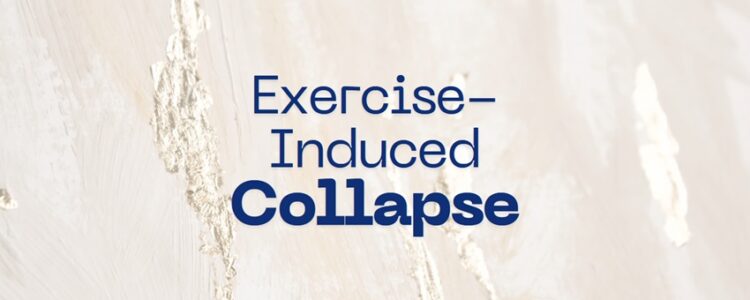
Exercise Induced Collapse (EIC) causes weakness and collapse in some dogs, particularly in very active and excitable dogs. It is caused by a gene mutation affecting some breeds.
If you have a Labrador, Chessie, or any other breed prone to this condition, you’ll want to pay close attention. Let’s dive into what EIC is, how to spot it, and most importantly, how to keep our dogs safe and healthy.
What is Exercise Induced Collapse?
Exercise Induced Collapse is a genetic condition that affects certain dog breeds, causing them to collapse after intense physical activity.
Imagine playing fetch with your energetic Lab, only to see him suddenly stumble and fall after a few minutes of running. It’s a scary sight, but understanding EIC can help us prevent these episodes and help our dogs lead happy, active lives.
Which breeds are most affected?
While EIC is most commonly associated with Labrador Retrievers, it’s not exclusive to them. According to UC Davis Veterinary Genetics Laboratory, the breeds that may carry the EIC gene are:
- Australian Cobberdog
- Australian Labradoodle
- Bouvier des Flandres
- Boykin Spaniel
- Cardigan Welsh Corgi
- Chesapeake Bay Retriever
- Cockapoo
- Cocker Spaniel
- Clumber Spaniel
- Curly Coated Retriever
- Deutsch-Drahthaar
- English Cocker Spaniel
- German Wirehaired Pointer
- Labradoodle and other crosses
- Labrador Retriever
- Old English Sheepdog
- Pembroke Welsh Corgi
- Vizsla
EIC can affect both male and female dogs. It can also occur in mixed breeds, such as doodles and dilutes, that have genetics from one of the affected breeds. And it’s in both field and show lines.
What does an EIC episode look like?
Picture this: You’re at the dog park on a warm summer day. Your Labrador is having the time of his life chasing after his favorite ball. Suddenly, you notice his gait becoming unsteady. His back legs seem weak, and he’s struggling to keep up with the other dogs. This could be the beginning of an EIC episode.
Key symptoms to watch for include:
* A rocking or wobbly gait
* Weakness in the hind legs
* Dragging of the back legs while still running with the front legs
* Collapse after 5-15 minutes of intense exercise
It’s important to note that these episodes are often triggered by a combination of factors, not just exercise alone. High excitement, stress, and warmer temperatures can all contribute to an EIC episode.
The science behind Exercise Induced Collapse
EIC is caused by a specific gene mutation. For a dog to be affected, both parents must carry at least one copy of the gene. Interestingly, about 30% of tested Labradors carry this gene. That’s why genetic testing is important for breeding programs and for pet owners who want to be proactive about their dog’s health.
I use DDC for testing because they’re fast, helpful, and they don’t charge for tests that aren’t a problem for Labradors. They also show the results in plain English. For example:
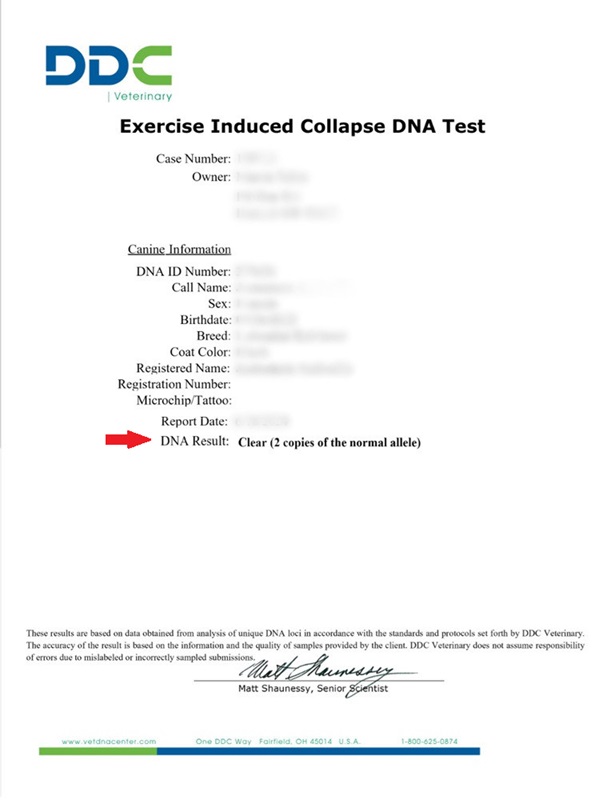
If you use a different laboratory, they may report the results as N/N, or N/EIC, or EIC/EIC.
For results that are N/N, the dog won’t collapse due to EIC and won’t transmit an EIC gene to puppies.
If the test results are N/EIC, the dog won’t collapse, but can pass the gene on to puppies.
Or if the test results are EIC/EIC, the dog may collapse at some point.
Preventing EIC episodes
To keep your EIC-prone dog safe:
- Avoid strenuous exercise in warm weather
- Stop all activity at the first sign of weakness
- Stick to mild or moderate exercise for affected dogs
- Consider removing high-energy, excitable dogs from intense training programs
Our dogs still need exercise and mental stimulation, but we need to be mindful of their limits.
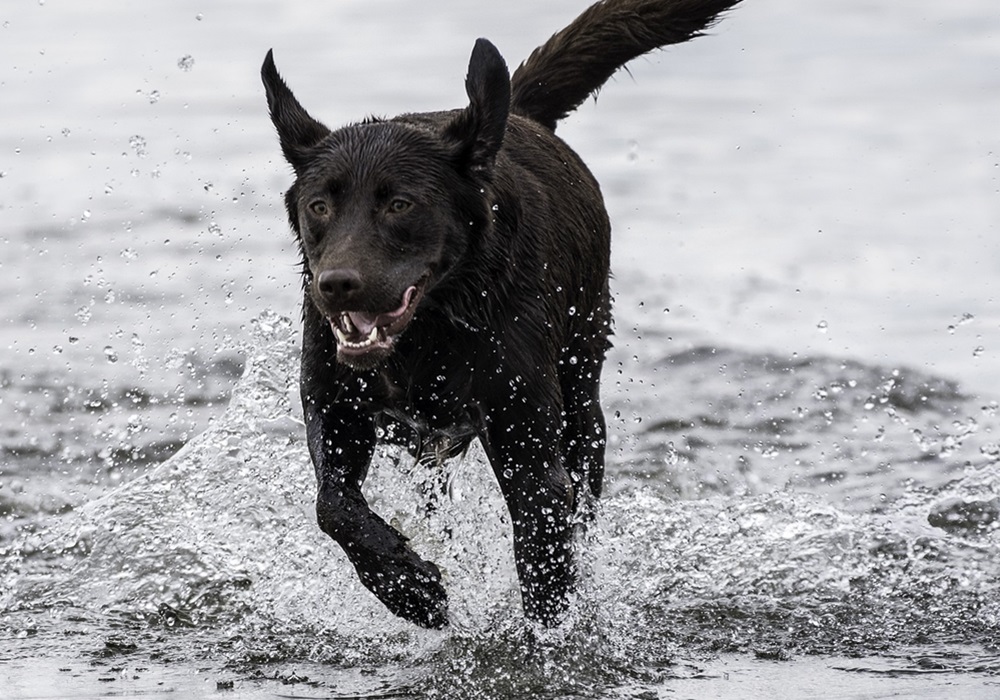
Image by Yinan Chen from Pixabay
What to do during an EIC episode
If you suspect your dog is having an EIC episode, stay calm and follow these steps:
- Immediately stop all exercise
- Move your dog to a cool, shaded area
- Offer small amounts of water
- Lightly spray your dog with cool (not cold) water if they seem overheated
- Allow your dog to rest and recover gradually
Most dogs are alert, but may seem confused. Some dogs may still try to run and their front legs might be stiff. Or they may not be able to move their head and legs. They don’t seem to be in pain. Body temperature is often high.
Symptoms may worsen for a few minutes, but after 10-20 minutes the dog should start returning to normal. It may take longer for their body temperature to return to normal.
The good news is that most dogs recover from EIC episodes within 5-25 minutes, with no lasting effects. However, it’s always best to consult with your vet after an episode to ensure there are no underlying issues.
Living with an EIC-prone dog
Having a dog with EIC doesn’t mean they can’t enjoy an active lifestyle. My friend Debbie has a Labrador named Tucker that was diagnosed with EIC. At first, she was worried that Tucker’s days of fetch and swimming were over. But with some adjustments, Tucker still leads a fun, active life.
Debbie found that shorter play sessions, indoor games during hot weather, and swimming were great ways to keep Tucker happy and healthy. She also learned to read Tucker’s body language, knowing when to call it quits before an episode could occur.
There are other problems with similar symptoms:
Overheating (this can be an emergency)
- frantic panting, increased heart rate, extreme drooling, labored breathing, bright red membranes
- may be dizzy and appear confused
- may collapse and/or experience seizures
- may vomit and/or have diarrhea
Centronuclear Myopathy (CNM)
- gait abnormalities
- generalized weakness
- tires easily
- muscle wasting
- symptoms usually develop as a puppy (2-5 months old)
- once the symptoms develop they are almost constant
If you’d like more information about CNM, go to What is CNM in Labradors?
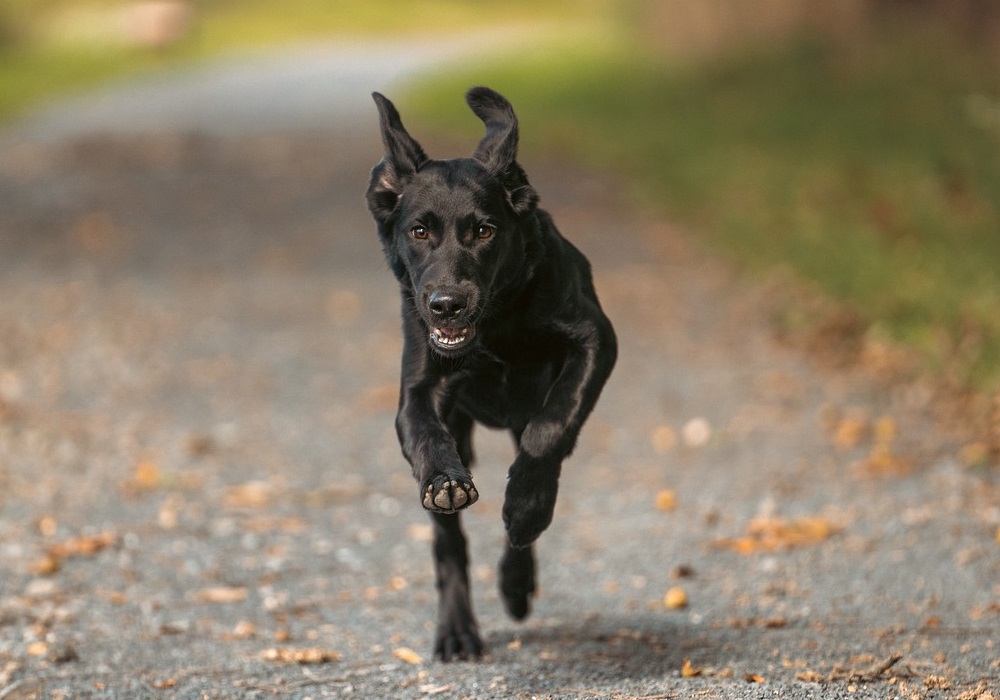
Image by Joshua Choate from Pixabay
FAQs About Exercise Induced Collapse
Q: Can EIC be cured?
A: There’s no cure for EIC, but it can be effectively managed through lifestyle adjustments and careful monitoring.
Q: How is EIC diagnosed?
A: EIC is typically diagnosed through genetic testing and observation of symptoms during exercise.
Q: Will my dog with EIC have a shorter lifespan?
A: EIC itself doesn’t typically affect a dog’s lifespan if properly managed.
Q: Can dogs with EIC still participate in dog sports?
A: While high-intensity sports might be off the table, many dogs with EIC can still enjoy low-impact activities and modified training programs.
Exercise Induced Collapse is a manageable condition that doesn’t have to drastically alter your dog’s quality of life. With awareness, prevention, and proper care, our EIC-prone pups can still lead happy, active lives.
Knowing how to prevent and possibly deal with an episode can keep your dog healthy and safe. So, the next time you’re at the dog park or out for a hike with your dog, keep these insights in mind. Your dog will thank you for it!
NOTE: The information on this website is not intended to replace your veterinarian’s advice. This information is intended to provide non-technical information in an easy-to-understand format. The website author accepts no responsibility or liability for how this information may be interpreted or construed, or any actions that might be taken as a result of the information herein.

Some hunting trips take quite a bit of preparation and a hefty bank account. In that category are an African safari, wing shooting in South America, or a caribou hunt in Canada. Not so with dove hunting which can be as simple as having a shotgun, some shells, and a place to hunt. Some people will want more and that’s okay, but not necessary.
Read on for tips for a successful dove hunt.
Getting started dove hunting
First you need to decide on the what. When considering dove hunting, most people think of the mourning dove. They’re small, fast and quite tasty. Their season generally starts on September 1st.
Mourning doves are brown with black spots on their wings and have a long, pointed tail.
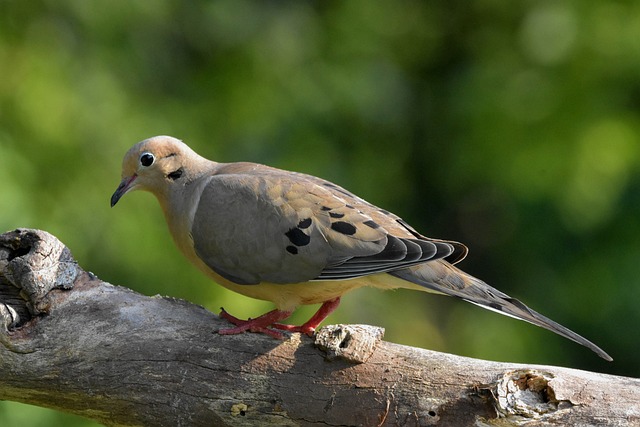
Mourning dove. Image courtesy Pixabay.com
White-winged doves are slightly larger than mourning doves, but they otherwise look very similar. Watch for a white bar on the upper wing surface and a rounded, rather than pointed, tail.
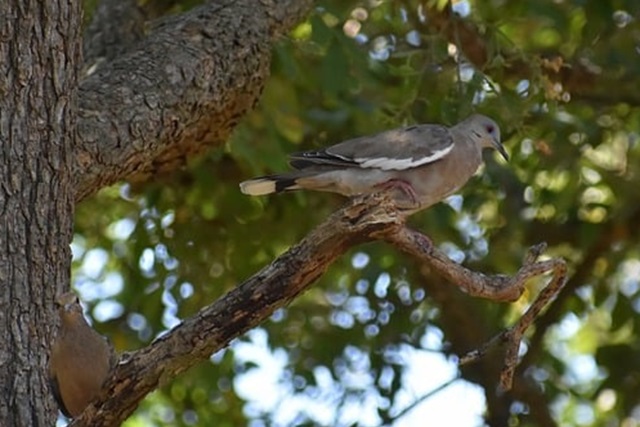
White-wing dove. Image courtesy Pixabay.com
You can hunt both species provided the combined total doesn’t go over possession and bag limits.
Another option is hunting the invasive Eurasian collared dove. They’re bigger than the mourning dove, have a pale gray body, and a black collar on the nape of neck. Also look for a black bill and a squared tail.
Eurasians are found almost everywhere, and in some states you can hunt them year-round with no limits.
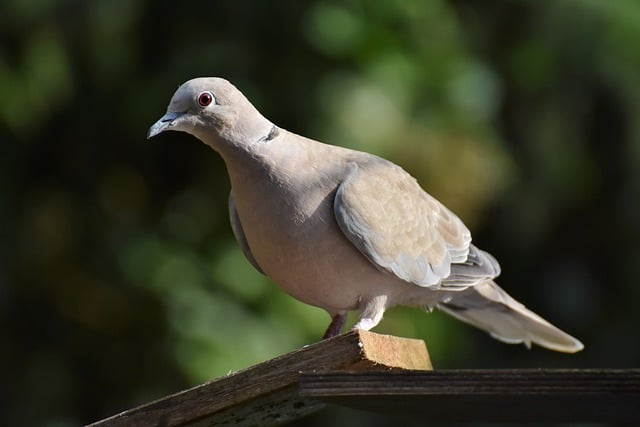
Eurasian dove. Image courtesy Pixabay.com
Next in consideration is the where. Doves need three things – food, water, and gravel. A place to roost nearby is also a consideration.
They love wheat stubble and fields with harvested sunflowers, but any place with seeds can attract them. They’ll even stop at ponds with exposed banks and weed cover. Unfortunately many of those places are not available to hunters. Some might be private property and others could be too close to houses.
You can ask farmers if you can hunt on their property. Also check for state-managed fields that are publicly-accessible. Another option is a hunting club. Members can schedule a hunt on the club’s property which can be thousands of acres.
Lastly is the when. Mourning dove season starts on September 1 in most states, but check with your state to be sure. Eurasian doves can be hunted year round in some states. There are also other dove species which varies by state. Check state websites or ask for a rule book at your local hunting store.
Dove hunting equipment and gear
Hunting license
Mourning doves are protected under the Migratory Bird Treaty Act so you’ll need a valid hunting license with a Migratory Game Bird Endorsement. Every hunter must also enroll in the HIP (Harvest Information Program) and carry proof of enrollment.
Shotgun
Federal regulations require repeating shotguns (pump and semi-auto) be plugged so they can only hold three shells. That includes one in the chamber.
For dove hunting, use an improved cylinder or modified choke for a wider, more open, pattern. A tight pattern makes it harder to hit fast-flying birds, and if you do connect it could tear up the bird.
If you use a double barrel, shoot with an improved cylinder first. Then for a second shot use a modified choke to hit the bird at a longer distance.
Shells
Smaller shot sizes, such as 7, 7-1/2, or 8, are best for dove hunting. These smaller sizes will put more pellets down range which should help you harvest more birds.
Doves are fast and rather acrobatic, so bring more shells than you think you’ll need. A good estimate is five shells for each bird you’re allowed to harvest, so 75 shells for a limit of 15 birds. Better to have too many than not enough!
Also be sure to check state regulations regarding the type of shot allowed. Steel shot may be required on state land or if you’re shooting over water. On private land, ask the property owner if he has a preference.
Clothing
A great thing about dove hunting is you don’t need a lot of expensive equipment or special clothing. I usually wear a pair of jeans and an earth-tone or camouflage shirt. Doves seem more concerned about movement than clothing.
If it’s a long walk in to your hunting spot, make sure your boots are well-fitting and broken in.
Wear a bird vest, preferably in blaze orange for your safety in the field.
Eye protection
Rose or amber-tinted glasses will protect your eyes from UV rays and stray birdshot. They also improve your depth perception so you can separate targets from the background.
Hearing protection
This is a must-have. One unprotected gunshot can cause significant damage to your hearing. And once your hearing is damaged, it can’t be repaired.
There are a variety of options available from the disposable foam earplugs to custom fitted hearing protection. Learn more about the options for ear protection in this Complete Guide. Choose what works best for you.
Sunscreen
Although a lot of other hunting seasons are in the cooler months, dove season is often warm and sunny. Be sure to apply sunscreen on any unprotected skin.
Water
Bring enough for you and for your dog.
Beyond the must-haves, here are some nice-to-haves
A trained retriever
A well-trained dog can make your time in the field so much easier. When my friend, Tom, and I hunted along a creek bed the birds seemed to know where we were and took a detour. So I sent my Lab up on the bluff to the west of the creek.
She not only handled her main duty of fetching the birds we shot, but also worked as a “traffic cop.” Her presence on the bluff had the birds flying along the creek bed and very near to us.
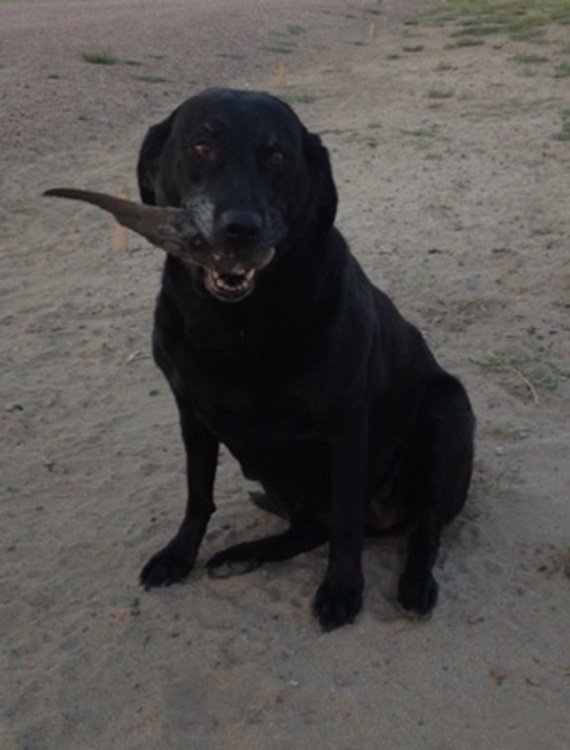
Having two dogs retrieving got the birds out of the field quickly. They also made it possible to find downed birds where the grass was thick and deep. However you must be aware of where each dog is at all times. In thick cover you might add a bell or beeper to their collars.
The best dove hunting dogs are trained well. Skills needed include:
- steadiness
- marking ability
- familiar with gunfire and whistle commands
- experience retrieving upland birds (very different from waterfowl).
If your dog hasn’t hunted doves before, set up a mock hunt that simulates what the dog may experience. If you normally fill your 15 bird bag limit, do a lot of shooting & retrieving. Or if you usually only see a few birds then include lots of sitting and waiting.
Safety tips for dove hunting with a dog
If your dog is young and/or inexperienced, know that your attention will be divided. If he’s not rock solid steady, keep him on a leash while anyone is shooting.
Because it’s often quite warm during dove season, make sure your dog doesn’t overheat. Provide water and as much shade as possible.
Also be aware of potential dangers in the field, such as snakes, barb-wire fences, holes, and snags. Several years ago there was a fast-moving dog that hit a hole, somersaulted, and broke his back.
Your dog’s safety is more important than shooting another bird.
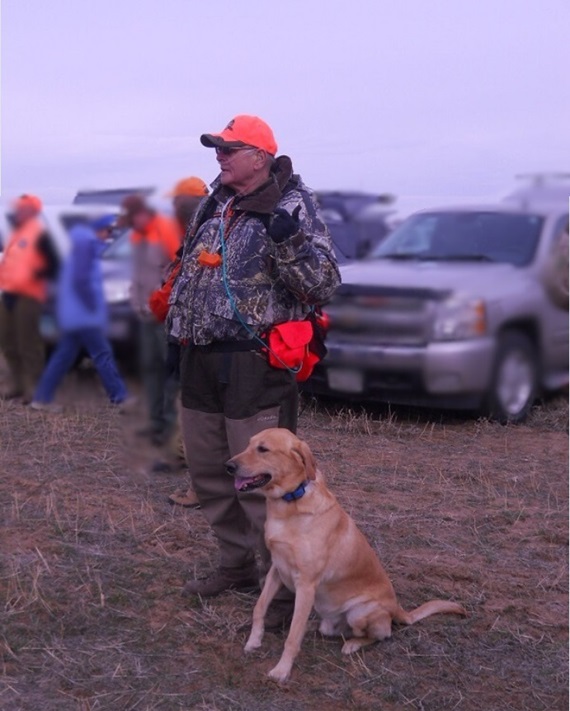
My good friend, Tom, and his yellow Lab, Woody.
A bumper for your dog
Sometimes the birds just don’t cooperate. When that happens, toss the bumper for your dog to retrieve.
Forceps
Walking in to our spot on the creek required crossing a large patch of yucca and prickly pear cactus. The dogs were excited to go, but not so happy about the stickers. Before our next hunt we bought some forceps to pull the spines without pricking our fingers.
Other suggestions I’ve heard are to brush white glue or rubber cement over the stickers, let it dry and peel off. Using duct tape may also help.
Decoys
Doves respond well to decoys and they’re not that expensive. Cabela’s offers some sets of 4-6 decoys for $20-30. Motorized decoys will cost $50 or more, but it’s worth the expense as doves decoy to them from a distance.
For a really inexpensive DIY set of decoys check out the article from Colorado Outdoors Magazine. Then use some clips to attach them to fencing and branches.
Blind to hide behind
Where I hunt there are lots of trees to hide behind so I don’t bring a blind. I do have a small one I made out of gunny sacks and a couple of hot wire poles in case I ever need it. But if you’d rather not DIY there are plenty for sale online.
Something to sit on
Depending on how far you have to hike in, you may want something to sit on or decide it’s not worth the trouble.
I like a bucket with a cushioned swivel top. It makes it easy to carry what I need including ammo, water, sunscreen, and plastic bags.
Knife or game shears, resealable bags, and an ice-filled cooler
Everyone has their own way to field dress doves, but it’s important to get them cooled down as soon as you can. I put them in a bag and pop them in the cooler until there’s time to dress them out.
Once the action slows down, I’ll pluck the breast feathers and peel off the skin. Then cut the breast from one of the wings, leaving a fully feathered wing attached. It’s quick, easy, and few feathers are left to fly around.
Other people will pluck the entire bird after removing the head, feet, wing tips, and entrails. The trick, they say, is to pluck the birds while they’re still warm. Just remember you may need to prove the bird’s species. The easiest way is to leave a fully feathered wing attached.
Preparing for your hunt
Even if you have a favorite spot, check everywhere you might hunt in the coming season. Something about the location might have changed causing doves to avoid it. Land ownership could have changed as well.
Drive around areas that doves might like. Look for birds sitting on power lines near croplands or flying in or out of a field. Watch for doves on gravel roads where they can consume grit to help digest their food.
Although their natural foods are sunflowers, foxtail, and grasses with small seeds, they are also attracted to croplands.
Also look for a water source nearby. In warm weather doves will fly to water several times in a day. The water can be as small as a puddle, but look for water that doesn’t have a lot of vegetation around it. Doves are more vulnerable on the ground and prefer a good field of vision.
When you find a likely area, ask the landowner for permission if it’s private property. Or if it’s state land, check the regulations.
You might also try contacting the local conservation officer. He may know of food plots planted for upland game on state lands. Or he could suggest landowners for you to contact. If the landowner gives you permission, you should thank him with at least a note or a few birds you shot on his property.
Hunting methods
Pass-shooting
Doves like to feed in the early morning and in the afternoon. If you’re in the right place at the right time, you’ll see them moving from feeding ground to water and then to roost. During the middle part of the day, they’ll mostly hang out on power lines or in trees.
Things to keep in mind:
- Doves like to be part of a flock. If you see a few birds, wait a bit to see if others come along. Watch where they go. Look for a place along that flight line where you can set up.
- Best times to see doves are just before sunrise and about an hour before sunset. In the morning, they’re heading out to feed. In the evening, they’re going to get a drink.
- Pay attention to the prevailing wind.
- Look for a place where you can blend in, rather than being silhouetted against the skyline. And then stay still while birds are flying.
- As seed eaters, doves will walk around on the ground looking for seeds. And they prefer open ground so they can see approaching danger.
- They also want to be fairly close to water. Generally they’ll eat in the morning and afternoon, then get a drink, and finally head for a roost.
- Another place to check are areas with sand or gravel. Doves will visit these areas after feeding because they need grit to grind down the seeds.
- Doves are fast fliers so you need to aim where they’ll be and not where they are. Focus on the bird’s head and add a four to six foot lead. Increase or decrease the lead until you find your sweet spot. Be sure to continue swinging through the bird as you shoot.
Decoying doves
Doves will decoy. One or two spinners can be seen from a distance and will bring doves in close. Wing flapping decoys look more natural, but can’t be seen as far.
Adding some static decoys set out to look like they’re feeding, drinking, or roosting will help incoming birds think it’s safe. Just make sure the decoys are easy to see.
Even silhouettes clipped onto tree branches and fences can work.
However when shooting over decoys, be aware that your shots may be lower. What can be hit with a low shot? A building? Other hunters? A dog?
Regulations
Be sure to read a copy of your state’s regulations.
You can’t hunt over an area where “bait is present that could lure or attract birds ‘to, on, or over areas where hunters are attempting to take them.'” So watch for grain or other feed in the area where you plan to hunt. If it’s due to agricultural planting and harvesting, you should be fine. However if the grain is in piles, you should find another place to hunt.
Some tips from Arizona Game & Fish:
- Don’t shoot within 1/4 mile (440 yards) of an occupied structure while hunting unless you have permission
- Don’t shoot from, across or into roads or railways
- Don’t leave shotgun shells or other litter on the ground
- Don’t hunt over water all day — allow time for livestock to access water
- Don’t consume drugs and/or alcohol while hunting or handling firearms
Terms you should know
“Motorized vehicles. You cannot hunt migratory game birds from or by means, aid, or use of any motor vehicle, motor-driven land conveyance, or aircraft (if you are a paraplegic or are missing one or both legs, you may hunt from a stationary car or other stationary motor-driven land vehicle or conveyance).
“Shooting hours. You cannot hunt migratory game birds except during the hours open to shooting.
“Closed season. You cannot hunt migratory game birds during the closed season.
“Daily bag limit. You can take only one daily bag limit in any one day. This limit determines the number of doves you can have in your possession while in the field or while in route back to your car, hunting camp, home, or other destination.
“Wanton waste. You must make a reasonable effort to retrieve all doves that you kill or cripple and keep these birds in your actual custody while in the field. You must immediately kill any wounded birds that you retrieve and count those birds toward your daily bag limit. Your birds must remain in your possession while in the field. You cannot give your birds to another person in the field regardless of whether or not they are properly tagged.
“Tagging. You cannot put or leave migratory game birds at any place or in the custody of another person unless you tag the birds with your signature, address, number of birds identified by species, and the date you killed them.
“Dual violation. A violation of a State migratory game bird regulation is also a violation of Federal regulations.
“Migratory Bird Harvest Information Program (HIP). Each hunter is required to enroll in the HIP and carry proof of such enrollment.
“Protected birds. Federal law prohibits the killing of non-game migratory birds. Protected birds that you may encounter while dove hunting include songbirds, eagles, hawks, owls, vultures, killdeer, nighthawks, herons, egrets, and woodpeckers.”
After the hunt
Care for your dog
Run your hands over your dog’s face, ears, body, legs (including “arm pits” and groin) and between his toes. You’re looking for injuries, bumps that could be ticks, foxtails, and cactus or other stickers.
Be sure to offer water as well.
Finish prepping birds
If you’ve already started preparing your birds, just cut off the remaining wing and clean the breast. Otherwise finish preparing your birds whether you’ll cook the entire bird or just the breast.
I like the time-tested recipe – wrapped in bacon with a slice of jalapeño. Although I admit I like a milder pepper and often use a poblano instead.
Doves are tiny but tasty. The breasts are dark red meat that tastes like beef, or like little duck breasts, if you cook it rare. Breasting a dove is simple and takes seconds, leaving you with about an ounce of meat per dove. You can leave the meat on the keel and make the ever-popular dove popper, a cream-cheese and jalapeno-stuffed breast wrapped in bacon, or you can filet those two bites off the breast and use them in a kabob or stir-fry. And, again, the meat will be delicious rare, and unpleasantly liver-like if you cook it too much.
If you’d like something a little different, check out Hank Shaw’s dove recipes.
Final thoughts
Dove are quick, fun, and tasty. I look forward to September not only as the start of hunting season, but also for soon-to-be cooler weather.
Enjoy your time in the field, whether it’s with hunting buddies or just your favorite dog.
Header photo by Aaron J Hill/Pexels
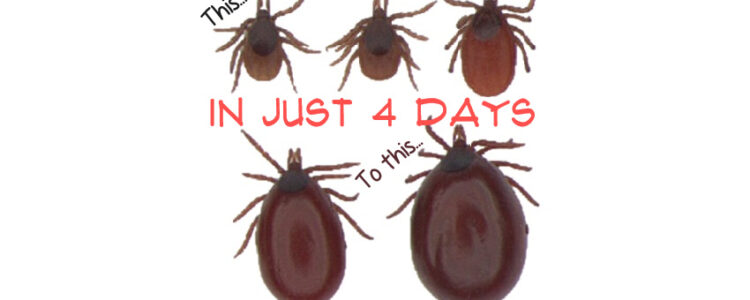
Ticks are tiny, blood-sucking parasites that can cause serious health problems in dogs. They live in tall grass, brushy and wooded areas where they can latch onto pets and feed on their blood.
Tick-borne diseases are a growing concern for dog owners as these illnesses can be hard to diagnose and treat.
About ticks
Ticks are related to spiders and mites. They feed on the blood of mammals, birds, and reptiles and can spread diseases to people and animals.
There are several species of ticks that can vary in size from 1mm (about the size of a pencil tip) to 6mm. When feeding, sometimes for days, they will get larger as they gorge on blood. They can be green, brown, black, or white, depending on the type and age of the tick.
Some of the most common ticks that can affect dogs in the United States include the American dog tick, lone star tick, brown dog tick. and black-legged tick.
If you find a tick crawling on you or your dog, scoop it into a small jar filled with rubbing alcohol. Don’t squish a tick because that could spread any disease it might be carrying. Not every tick is infected, but it’s better to treat them like they are.
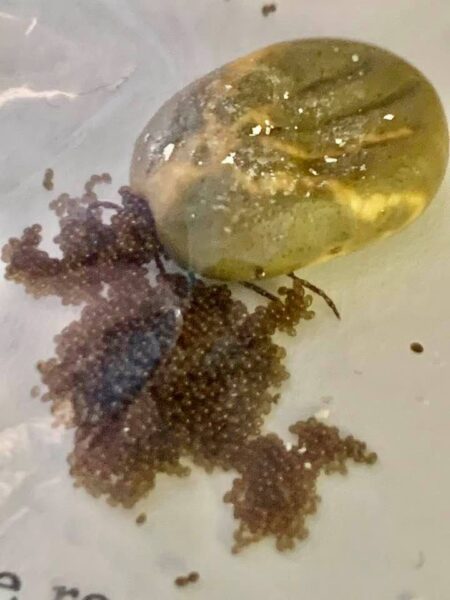
“This is a tick that was fully engorged on a dog and fell off. It was put in a ziplock bag and we waited to see what happened to show you all. It’s been in the bag for 2 weeks with no air flow and started to lay eggs about 5 days ago, continuing to do so even still today. Imagine not knowing this was on your animal and it fell off in your house. You’d have 1000’s of baby ticks. GROSS! Please make sure your animals are currently being treated with flea and tick prevention. We know how prevalent they are in our area.”
Tick-Borne Diseases
Ticks spread disease by first feeding on an affected animal (or person) and later feeding on another animal (or person). When feeding, they insert their mouthparts into the host and drink the blood. Meanwhile, the tick’s saliva enters the host, potentially spreading disease.
They can transmit several diseases to dogs, some of which can be life-threatening. The most common are:
Lyme disease:
Bacteria carried by black-legged ticks cause this disease. Symptoms include fever, joint pain, headache, fatigue, and loss of appetite. In some cases, Lyme disease can cause kidney damage, heart problems, and neurological issues. Lime disease is in the upper midwestern, northeastern, and mid-Atlantic states and also on the west coast. There is a vaccine for Lyme.
Signs and symptoms: The first symptom is often a circular rash at the bite site that slowly grows to about two inches in diameter. It’s rarely itchy or painful. Other symptoms include fever, chills, and fatigue. Over time there may be additional rash sites and nerve damage that causes weakness and numbness.
Ehrlichiosis and Anaplasmosis:
Bacteria, carried by an infected tick, cause these infections. Lone star ticks carry ehrlichiosis, black-legged ticks carry anaplasmosis. Symptoms are similar and include fever, headache, chills, fatigue, loss of appetite, and joint pain. In severe cases, ehrlichiosis can cause anemia and bleeding disorders, and anaplasmosis can cause respiratory distress and neurological issues. Ehrlichiosis is in the southeastern and south-central states. Anaplasmosis is in the upper Midwest and northeastern states.
Signs and symptoms: fever, chills, fatigue, muscle pain, nausea, vomiting, diarrhea
Rocky Mountain Spotted Fever:
RMSF is a bacterial disease spread by an infected tick. Early symptoms include fever, headache, fatigue, stomach pain, and loss of appetite. RMSF is most common in North Carolina, Tennessee, Missouri, Arkansas, Oklahoma, and along the US-Mexico border, but it does occur in every state.
Signs and symptoms: rash, fever, fatigue, swelling around the eyes and hands, nausea, vomiting, diarrhea. Later there may be necrosis, trouble breathing, brain swelling, and coma.
If you think your dog may have a tick-borne disease, check with your veterinarian immediately.
Tick life stages
Each row shows an adult female, adult male, nymph, and larva of a species.
Top row: American dog tick
Middle row: Black legged tick
Bottom row: Lone star tick
Image courtesy Cornell University
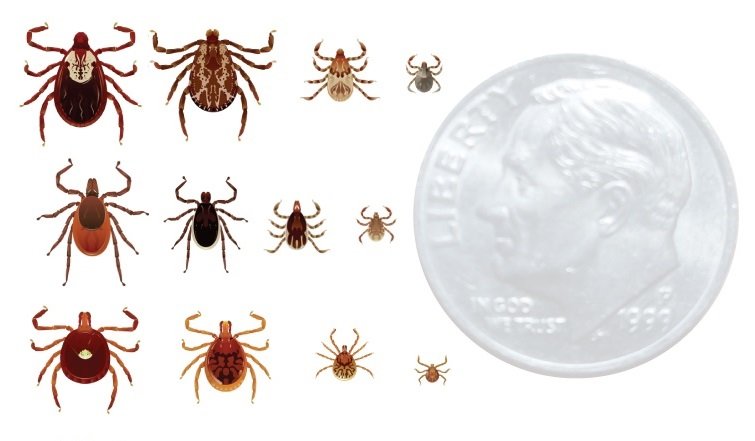
Protecting your dog
Take preventive measures to protect your dog.
Avoid Tick-Infested Areas:
Ticks are found in tall grass and wooded areas. To reduce your dog’s risk of tick bites, avoid taking them to places where ticks are known to be present.
Keep Your Yard Clean:
To reduce your dog’s risk of tick bites, keep your yard clean and well-maintained. Mow your lawn regularly and remove any leaf litter or debris that may provide a hiding place for ticks.
Use Tick Preventatives:
Several tick preventatives are available for dogs, including sprays, collars, tablets, and chews. These products kill ticks before they can attach to your dog’s skin. Talk to your veterinarian about the best tick preventative for your dog.
Consider vaccinations:
There are vaccines for some tick-borne diseases, such as Lyme disease. Talk to your veterinarian about vaccinations recommended for your dog.
Checking for ticks
Check your dog
After spending time outdoors, thoroughly check your dog for ticks. Start by running your hands all over your dog. If you feel a bump, spread his fur to see if it’s a tick. Be sure to check all the nooks and crannies – in and around his ears, eyelids, facial wrinkles, under collars, “armpits”, groin area, and between his toes. Sometimes they’ll even feed on your dog’s gums. Another option is using a special tick comb to pull off ticks.
If you find a tick, remove it using tweezers or a tick remover:
- Protect your skin with latex gloves.
- Using tweezers, pinch the tick close to your dog’s skin and pull away from the skin in a steady motion. Don’t twist or squeeze the tick because the head could break off.
- If you use a tick remover, slide it along your dog’s skin until you catch it in the notch. Pull away in a steady motion.
- Place the tick(s) in a small jar and cover it with rubbing alcohol. Ask your veterinarian if you need to bring it in for identification.
- Wipe a cotton ball soaked in antiseptic over the bite area.
- Then keep looking because there may be more.
Check yourself
Ticks can also latch on to people, so check yourself for ticks after spending time outdoors. You probably won’t feel them on your skin or even when they bite and start feeding because they inject an anesthetic. If you find a tick, remove it immediately using tweezers or a tick remover detailed above.
If you live in, or are visiting, an area with lots of ticks, check your dog and yourself daily.
Conclusion
Tick-borne diseases are a threat to your dog’s health and to your health. Taking preventative measures can reduce the risk of tick bites and tick-borne diseases.
Talk to your veterinarian about which tick preventatives are best for your dog.
Header image courtesy of Centers for Disease Control and Prevention
NOTE: The information on this website is not intended to replace your veterinarian’s advice. This information is intended to provide non-technical information in an easy-to-understand format. The website author accepts no responsibility or liability for how this information may be interpreted or construed, or any actions that might be taken as a result of the information herein.
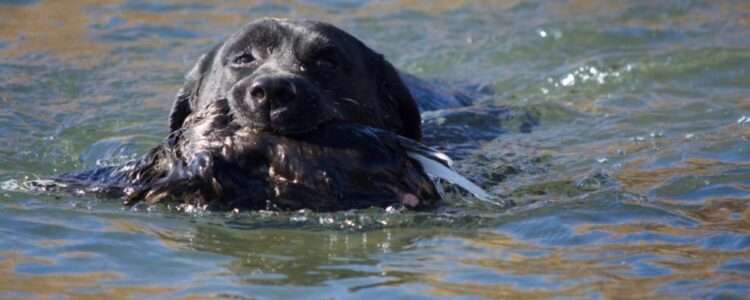
After a rewarding hunting season, you might find yourself looking for more challenges and opportunities to bond with your dog. That’s where hunting tests come into play.
Some hunters may feel their dogs are skilled enough without needing titles and ribbons, but hunting tests offer much more.
It’s a great way to keep your dog active and in sync during the off-season. Plus, it’s an opportunity to showcase your dog’s abilities and to connect with others who share the same passion. Many lifelong friendships are forged while training and competing.
With your curiosity piqued, I’ll bet you’re wondering, “What can I expect at a hunting test?” Well, grab your favorite beverage and settle in to learn about the fascinating world of retriever hunting tests.
History of Retriever Hunting Tests
Retriever breeds have competed in field trials in the US since the 1930s. In the beginning, the tasks required of the dogs were not much different than we see in hunting tests today. But as the dogs got better, the tasks got harder. And as the tasks got harder they became less like hunting.
Eventually, hunters wanted a way to test their dogs’ actual hunting abilities. A few different programs were tried but with little success.
Then in 1979, Omar Driskill started a “gun dog club” in Louisiana that became very popular. A few years later Bill Tarrant noted field trials were producing dogs that were different than what the average hunter wanted. And Richard Wolters (author of “Water Dog”) wrote an article asking if there’s a need for the hunting retriever movement.
Table of Contents
History of Retriever Hunting Tests
The Basics of Retriever Hunting Tests
Junior vs Started Retriever Hunting Tests
Senior vs Seasoned Retriever Hunting Tests
Master vs Finished Retriever Hunting Tests
Master National vs International Grand Hunt
So hunting enthusiasts got together in New York to discuss forming an organization for hunting retrievers. Present were trainers, writers, and representatives from AKC and UKC.
First Hunting Tests
Based on that meeting, the first hunting test was held in 1983 under the North American Hunting Retriever Association (“NAHRA”) rules.
About a year later the Hunting Retriever Club (“HRC”) was formed. Shortly after that the American Kennel Club (“AKC”) held its first retriever hunting test. Because of their common start, the rules and the stakes offered are very similar. The tests are not competitive so the dogs pass or fail on their own merits. There are three basic levels with titles in each organization.
In 1985, the first year that AKC licensed tests, there were 13 events with 681 entries. By 2005, there were 341 events with nearly 35,000 entries.
It wasn’t long before owners who had titled their dogs in Master or Finished, wanted something more to achieve. This led to the development of the Master National (affiliated with AKC) and HRC’s International Grand.
Something the original organizers probably didn’t consider was as training methods improved the tests would gradually became more difficult. A Junior stake 20 years ago was very different from tests today despite the rules changing very little. This seems to be the case in both organizations, but it’s a bit more apparent in AKC tests.
The Basics of Retriever Hunting Tests
The AKC and the HRC offer similar hunting tests. Each offers three levels for weekend hunt tests, plus a more difficult annual (twice annually for HRC) test. HRC also offers an Upland test.
Clothing
AKC requires handlers to wear “dark or customary hunting attire”.
HRC requires the handler to wear ALL camouflage – shirt with pants / shorts / or skirt. Hats and waders, if worn, also need to be camo.
Titles
Titles earned in AKC hunt tests are listed after the dog’s name, while HRC titles are listed before the name.
The levels are:
| AKC | HRC |
| Junior / JH | Started / SHR |
| Senior / SH | Seasoned / HR |
| Master / MH | Finished / HRCH |
| Upland / UH | |
| Master National / MNH | International Grand / GRHRC |
The rules are similar, but not exactly the same. Be sure to check before entering and running your dog. You should read the rule book and highlight important information so you can find it easily when you have questions.
Allowed breeds:
You’d think retriever hunt tests would be for retrievers, but both organizations opened the tests up to many hunting breeds. In a nutshell, they allow retrievers, plus Standard Poodles and a variety of spaniel and pointer breeds.
Spayed/neutered dogs and dogs that would be disqualified in the show ring are also welcome.
AKC restricts the hunt tests to dogs over six months, individually registered (not just litter registration), and of eligible breeds. There are special rules for entering imported dogs that are not yet registered with AKC.
HRC limits the tests to hunting breeds on their list which does not include dilutes (the “Silver Labs“). Note: if a dilute dog is entered in a hunting test the test committee should be notified. HRC does not consider dilutes a hunting breed and are disqualified.
Joining a club
You don’t have to be a member of a club to enter, but having a group to train with can be helpful.
Find a local AKC club (select ‘Hunting Test’ and your state)
Find a local HRC club (click on ‘State’ to group clubs by state)
Join HRC (national club) It’s not expensive and you get an informational magazine six times per year. There are additional fees in HRC if you are not a member of the national club or if your dog is not UKC registered.
Click to start the UKC registration process. If your dog is AKC registered, have that information handy to fill out the UKC form.

Click to watch a video of Omar Driskill talking about the start of hunt tests.
Junior vs Started Hunting Tests
The Junior and Started hunting tests are very similar. They include two series – a land series with two single retrieves on land and a water series with two single retrieves on water.
Both allow you to hold your dog at the line. In Junior, you can loop a slipcord through the collar which must be a flat buckle collar. Or you can hold the dog by the collar. In Started, you can hold the dog by a collar, leash, or line around its neck. (As a judge, I always recommend holding your dog. If you don’t and your dog breaks, he will likely fail.)
A change in AKC rules as of August 1, 2023 allows handlers to speak quietly to their dog and be allowed to touch their dog for reassurance or positioning. This is only allowed at the Junior level. Handlers can speak quietly to their dog in Started as well.
You don’t handle a gun in AKC and rarely handle one in HRC. Although in HRC you can opt to shoulder and shoot a popper. However in that case you cannot hold your dog and you are also judged on gun safety.
There are some differences
You’ll need a whistle in either test and a duck call in Started. Although the AKC premium usually says to bring a duck call, many judges don’t require it. You should, however, have your own duck call, know how to blow it, and have your dog used to it. Just in case.
Distances
The maximum distances are different. In Junior, the test distance on land and water “should not normally exceed 100 yards.” But in Started, the “maximum land test distance will not exceed seventy-five (75) yards, but may be less.” The wording is the same for water, but the maximum distance is 60 yards. Some judges like to push the distance out further, particularly in AKC where the wording is not as definite.
Sit or Stand
You’ll often stand beside your dog in Junior. Whereas in Started you’ll generally sit on a bucket beside your dog. Be prepared to run your dog from either position.
Entry Limits
Started is limited to 50 entries per flight. Most HRC Started tests don’t fill, but enter as soon as entries open if you want to be sure. Many clubs allow “walk ups” (entering the morning of the test), but only until the limit is reached. Junior entries are rarely limited, however entries are only accepted until about two weeks before the test.
Birds
Ducks are often used, but occasionally you’ll see a mixed bag of ducks on water and upland birds on land.
In Junior, you’ll have at least one shot flyer (unless using live ammunition is prohibited by law or the land owner). A live bird will be thrown in the air and shot. Depending on the gunners, that could mean a dead bird, a lightly-hit runner, or a hard-hit bird not be suitable for the table.
In Started the birds are usually humanely killed on the morning of the hunt test. Often gas is used and new dogs can be unsure of that smell, but the scent wears off quickly. If your dog has never run an HRC test, you can ask to run a bit later.
After the bird lands you must wait for the judge to release you in a Junior test.
But in Started, you’re allowed to send your dog as soon as the bird hits the ground or water. However, you should wait a couple of seconds so there’s no question the bird landed before you sent your dog.
Confusion
Sometimes a dog will start toward a mark and stop within about 15 feet. In Junior, the dog can be recast because he may be confused whether he was actually sent to retrieve. This is different from a dog that goes to the area of the fall, fails to find the bird, and comes back to the handler. However in Started you can cast your dog a maximum of two times from the line per bird. The rules don’t specify a limit on how far the dog can go or how long he can hunt.
Delivery
Your dog must deliver all birds to hand in Junior. If he drops it, perhaps to shake off water, you can tell him again to fetch it. You may have to tell him several times, but the more commands, the lower his score. However if he’s unwilling to release the bird he’ll be scored low in Trainability, even to the point of failing. In Started, your dog must deliver to your immediate area, but not necessarily to your hand. If the judges don’t explain their measurement for “your immediate area” you should ask as it’s not clearly defined. Generally, judges will allow you to take a long step to pick up the bird.
Second series
In Junior, the judges will confer after completing the first series. A dog that both judges have failed is not called back to run the second series. The judges will list the dogs (by number) that are passing and the marshal will advise handlers of the “callbacks.” In Started, you can continue to run your dog even if you failed the first series with some exceptions. Those exceptions include a gun safety violation, dog fighting, or a handler ejected for bad behavior.
HRC awards five points per pass with 20 points required for the Started (“SHR”) title. In essence, both AKC and HRC require four passes in Junior or Started for a title in that organization. Passes from a higher level do not count toward the Junior or Started titles.
Watch an AKC Junior Hunting Test or an HRC Started Hunting Test.
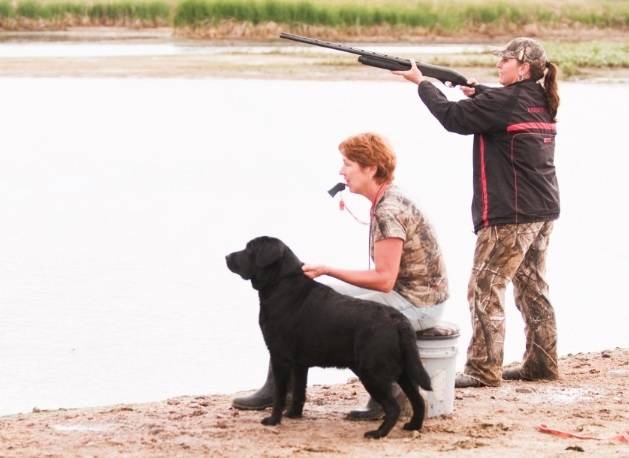
Senior vs Seasoned Hunting Tests
Although the basics are similar, there are a lot of differences between Senior and Seasoned tests.
What is similar
Both include double land and water marks, a land blind and a water blind, but they’re run differently.
Senior has two series: land double and blind, water double and blind, plus at least one diversion shot, a walk-up to start one of the tests, and an honor. Dogs that fail the first series are not called back to run the second series.
Seasoned has five tests: a walk-up, a double land mark, a land blind, a double water mark, and a water blind. There is also a diversion bird.
Pretty similar except Senior has a walk-up to start a double while Seasoned does the walk-up separately.
Collars
Dogs run without a collar in both organizations, but when the collar or slip lead is removed is different.
In Senior it’s removed before going to the line from the final holding blind. The dog is put back on a lead when the series is finished and the dog and handler are behind the judges. You may be asked to put your dog on a lead to honor if your dog has failed the test.
For Seasoned, the dog goes to the line on a lead and the lead is removed before starting the test. If the dog runs the marks and blind from a different line, the dog is put back on a lead when moving to the next line. The dog is also put on a lead when the series is finished.
Handling the shotgun
Handlers in both organizations must shoulder the shotgun. Senior tests have a non-operational gun and there is no shooting from the line. Seasoned tests require handlers to shoulder, aim and shoot a popper at each bird.
Blinds must be outside of the marks and delivering the bird to hand is required in both stakes.
Distance
In Senior, the test distance on land and water “should not normally exceed 100 yards.” While in Seasoned, the “maximum land test distance will not exceed one hundred (100) yards but may be shorter.” The wording is the same for water, but the maximum distance is 75 yards. The blinds “will not exceed sixty (60) yards…”
Diversions
In Senior, diversion shot(s) must be used and diversion bird(s) may be used. Switching or returning to an old fall in Senior is a failure. Seasoned requires a diversion bird that “can be thrown after the walk-up, blind, or last retrieve of a double mark.” Switching to the diversion bird is a mark-down, but not a failure in Seasoned.
Casting
Seasoned can be cast from the line two times per bird, but in Senior the dog can be sent more than once only in cases of confusion. There is no second chance if the dog doesn’t go when sent for a blind retrieve.
Popping
Popping isn’t penalized in Seasoned. It is a mark-down in Senior, earning a bigger penalty the more the dog pops.
Honoring
Senior dogs must honor a working dog at least once. There isn’t an honor in Seasoned.
Entry limits
Also, Seasoned limits the number of entries to 40 per flight. If you want to make sure you can enter check for when entries open and enter online as soon as possible after that. I’ve never seen an AKC club limit Senior entries. However if there are too many entries to finish the test in one day, you may have to come back. If the test starts on Sunday, that means coming back on Monday.
Titling
If a dog has a Junior title, four passes are required for the Senior title. Without a Junior title, five passes are required.
The Seasoned (“HR”) title requires forty (40) points for a title and can include points from Started (5 points per pass), Seasoned (10 points per pass), or Finished (15 points per pass). However, only 10 points from Started can be counted toward the Seasoned title. Basically, if you have a couple of Started passes you need three Seasoned passes. Otherwise, four Seasoned passes are needed for the HR title.
Watch an AKC Senior Hunting Test or an HRC Seasoned Hunting Test.

Master vs Finished Hunting Tests
In these tests, almost anything goes. There will be multiple marks and sometimes multiple blinds, diversion shots and/or birds, plus an honor and/or a walk-up. Dogs might run from a boat or from beside a layout blind. There may be a mixed bag of birds (for example, retrieving ducks and pheasants in the same series). Handlers of the working AND honor dogs may have to shoot at birds. There might be a “poison bird” (a bird the dog may not retrieve until he has done another task).
Luckily there are limits to what the judges can require.
What is similar
Dogs are taken off lead before leaving the holding blind. They are judged until the series is finished and the dog and handler are behind the judges. An exception is made when they’ve failed the test and have to honor on lead.
Although Junior or Senior entries aren’t usually limited, Master can be – and often is – limited. Clubs can choose to limit the number to 66, 100, 132, or 200 entries or can have unlimited entries.
HRC limits the number of Finished entries to 30 dogs per flight. Many clubs schedule a second or third set of judges to run more flights so more dogs can enter. Even with additional flights scheduled you should enter early as most tests fill up quickly.
Master test requirements:
- has three series – a land series with multiple marks, a water series with multiple marks and a land and water series with multiple marks
- at least two of the multiple-marking situations must have three falls before the dog is sent to retrieve
- a land blind and a water blind with at least one double blind
- dogs must honor at least once
- there must be a walk-up, diversion bird and/or shots at least once
- will be scheduled to run over a minimum of two consecutive days
Finished test requirements:
- has four tests – a land triple, a water triple, a land blind, and a water blind – may be required to retrieve in an established sequence
- at least one of the triples must include an honor
- the blinds may or may not be included with one of the triple retrieves
- there must be a diversion as the dog returns from any retrieve
- the test is completed in one day
Test distances
Master on land and water, shall not normally exceed 150 yards.
Finished land distance will not exceed 150 yards, but may be shorter. Water distance will not exceed 125 yards, but may be shorter. Blind retrieve distance will not exceed 100 yards.
Switching
In Master it shall be scored low, to the point of failing. But in Finished, switching to a diversion bird is a fail.
Controlled break
The Master dog fails, while the Finished dog may be failed for a controlled break or excessive, consistent creeping.
The use of the shotgun
A Master handler “shall always carry and shoulder an empty shotgun except when honoring the working dog or when running a blind.”
A Finished handler “must shoulder the shotgun, aim, track, and shoot at the top of the arc of the thrown bird.”
Titling
If a dog already has a Senior title, five passes are required for a Master title. Without a Senior title, six passes are required.
A Finished title (“HRCH”) requires 100 points and points can be earned in Started (5 points per pass), Seasoned (10 points per pass) and/or Finished (15 points per pass). However, at least 60 points must be earned in Finished with a maximum of 40 points from Seasoned. If 10 points were earned in Started, then a maximum of 30 points can come from Seasoned.
Watch an AKC Master Hunting Test or an HRC Finished Hunting Test.
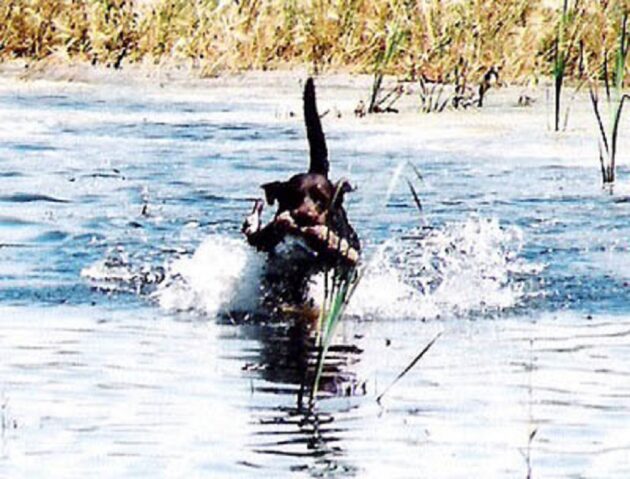
HRC Upland Hunting Tests
The Upland Hunter stake is designed for dogs trained to the Finished level. However dogs don’t need to have any titles before entering an Upland test.
There’s a simulated walk-up followed by a quartering test where the dog will locate and flush at least two birds. The handler must aim, track, and shoot a popper at birds his dog flushes, keeping gun safety in mind. Once the handler has fired a shot, the official guns may shoot the bird, if it can be done safely. The dog must retrieve any birds shot for him and must honor another dog.
Each passing score earns the dog 10 points with 40 points needed to earn an Upland Hunter (“UH”) title.
Watch an HRC Upland Hunting Test.

Master National vs International Grand
These events are very different from weekend hunting tests. Dogs must qualify to enter, their work is held to a higher standard, and the events are run over several days.
To qualify for the Master National, the dog must have passed six Master tests between August 1 of the year before the event and July 31 of the event year. There are exceptions for dogs running tests exclusively in Alaska or Canada. A dog that qualified at the previous year’s Master National needs four Master passes to enter. A dog that has the MNH title doesn’t have to requalify.
The Master National Hunter (“MNH”) title requires three passes at the Master National Hunting Test. This title is in addition to the MH title. Unlike other hunting test titles, the owner must request the title certificate and pay a fee.
There is also a Master Amateur Hunting Title (“MAH”) which is similar to the MNH. Dogs must pass the Master Amateur Invitational Hunting Test three times to title. The owner must request the title certificate and pay a fee.
Two Grand Hunts are held each year and are open to retrievers that have earned a Hunting Retriever Championship (“HRCH”) title. There are five series. Two series have multiple mark land tests with a blind retrieve and at least one honor and a diversion. The two multiple mark water tests must have a blind retrieve and at least one honor and a diversion. The fifth series consists of an upland quartering test.
Prompt and precise responses are expected from retrievers at this level. Distances may be longer than any weekend hunt tests. A quad or delayed quad and/or having the dog retrieve in a particular sequence can be used.
Watch a Master National or an International Grand.
Are you ready to run a hunting test?
Entering a test
Tests in both organizations can be entered online. Go to EntryExpress for AKC or HuntSecretary for HRC. (Note: be sure to check both platforms if you’re running AKC as some tests are showing up on HuntSecretary.)
Entries are limited in HRC and Finished usually fills up very quickly. Seasoned might fill up quickly as well. AKC tests can also be limited but generally only Master. Be sure to check for when entries open and close.
You can run your dog in HRC without a UKC registration, but you’ll pay more, and your dog must be registered within 60 days of earning points or you forfeit those points. Note: it often takes a month or more to get your registration from UKC.
Preparing to go
Start a list of what you should bring so you’re not scrambling at the last minute. For example, you might include:
- a collar,
- leash,
- whistle,
- duck call,
- crate,
- bug spray,
- sunscreen,
- sunglasses,
- rain gear,
- jacket,
- rubber boots and/or waders,
- water,
- shade,
- fan for hot weather,
- camera or cell phone with a camera (be sure to turn off the ringer),
- chairs,
- sunshade,
- coolers with drinks, snacks, and lunch.
Don’t forget “dark or customary hunting attire” for AKC tests. Or camouflage for HRC tests. If your family or friends are coming make sure they don’t wear anything white or neon colored.
Spray all your clothes with insect repellent about 3-4 days before the test. Seal them in plastic bags until the day of the test.
Re-read the pertinent portions of the rule book.
And don’t forget your dog! Don’t laugh – it’s happened.
Also, don’t bring: training aids like an e-collar, heeling stick, prong collar, choke chain, and especially a female dog in season.
Morning of the test
Be sure you know where and when you’re to meet and how to get there.
When you get there, check in with the hunt secretary at the headquarters and pick up a catalog. I mark my dog’s number on the catalog, or if I’m running more than one dog I’ll write their numbers on the back of my hand.
If you have a female, find out where to take her to be checked. Females in season, cannot run the test.
Air your dog on a leash and pick up any solids. Be sure to listen for the call to gather. The hunt chair will tell you where the stakes are located, restroom locations, parking, and rules for these grounds. No smoking and staying on roads are common rules.
When you get to your stake, make sure your dog is comfortable with water and shade. Then grab your whistle and duck call and find the marshal to check in. If you’re also running in another stake, let the marshal know. Sometimes the running order will be modified so handlers running in multiple stakes can finish one stake quickly. Be flexible if that happens.
Handlers meeting
When the judges are ready, they will call a handlers meeting where they will describe the test and what they expect. They will also go over gun safety. Even fake guns must be treated as loaded when you’re at a hunting test.
A test dog will run to demonstrate the test and judges will answer any questions. If you don’t understand something, ask. Be sure to check where the gallery can gather and pay attention to any other instructions given.
Airing your dog
Ask the marshal where you can air your dog so you don’t leave a pile where you’ll run the next series. Keep your dog on leash unless you are a very long way away from the line. Your dog will fail if he runs back and interferes with the running dog. Or worse if he starts a dogfight.
Don’t throw a bumper for your dog near the test as that can be interpreted as training on the grounds. And could potentially cause your dog to fail.
In the holding blind
Dogs can fail if they see another dog run a series before they run. Do your best to keep your dog inside the holding blind and not peeking around, over, or even under the blind. Also, do your best to keep your dog quiet so he doesn’t disturb the running dog.
If your dog takes a dump in the blind, let the marshal know so no one has to find it by accident.
Don’t leave the blind until the judges call you to the line. Often they will first ask for your number before calling you to the line.
If you still have any questions be sure to ask before running your dog.
At the line
Sit your dog facing the area of the fall take and take your time getting ready. Make sure your dog is looking in the right direction before signaling that you’re ready.
When there’s a dog honoring your dog, it’s courteous to ask if they’re ready before signaling to start the test.
In an AKC test, let the judges know you’re ready by nodding or waving a hand behind you. Do not turn around or your dog might get up. Wait to send your dog until the judge calls your number. In an HRC test, judges often have you blow a duck call to start the test. You can send your dog once the bird lands (or after the last bird in the case of multiple marks).
You don’t have to send your dog immediately. Be sure he is locked onto the bird’s location and ready to retrieve it first.
In a multiple-mark series, decide beforehand the order you want to pick up birds, but also pay attention to your dog. He may scoot a bit to get a better look at a bird. Or he might watch all the birds, but lock onto one once they’re all down. You can tell by watching his head or sometimes just his eyebrows. Ignore that at your peril, unless the judges have told you to pick up the birds in a particular order.
Also, remember to breathe!
Running the next series
Unless the judges have told you you’re out, wait for the marshal to do callbacks in AKC. If you didn’t pass the first series, you don’t get to run the next series.
However, in HRC, you can run both series. You don’t have to run the second series if you think it might compound any errors your dog made. Just be sure to tell the marshal so they don’t spend time looking for you.
If you’re still in the running, there will be another shorter handlers meeting and a test dog. Again ask any questions you have.
Although the running order might change, your dog’s number remains the same.
Getting your ribbon
The marshal will tell you when and where ribbons will be given out. Most HRC clubs have a Saturday night social and give out ribbons there. However on Sunday ribbons are often given out shortly after finishing the stake. Usually, they do it at the test headquarters, but check to be sure.
Most AKC clubs will meet at the headquarters after judges have reviewed their judging sheets and discussed passes and fails.
You should go even if you’re sure your dog failed because you can ask the judges why your dog didn’t pass. Just remember to be polite!
The drive home
Pass or fail, remember the important point is spending time with your dog. Make it a tradition to stop for a hamburger or other treat as a reward for your dog.
If you got a ribbon, display it proudly on your dashboard. Take a picture and post it on social media. If it’s your first pass or maybe the first pass at an upper level, shout it from the rooftops!
And even if you and/or your dog totally bombed, someday you will look back on this day and smile. Believe me, I know.
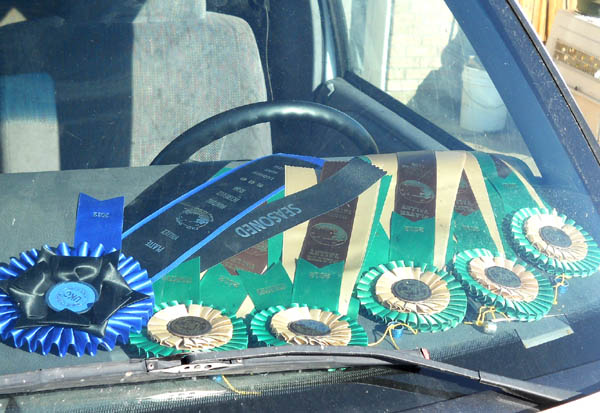
Ready to do it again?
I hope so!
Take stock of how you and your dog did and what weaknesses you should work on. Make a plan for how you can do better next time.
Other organizations
There are other retriever competitive associations:
This post was originally published on January 24, 2022. Edited and updated with new content on July 12, 2024.
Header image by Linda Alexander.
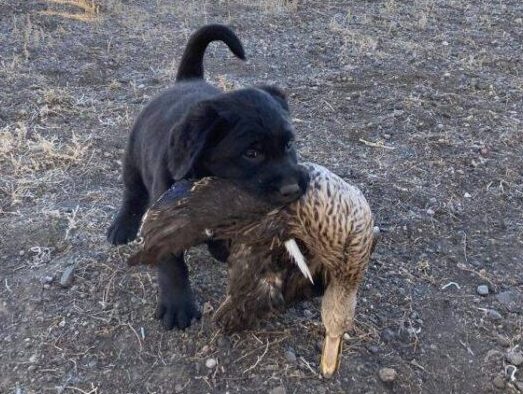
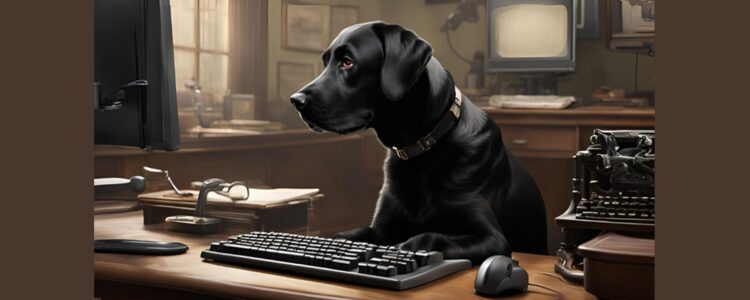
Browse this list of helpful links for Labrador Retrievers – clubs, competition, health issues, and more.
To request a link to a Lab club website or other helpful link or to update an existing link, please contact us.
National & International Dog Clubs
American Kennel Club (AKC)
Canadian Kennel Club (CKC)
Federation Cynologique Internationale (FCI)
The Labrador Retriever Club Inc
Master Amateur Retriever Club (MARC)
Master National Retriever Club (MNRC)
North American Hunting Retriever Association
Dog show info
List of AKC Licensed Dog Show Superintendents
Hunt test and Field trial entries
Health
American College of Veterinary Ophthalmologists (ACVO)
American Veterinary Medical Association
ASPCA Animal Poison Control Center, 24-Hour Emergency Number
888-426-4435
Animal Health Diagnostic Center
Genetic & Health Testing
US Labrador clubs
Dallas-Fort Worth Labrador Retriever Club
Greater Atlanta Labrador Retriever Club
Heart of Texas Labrador Retriever Club
Huron River Labrador Retriever Club
Labrador Retriever Club of Greater Denver
Labrador Retriever Club of the Pioneer Valley
Labrador Retriever Club of Southern California
Labrador Retriever Club of the Potomac
Mid-Jersey Labrador Retriever Club
Puget Sound Labrador Retriever Association
San Diego Labrador Retriever Club
Spirit of St. Louis Labrador Retriever Club
Winnebago Labrador Retriever Club
Lab links
Coat Color Inheritance in the Labrador Retriever
Other
Dog Lovers Bookshop (hard to find used, out of print and rare books)
Therapy Dogs International, Inc. (TDI)
Header image AI generated via Canva
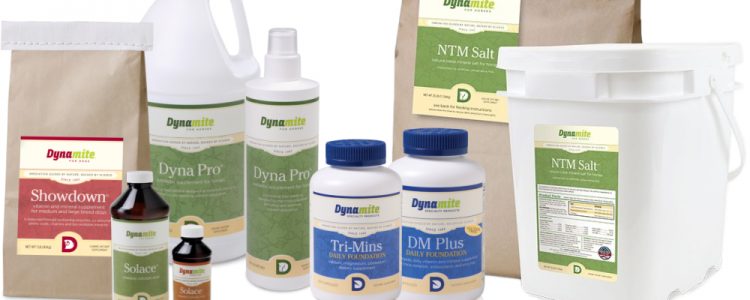
Dynamite products are made in the United States for better quality control, and using only natural ingredients.
“Its manufacturing processes are so stringently controlled that Dynamite has a separate mill to produce feed for herbivores, such as horses and poultry that are especially sensitive to contamination from meat needed by other species such as dogs and cats.”
I’m proud to be a Dynamite distributor for over 20 years!
I’ve had great results for both my animals and me. But because governmental regulations won’t allow us to make therapeutic claims, we can only tell you how we’ve used the products and share some stories from other people.
Stories and results
Free & Easy for People
As an aircraft mechanic, my husband misused his hands every day. That’s on top of a bad habit of popping his knuckles.
He tried soaking his hands in warm water every morning to make it easier to open and close his hands. I gave him a bottle of Free & Easy, but didn’t think he’d take them. When he did, I realized just how much he hurt.
He never said anything though. That is, until a few days after he ran out and had to resort to bathing his hands in warm water again. He actually asked for more F&E!
Free & Easy for Dogs
Story in a nutshell: Have an Australian Cattle Dog who will be 11 years old this August. He injured himself, caught his rear paw when running onto the deck early on.
He favored it on and off for quite some time. Got tired of meds from vet when he seemed to be favoring it from time to time. He actually got to a point, at one time, that he couldn’t go up the stairs.
So, looked for a more holistic approach. Researched the internet and found a site with testimonials on Free and Easy. Then researched the best price to buy which was from you.
At the time I began using Free and Easy also switched him to an organic, high quality dog food to which I add a spoon of pureed celery to each meal, as celery contains alot of water content which aids the joints in arthritic situations.
The vet not convinced about this, but I find the results to be good. And the rest is history. Don’t know if it is one item or combination of all, but he has not been on meds for this condition for years now.
R Witalec
DynaCoat
Well it worked, back to back Winners Bitch (had not earned any points for the previous two years).
Sandy Nixon
Showdown
The dog’s coats are what people comment on the most. They look like they have just been bathed they are so shiny. Their gums have a nice color as well.
Captain Tim Bradbeer
Beach and Bay Charters
Showdown
Bow is doing great. Still a ball of energy at 8 years and no signs of slowing down.
Robin Thorne
DM Plus, TriMins, Free & Easy and PMS
For years my mother would tell me every day that she needed to lay down because her back hurt.
Her doctors had her taking calcium pills for osteoporosis plus 800 mg Tylenol whenever she had pain. But it wasn’t until she came to live with me that I found out about the variety of medications she was taking.
The years of taking inorganic calcium had given her bone spurs and the daily Tylenol was causing other problems. So we weaned her off the medications that were contraindicated, provided her with better food choices, and started DM Plus, TriMins, Free & Easy and PMS.
The difference was almost immediate. In the almost 4 years she lived with me, I can only remember one time she had to lay down because her back hurt.
Products I’ve used and swear by
~~ For bumps, bruises, and immune support ~~
Solace
If I could only have one of the Dynamite products it would be a toss up between Solace and DynaPro. We’ve used Solace (200 ppm colloidal silver) topically and internally, usually diluted with distilled water, but occasionally full strength. For example, we used it combined with a homeopathic for cough when our dogs came in contact with kennel cough. They finished coughing within 24 hours, but a neighbor’s dogs continued coughing for two weeks.
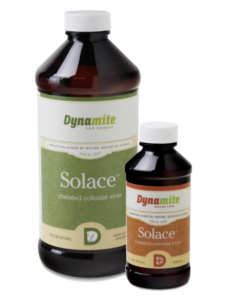
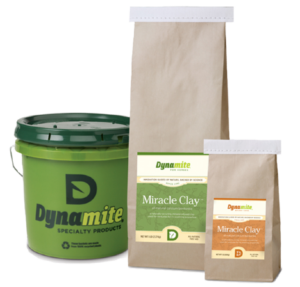
Miracle Clay
We’ve used Miracle Clay on all sorts of minor problems from bee stings, to bug bites, to rashes, to other swellings. We have wasps who give a nasty sting, but using a dab of activated Miracle Clay stopped the stinging within seconds. It’s been called a “Healing Gift from Mother Earth.”
Release
We’ve used it on sore muscles, blisters, and wounds. I even spray some on my face when I’ve been staring at the computer screen for too long.
Relax
We don’t use this product much anymore, but it’s been helpful for stressful situations such as the first trailer ride or a farrier visit.
My Labs are conditioned to gun fire from puppy-hood so July 4th fireworks don’t bother them at all. Not so for some dogs. Relax has helped other dogs get through that stressful day and adding Tranquil can provide additional help.
If your dog is stressed by fireworks, here’s a video that talks more about Dynamite’s Relax and Tranquil.
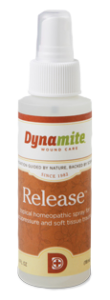
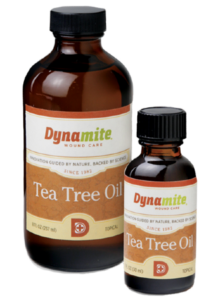
Tea Tree Oil
Cuts, scrapes and other injuries are topped with TTO. We’ve used it on us and the horses. However, I don’t recommend it for dogs unless it’s been very, VERY diluted.
Trace Minerals Concentrate
Whenever we need to stop minor bleeding, we use Trace Minerals Concentrate.
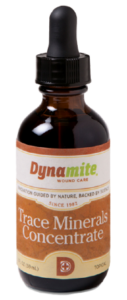
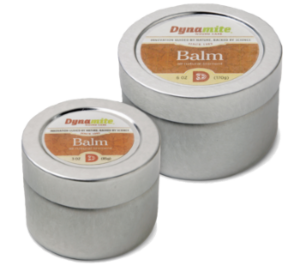
Wound Salve
We use Wound Salve on open wounds, usually with Solace and/or Tea Tree Oil.
Balm
We’ve had great results using Balm on bruises, old scar tissue, and even dry heels (prep for sandal season). By the way, Balm is used on closed wounds, while Wound Salve can be used on open wounds.
Izmine
“Izmine™ is an unusually effective mineral food containing more than 70 naturally-occurring minerals, enzymes, electrolytes and bio-nutrients in a readily-assimilated form. Its natural acidity contributes to its high degree of assimilation.”
It helped my dog recover after an ACL tear and helped my mom’s arthritis in her hands and back. They both also took Free & Easy.
Here’s a story about how Izmine was used to help dolphins who lived in chlorinated water. And when it was used to help a penguin that developed a large goiter.
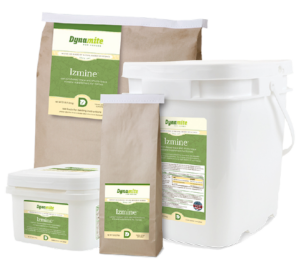
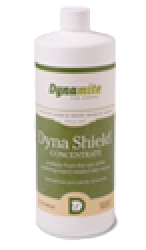
Dyna Shield
Love summer, but hate the bugs?
I’ve tried all sorts of products to keep bugs at bay, not only because they’re annoying, but also because they transmit diseases. Can’t say I’ve ever liked the stickiness and horrible smell though.
Then I tried Dyna Shield. It’s a concentrate that can be diluted at various levels to be used on horses, dogs and. people. It does have a smell, but more herbal than chemical. And it works well for my animals and me.
~~ For our canine companions ~~
Super Premium Dog Food
I’ve tried several premium brands of dog food and this one has given us great results.
It’s made with fresh, hand-trimmed USDA chicken, plus fish meal and salmon oil with only minimal processing. This helps preserve the natural goodness of the ingredients. NO corn or wheat. 24% protein, 16% fat. It comes in 8-pound and 40-pound bags.
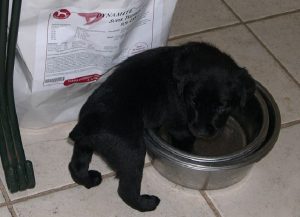
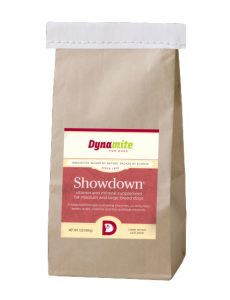
Showdown for Dogs / Showdown Pro
We started our Dynamite journey using Showdown and noticed quite an improvement in our dogs’ health. Coats became thicker and, in the case of chocolate Labs, a darker color.
We supplement breeding females with Showdown Pro, starting before breeding and continuing through weaning the puppies. The girls have maintained better condition and puppies get off to a great start.
DynaPro
I wouldn’t be without it! Anytime the dogs get stressed they get a couple of drops in their mouths or on their food. Weather changes, competition, breeding can all cause stress. By the way, we get the DynaPro for horses – same formula, bigger bottle, better price.
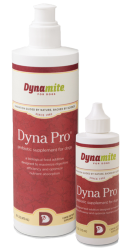

Free & Easy for Dogs
Our older dogs get Free & Easy six days a week.
One of our dogs was diagnosed with a partially torn ACL and the vet recommended immediate surgery. We chose instead to try conservative management (straight to rehab, skipping the surgery). It took awhile, but he went back to competing in hunt tests, obedience, and rally trials thanks to Free & Easy and Izmine.
Herbal Tonic
Twice a year we give our dogs Herbal Tonic to avoid having to use harsh chemical wormers. To be safe, we also test for heartworm.
For tips on how to use Herbal Tonic (and supporting products), check out Parasite Control: Balance vs. Eradication by Judy Sinner.
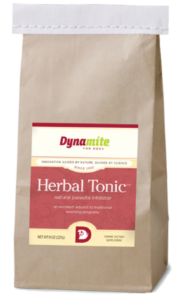
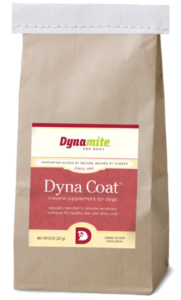
Dyna Coat
For show dogs, we’ve found DynaCoat has helped put on that extra bit of coat.
We also gave it to a dog that generally had a rather sparse coat. Within a few weeks she developed a nice plush coat. She even grew hair along her belly and inner thighs where she never had hair before.
~~ For people ~~
DM Plus
Yep, I take my vitamins too! Why take chances? I certainly don’t have the time to eat as well as I should, and I know with Dynamite I’m doing something good for the only body I will ever have.
Tri-Mins
As part of the Dynamite basic program, we take Tri-Mins for the additional minerals.
Some people have asked why Tri-Mins is separate from DM Plus. It’s because we each have different needs for the minerals in Tri-Mins (calcium, potassium, magnesium) and this allows you to adjust the amounts as needed.
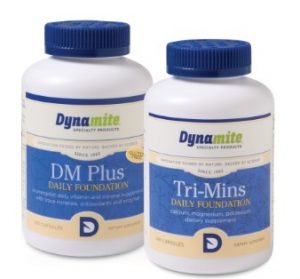

180
Worried about packing on the pounds during the holidays? I lost 30 pounds in two months using this 180 protocol and, overall, I found it to be pretty easy.
Elixir
I started the Dynamite program by taking Elixir mixed with water every day for 60 days. Now I take it whenever I feel a bout of heartburn coming on which, thankfully, isn’t very often.
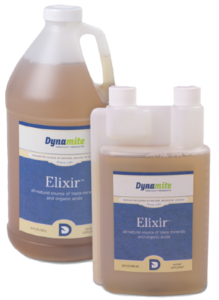
Horse products
Although my horses are leased out to a family with several children, they also get Dynamite products.
I like the Dynamite Plus for the additional coenzymes and herbs to help calm and balance the gut pH. (Regular Dynamite would be a good choice for a horse in competition.)
We also offer the Free Choice Minerals so each horse can eat as much or as little as they need.
When we were breeding horses we also used Breeder Pac. And, of course, they also get DynaPro and occasionally Herbal Tonic.
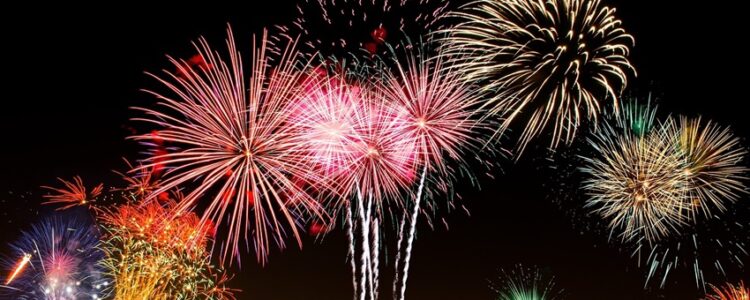
Loud or unexpected noises like fireworks or thunderstorms can be frightening for some dogs.
From flashes to booming sounds, the startling nature of fireworks trigger the “fight or flight” effect in dogs. This causes dogs to decide fireworks are a threat or potentially harmful, which can turn into fear and panic.
Reactions to fireworks
Fireworks are scary to dogs because they’re loud, unexpected noises. This is especially true if they haven’t been exposed to these sounds or have had a traumatic experience around fireworks. Sometimes they can learn to be scared of them from other dogs.
Research shows at least 40% of dogs have noise-related phobias. This definitely includes fireworks, which trigger a stress response that affects your dog’s overall health. Depending on how close you are, fireworks can also hurt your dog’s hearing as they ring in at 120 decibels.
However every dog reacts to fireworks differently. You can have one dog who sleeps through fireworks without a second thought and one who panics at the first “pop.”
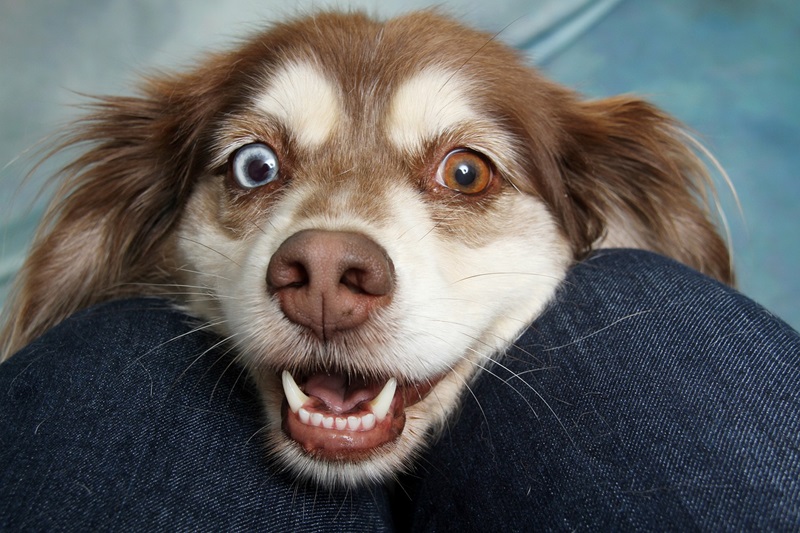
Symptoms of fireworks phobia in dogs
The most common symptoms seen with firework phobias are shaking and trembling. Other possible symptoms include:
- Hiding or cowering
- Holding their ears flattened
- Wide pupils
- Barking, whining, howling
- Panting
- Drooling
- Broken teeth, cuts or ripped nails from trying to escape
- Defense aggression
- Urinating or defecating indoors
The good news is there are several ways you can help him through it. We’ve outlined below how to tell if fireworks are negatively impacting your dog, and what you can do about it.
What to do on days you expect fireworks
- Stay with your dog. He could panic if left alone. Having you or someone he knows and trusts for company will help him relax.
- Don’t go out after dark. Make sure you’re cozy inside and settled well before any fireworks start. Never force your dog outside during fireworks.
- Give your dog any prescribed medication before fireworks start.
- Check that your house and garden are escape-proof. Your dog may try to run away if he’ scared.
Create a Safe Space
Create a place where your dog will hopefully feel comfortable and get him used to it beforehand. Dogs are den animals – they’re looking for that cave to get away from it all.
Try setting up an area in a quiet space away from windows so that he can’t hear or see fireworks. It might be in the basement or a larger closet. Use a crate if that’s where your dog feels safe, and make sure to provide him with familiar toys and treats.
A big part of why fireworks scare your dog are the sounds and bright lights. So closing the curtains and covering his crate will dampen the sound and the flashes of lights. It will help your dog feel safe and secure. Also be sure to include his bed, toys, and a familiar blanket.
If you know your dog is frightened by fireworks, you can set up a safe space weeks in advance. This will give him time to become accustomed to it. Encourage your dog to see this as a safe space by spraying pheromones, offering treats, or leaving one of your worn t-shirts.
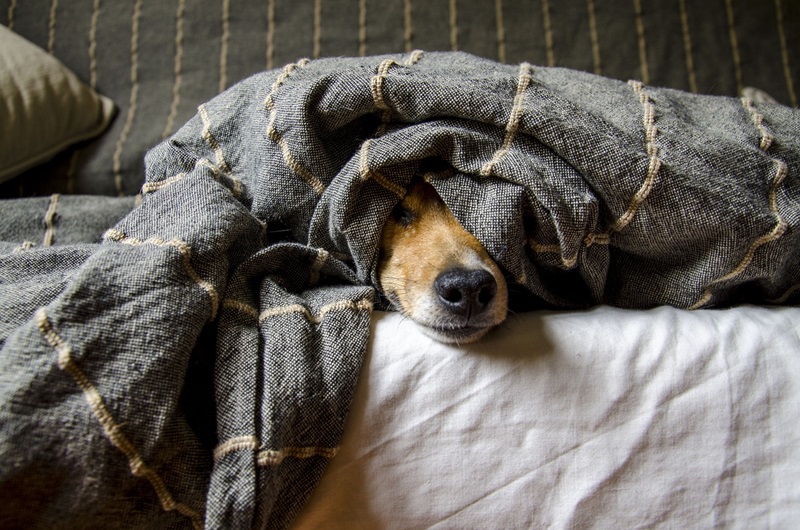
Play White Noise or Music
You can try leaving a fan, TV, or sound machine on to help mask the sounds of the fireworks. By masking the sounds of those crashes and booms, you can quickly reduce his stress levels.
When choosing what type of sounds to play, consider classical music. In a recent study, playing classical music in animal shelters helped dogs spend more time sleeping or laying down and less time barking.
Keep the volume low enough that your dog can hear it, but it doesn’t cause him stress. Watch for panting, pacing, leaving the area, or trying to hide. Dogs learn better when they’re not stressed.
When your dog does well at a lower sound level, try increasing the volume gradually. You want to get him used to listening to sounds that are just loud enough to camouflage the sounds that frighten him. You can still hear the fireworks, but it’s mixed in with other sounds so it’s not as jarring.
Here are a few YouTube videos to check out:
Relaxing Music for Dogs to Calm Down | GREAT FOR FIREWORKS!
Dog’s favorite music, Dog sleep music, Stress relief and Separation anxiety music, Stability music.
12 Hours Anti Anxiety Music for Dogs Stress Relief Music For Dogs ♬ Calming Music For Dogs
You may want to listen to a few to see if they might work for your dog. Especially check for ads that can be jarring, instead of soothing. If that happens, switch to a different video.
Tips:
Keep the volume at a level that masks fireworks, but isn’t too loud.
Start playing the sound a few hours before the fireworks begin to acclimate the dog.
Hang out with your dog to help him feel even more secure.
Fireworks Desensitizing Training
If your dog is sensitive to fireworks noise and it’s still a few weeks away, you can try desensitizing training. Start by playing with your dog and then turn on the sounds of fireworks, but keep the sound low.
The goal is to get your dog to relax and not worry about the whizzes and bangs of the fireworks. You may need to repeat this several times. When your dog seems comfortable, try increasing the volume slightly.
Next is simulating the exact scenario your dog will face when the real fireworks start. Put him in his safe space and add some treats or toys. Try closing the curtains or wait until after dark. Turn the fireworks noise on low. Make gradual changes so you don’t overwhelm him all at once.
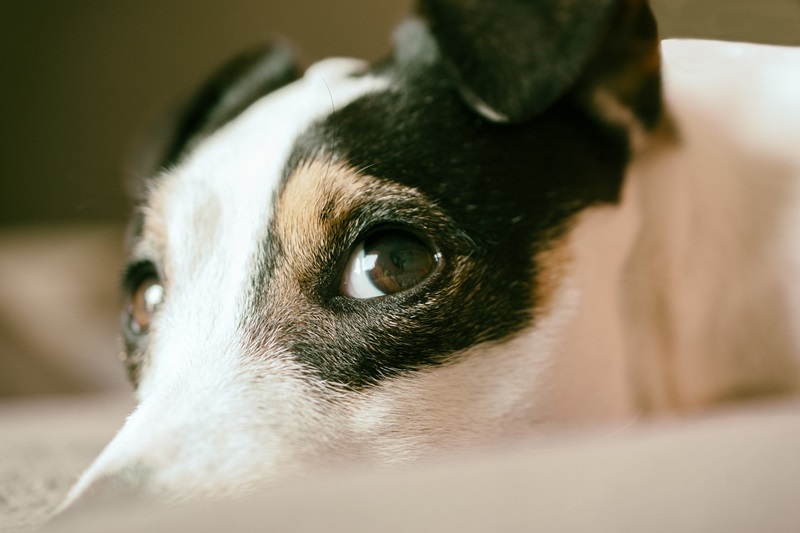
Use a Lick Mat
Licking is a self-soothing act that helps your dog’s body release a happiness hormone to help him relax. To encourage licking you can pick up a lick mat and cover it with a tasty spread. Lick mats not only keep your dog entertained, they can reduce stress and anxiety plus slow down fast eaters.
When choosing a mat look for the correct size (not too big or too small), made from high-quality materials such as silicone, and dishwasher safe. I found mine online.
Here are a few ideas of what to spread on the pad:
- canned dog food
- mashed bananas
- canned pumpkin – not the pie filling
- peanut butter – check that it does not contain xylitol
- yogurt – low-fat, plain yogurt
- sardines packed in water
Be sure to count these calories so your dog doesn’t put on unwanted weight.
If you have a fast eater, you can spread a tasty treat on the mat and freeze it before serving.
Don’t forget to clean the mat after use. Rinse with warm water, then gently scrub using mild soap, and finish by rinsing well and letting it air dry.
Exercise Before the Fireworks Start
Dogs with pent-up energy tend to be more reactive than those who have been well exercised. Exercise also releases endorphins, which are “happy” hormones.
Double-check the fit of your dog’s collar or harness before going outside. A leash is an added safety measure to keep your dog close to you and under control in case they are startled.
Go for a run. Play fetch. Take a long walk. Have a play date with a canine pal.
Just make sure you exercise your dog and are inside again well before any fireworks could start.
Calming Products
If you dog shows signs of fear in response to fireworks or loud noises, talk with your vet to see what he recommends. Here are some products that might help:
- Medications: Sileo® helps dogs cope with anxiety during thunderstorms and fireworks.
- Pressure wrap or anxiety vest: These wrap your dog in a warm hug. The gentle pressure can help release calming hormones. In a pinch you can use an Ace bandage, criss-crossing it from his fore chest to shoulders and around his rib cage. Make it snug, but not tight.
- Pheromones: Dog-appeasing pheromone (DAP, or Adaptil®) mimics the pheromones produced by a mother dog, creating a sense of well-being in dogs. It’s available as a room diffuser, spray, or collar and can help your dog’s firework anxiety.
Plan for emergency situations
The Fourth of July represents the worst day for lost pets as dogs attempt to escape frightening sounds. And those panicked flights are dangerous. Many dogs won’t stop running during firework displays until they are completely exhausted, injured, or killed.
If you’re thinking about going somewhere else for the evening, you might want to reconsider. Whether to country or city, there’s still likely to be fireworks nearby. What might happen if he gets away from you, especially if he’s in an unfamiliar area. He would likely be safer at home, tucked away in a crate.
Just in case, make sure your dog is microchipped and his information is up to date. Second best is wearing a well-fitting collar with ID tags. Also have your veterinarian’s contact information handy, plus contact information for anyone who can help search for your dog, if necessary.
Post-Event Recovery
And don’t forget that it can take 8-12 hours for the stress of the fireworks anxiety to dissipate. Plan to stay in for the remainder of the night. You never know when a stray “pop” may trigger that fear and send your dog back into a panic.
If your dog has to go out to potty, be sure to use a sturdy collar and leash.
—
The information provided in this website should not be used to diagnose or treat a health problem or disease; it is not intended to offer any legal opinion or advice or a substitute for professional safety advice or professional care. Please consult your veterinarian for professional advice. This content is for educational purposes only.
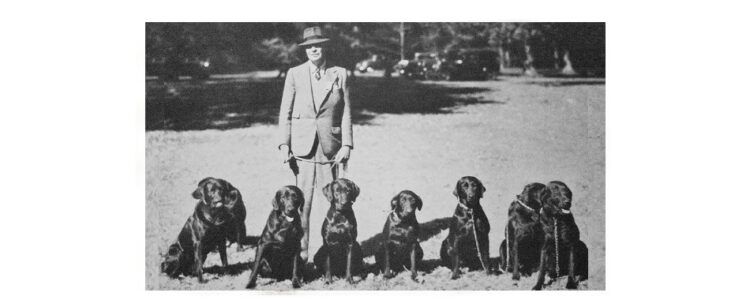
Jay Carlisle (and his Wingan Kennel) was “…undoubtedly the one to whom most credit is due for the rise in the popularity of Labradors in the U.S.A.”
– Labrador Retriever Club Yearbook, 1931-1944
Imagine, if you will, the sprawling mansions, huge parties, and nouveau riche of The Great Gatsby era. The Great War had ended, Prohibition brought speakeasies and organized crime, and the stock market crashed. It is in such a setting we find Jay Carlisle and his Wingan Kennel.
Born in Brooklyn in 1868, Carlisle was a stockbroker and the Governor of the American Stock Exchange during the 1929 crash. His wife was Mary “May” Pinkerton Carlisle. (Yes, that Pinkerton family.)
Carlisle was also a sportsman. His horses ran on the track or competed in shows. He rode to hounds and played polo. And he fished and hunted.
We pick up his story when Carlisle turned his attention to Labrador Retrievers.

Image courtesy East Islip Historical Society – www.eastislip.org
Step 1 – Import the Best Labradors
Jay Carlisle liked a good-looking dog, but he wanted more. He wanted dogs with an acceptable show record and qualified in the field. “Once Mr. Carlisle had decided that the Labrador was to be his breed, he began a study of existing blood lines. He went over countless records, and all the time he had in mind the qualities that he wanted.” 1
After breeding, raising, showing, and racing horses, he developed a discerning eye. However, in the early 1930s, the Lab was still new to America and field trials were just getting started. Carlisle promised to make the breed as popular in America as it was in Britain.
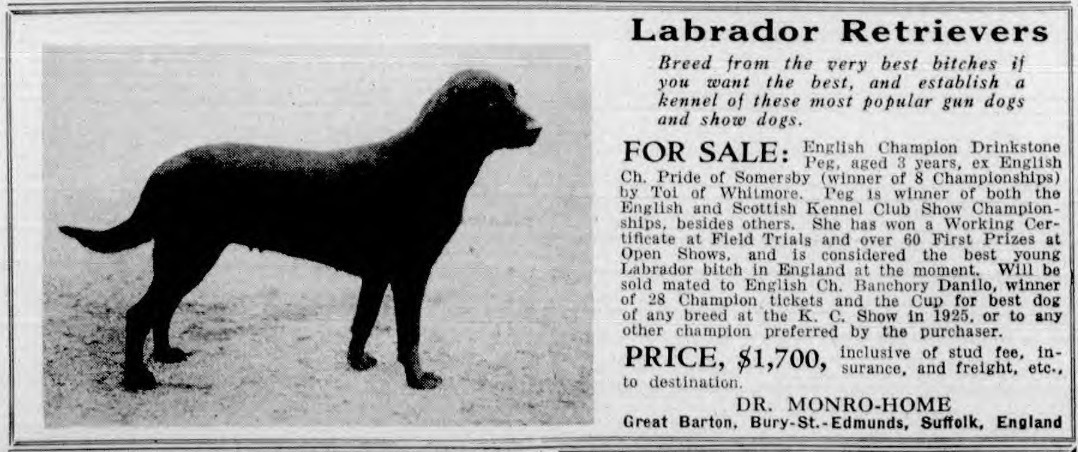
Peg was offered for sale for $1700. Today’s equivalent is about $30,000.
After researching, he imported nine of the finest Labs to start his kennel. The best of these was English Champion Drinkstone Peg of Wingan. She was born in 1927 and bred by Dr GH Monro-Home of Scotland.
Of the other eight Labs, three came from Lorna, Countess Howe.
Eng Am CH Drinkstone Peg of Wingan
Peg was sensational in the show ring and earned nine Challenge Certificates which are similar to ‘winning the points’ in America. Three certificates were enough for a championship, but she kept on winning.
In England there is a ‘show championship’ and a ‘full championship’. A full championship requires the dog to prove it can work in the field as well as win in the show ring. Peg earned her working certificate at the International Gun Dog League retriever trails in 1930 and became a full champion.
She also won her show championship in America. But despite being a top show dog, Carlisle was more interested in Peg’s potential for breeding. Of course the male is also important so he had her bred to Dual Champion Bramshaw Bob. He was one of England’s greatest show dogs and stud dogs.
Two months later Peg whelped seven puppies at Carlisle’s Wingan kennels.
After raising her puppies, she went back into the show ring and continued winning. One of her big wins was Reserve at the Westminster Kennel Club show in 1934.
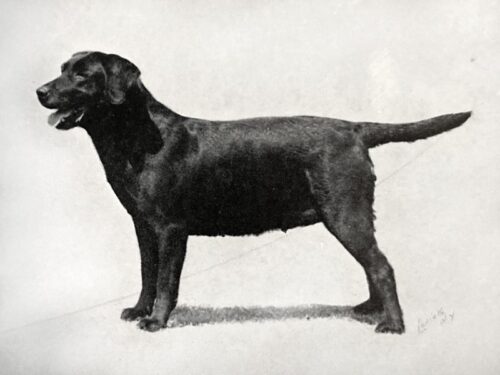
| Eng Am CH Drinkstone Peg of Wingan black female, born 4/18/1927 |
Toi of Whitmore FTW | Tyg of Whitmore |
| Bute of Trentham | ||
| Eng CH Pride of Somersby | Brayton Siddy | |
| Juno of Somersby FTW |
CH Drinkstone Pons
Another dog Carlisle imported was Drinkstone Pons. He was Peg’s son sired by English Champion Banchory Danilo and bred by Dr Monro-Home.
Pons started his show career as a puppy. He won many prizes and was often chosen as the best Labrador, best retriever and/or best gun dog. Pons won Best of Breed at the Westminster Kennel Club show – twice – and also won second in the group competition. He won Best in Specialty Show at the annual Labrador Retriever Club Inc. show.
In 1934 he started running and placing in field trials. He won the Open novice stake the the Brookhaven Game Protective Association trial with kennel mates Night Light and Ben taking second and third. A New York Times reporter said “The placed dogs showed the influence of the highest breeding, combined with thorough training. All the Wingan representatives exhibited intelligence in their hunting, with a minimum of direction from their handler.” 2

| CH Drinkstone Pons of Wingan black male, born 5/11/1931 |
Eng Ch Banchory Danilo FTW | Eng Dual Ch Banchory Bolo |
| Munden Scarcity | ||
| Eng Am Ch Drinkstone Peg of Wingan | Toi of Whitmore FTW | |
| Eng Ch Pride of Somersby |
Drinkstone Mars
Mars was another outstanding dog. He often won in the show ring and earned his certificate of merit under judges Countess Howe and the Honourable Mrs. Hill Wood.
Pons and Mars were littermates and won the brace class together. Mars won the points toward his show championship at the Labrador Retriever Club Inc. specialty show in 1934. And as a dual purpose Labrador, he also won in field trials.

| Drinkstone Mars of Wingan black male, born 5/11/1931 |
Eng Ch Banchory Danilo FTW | Eng Dual Ch Banchory Bolo |
| Munden Scarcity | ||
| Eng Am Ch Drinkstone Peg of Wingan | Toi of Whitmore FTW | |
| Eng Ch Pride of Somersby |
CH Liddly Bulfinch of Wingan
Bulfinch was another import and was bred by H.A. Richardson. He won about 50 times at championship shows and certificates of merit at field trials.
And he won the points at the Labrador Retriever Club Inc. annual specialty show in 1935. This means he defeated the other non-champion males and earned points toward his show championship.
Bulfinch completed his championship with a 4-point win at the Long Island Kennel Club show in May 1936.
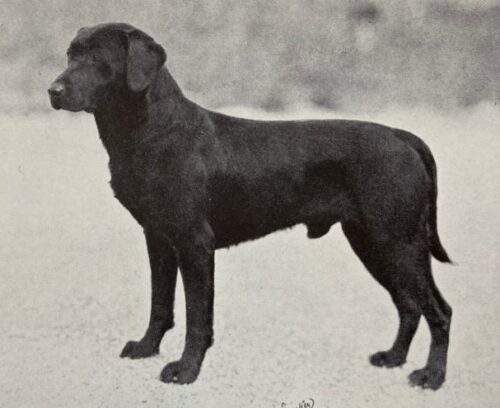
| CH Liddly Bulfinch of Wingan black male, born 2/7/1932 |
Eng CH Tar of Hamyax | Toi of Whitmore FTW |
| Sunshine of Fasham | ||
| Delyn of Liphook | Eng CH Banchory Danilo FTW | |
| Ridgeland Black Diamond |
FC Banchory Night Light & CH Banchory Jetsam
Banchory Night Light and Banchory Jetsam were littermates sired by Blackworth Midnight. They were bred by Miss L. Croad of England.
In 1935 Field and Stream Magazine began offering a challenge trophy to the dog that earned the greatest number of points. Only competition in Open All Age Stakes counted.
Night Light was one of the top Labradors and earned 12 points in the contest. Banchory Varnish of Wingan earned 10 points and Glenairlie Rover was tied with Blind of Arden at eight points.
He was a Field Champion and major pointed in dog shows. Jetsam was a Show Champion which included winning the points at the Westminster Kennel Club show in 1934.
Tops of Bigstone, Night Light’s daughter, produced several quality dogs. These included Dual CH AFC Matchmaker for Deer Creek, FC AFC Ladies Day at Deer Creek, and Kingdale’s Ink Spot.
It’s interesting that Night Light carried the chocolate gene while his sister, Jetsam, carried the yellow gene.
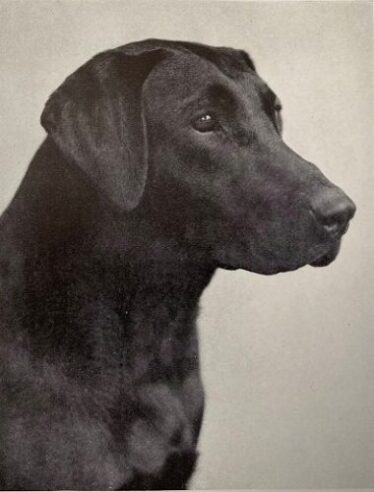
FC Banchory Night Light of Wingan

CH Banchory Jetsam
| FC Banchory Night Light of Wingan black male, born 1/1/1932 CH Banchory Jetsam black female, born 1/1/1932 |
Blackworth Midnight | Eng CH Wilworth Rip |
| Brookstone Jet CCW | ||
| Dinah of Wongalee | Eng CH Beningbrough Tangle FTW | |
| Wendy of Wongalee |
Banchory Dapper
Banchory Dapper was a half brother of Night Light and Jetsam, all sired by Blackworth Midnight. He won a 5-point major at the Labrador Retriever Club Inc. specialty show in 1934.
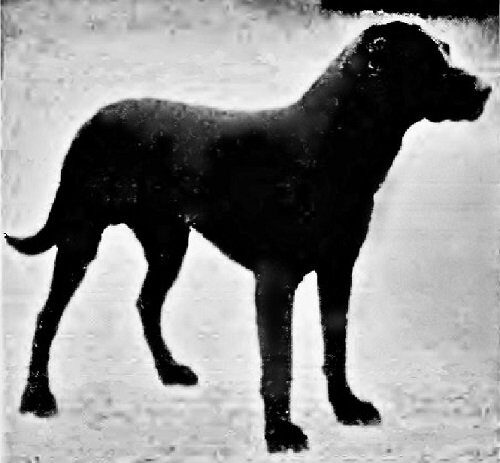
| Banchory Dapper black male, born March 1932 |
Blackworth Midnight | Eng CH Wilworth Rip |
| Brookstone Jet CCW | ||
| Banchory Student | Eng CH Banchory Danilo | |
| Eng CH Pride of Somersby |
Orchardton Doris of Wingan
Orchardton Doris was bred by S.H. Carruthers and worked as a field dog in Scotland.
After coming to America she was described as “a high class bitch with beautiful style, great pace and very keen… She and her handler, Dave Elliot, gave a beautiful exhibition of giving and taking direction to an unmarked fall by hand and whistle, without undue disturbance of ground on either side. She has an invariably excellent pick-up, carry and delivery.” 3
A fast and expert retriever, Doris also had several wins in the show ring.
She was the mother of Pons Junior of Wingan and Wingan’s Daily Double and the grandmother of FC Timber Town Clansman.

| Orchardton Doris of Wingan FTW black female, born 12/31/1930 |
Eng Ch Ingleston Ben | Duke of Kirkmahoe FTW |
| Ingleston Nancy FTW | ||
| Orchardton Dawn | Eng CH Brocklehirst Donner | |
| Hardies Choice |
Eng Sh CH Am CH Banchory Trump of Wingan
The ninth dog, Banchory Trump, stayed in England until he finished his show championship. After coming here, he finished his American show championship with Best of Breed wins at the Westminster Kennel Club dog show and at the Labrador Retriever Club Inc. specialty.
He won numerous Bests of Breed awards and placed in the group several times.
His Best of Breed winning streak included several very competitive shows:
- Morris & Essex, 5/23/1936
- The Labrador Retriever Club Inc, 6/27/1936 – Best In Specialty Show
- Morris & Essex, 5/29/1937
- The Labrador Retriever Club Inc, 6/18/1937 – Best In Specialty Show
- Westminster Kennel Club, 2/10-12/1938
- International Kennel Club, 4/2-3/1938
- Leavenworth Kennel Club, 4/27-28/1938 – Best Of Breed and Group 3rd
- Des Moines Kennel Club, 11/12-13/1938 – Best Of Breed and Group 4th
Trump sired females that passed on excellent genetics. Bred to CH Bancstone Lorna of Wingan he produced Huron’s Lady, the mother of Dual CH Grangemead Precocious. When he was bred to a daughter of Eng FTCh Banchory Varnish of Wingan he produced Peggy of Pheasant Lawn. Peggy was the mother of FC Pickpocket for Deer Creek and Bancstone Dinah, grandmother of NFC AFC Massie’s Sassy Boots.
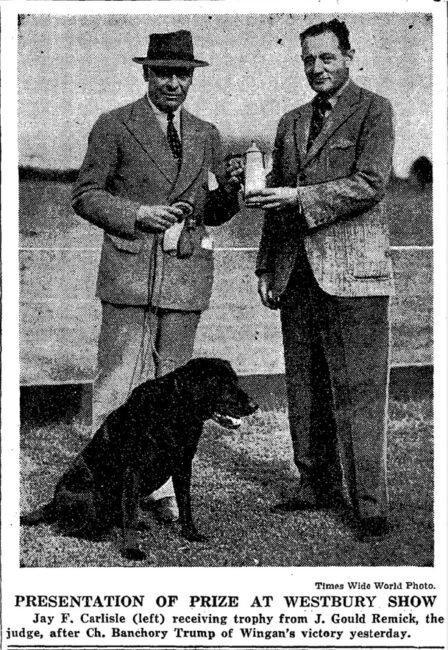
| Eng Sh CH Am CH Banchory Trump of Wingan black male, born 8/21/1931 |
Blenheim Scamp FTW | Balwearie |
| Blenheim Lady | ||
| Lady Daphne | Saffrons Bob CCW | |
| Haste |
Drinkstone Peg’s British litter
Below are Peg’s puppies by Eng Dual Ch Bramshaw Bob.
| Litter bred in England and born in America Born 8/7/1933 |
Eng Dual Ch Bramshaw Bob | Eng Ch Ingleston Ben |
| Eng FTW Bramshaw Brimble | ||
| Eng Am Ch Drinkstone Peg | Eng FTW Toi of Whitmore | |
| Eng Ch Pride of Somersby |
CH Bancstone Ben of Wingan
Owned by J.F. Carlisle
Ben placed in field trials and also did very well in shows. He finished his show championship with multiple five-point majors.
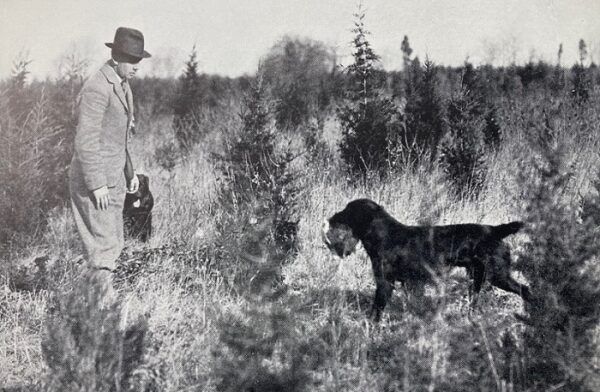
Bancstone Blair of Wingan
Owned by J.F. Carlisle
Although he wasn’t shown much he almost always won his class and even won Best of Breed.
CH Bancstone Bob of Wingan
Owned by J.W. Redmond
Bob also finished his show championship with three five-point majors – including at the Westminster Kennel Club dog show in 1937.
Bancstone Doctor of Wingan
Owned by J.F. Carlisle
Although Doctor was also shown, he didn’t finish his championship.
CH Bancstone Countess of Wingan
Owned by J.F. Carlisle
Countess won Reserve Winners Bitch at both the Westminster Kennel Club dog show and the Labrador Retriever Club specialty show. She finished her championship title with two 5-point and two 4-point major wins.
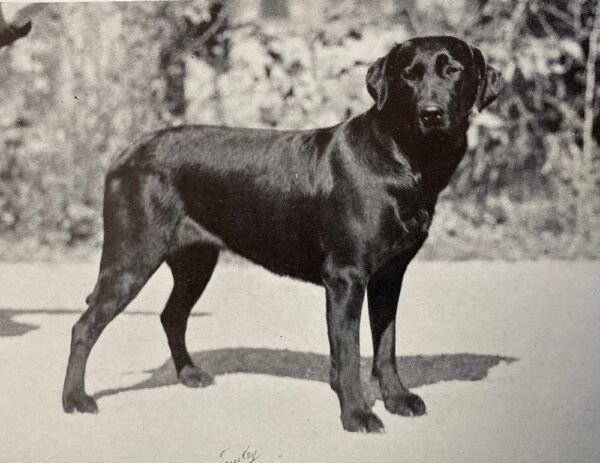
CH Bancstone Lorna of Wingan
Owned by J.F. Carlisle, later by James R McManus
Another Wingan-bred show dog that finished her championship with three 5-point majors. And she won Best in Specialty Show at the Labrador Retriever Club specialty show in 1935.
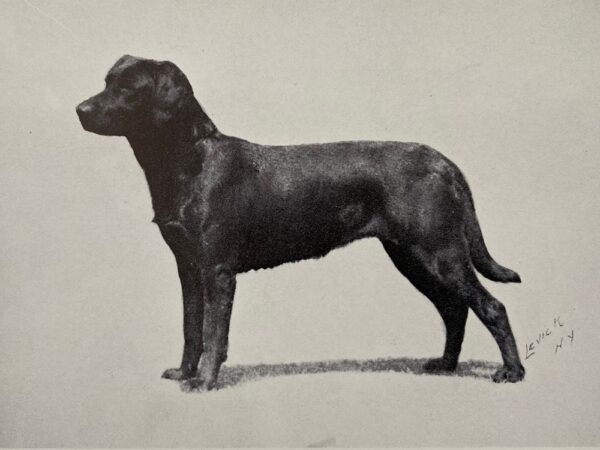
Bancstone Peggy of Wingan
Owned by J.F. Carlisle, later by C.H. Mackay
Although she was halfway to her show championship, it appears she never finished her title.
Other Labs
Carlisle had many dogs – some he bought and some he bred. Here are a few of his better known Labs.
Eng FTCh FC Banchory Varnish of Wingan
Owned by J.F. Carlisle, later by Mrs. Kathleen B. Starr (Timber Town)
In April 1937 Varnish won the Open all-age stake at the Long Island Retriever Field Trial Club. He was described as “consistent in his work throughout a long day … in which champions and top field-trial dogs fell by the wayside.” He “did all that was asked of him in his work on land, quartering, taking direction, showing intelligence in his questing and exhibiting nose for his game.” 4
He also won the Open stake at the Brookhaven Game Protective Association trial in the fall of 1937. “In the second series, his first bird was easy; but the second was dropped across the road in back of motor cars and gallery. The dog worked out the problem, however, and retrieved the bird in grand shape. In the third series, his speed and precision could not possibly escape the notice of the judges while his marking was exceptional.” 5
The gallery cheered their old-time favorite.
Varnish was also pointed in the show ring.
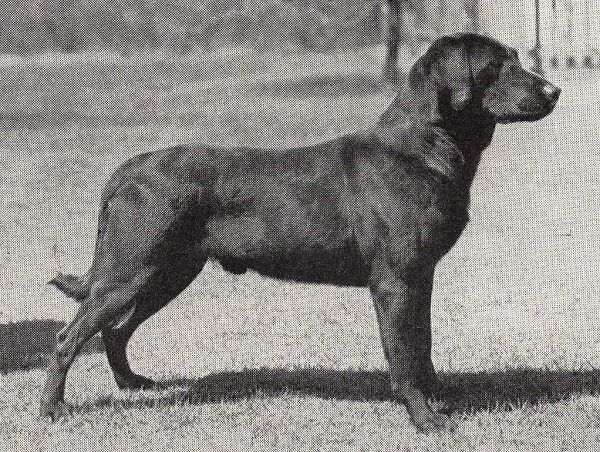
| Eng FTCh FC Banchory Varnish of Wingan black male, born May 1933 |
Eng Dual Ch Banchory Painter | Eng Ch. Peter the Painter |
| Glenhead Bess | ||
| Hawkesworth Glimmer | Banchory Tealer | |
| Bramshaw Gloss |
Pons Junior of Wingan
Pons Junior won the Brookhaven amateur trial handled by Mrs. Kathleen B. Starr (Timber Town kennels). He was described as making “two grand retrieves in the water test, going out on a surveyor’s line to both ducks.” The stake was judged by Colonel the Lord Vivian, D.S.O., of Britain, and David Wagstaff of Tuxedo Park, NY. 6
He also did well in the show ring including winning Reserve Winners Dog at the Westminster Kennel Club dog show in 1937.
A year later Timber Town Clansman, his two-year-old son, won the Women’s Field Trial Club non-winners stake.
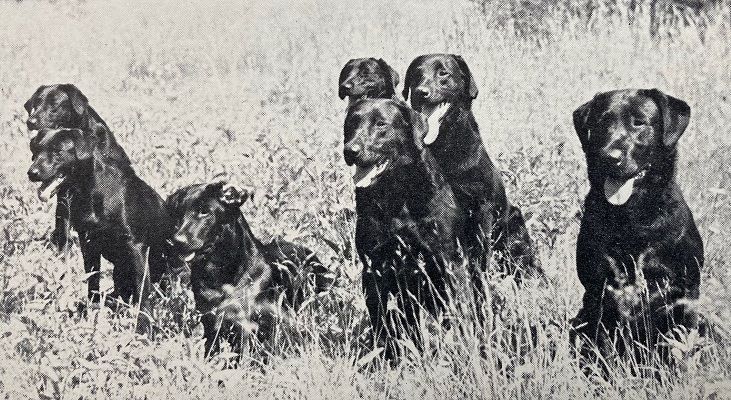
Rear, left to right: Pons Junior, Ebony of Barrington, Banchory Night Light, CH Drinkstone Pons. Front: Whitecairn Wendy, Banchory Varnish, CH Bancstone Ben.
| Pons Junior of Wingan black male, born 4/30/1934 |
Drinkstone Pons of Wingan | Eng FTCh Banchory Danilo |
| Drinkstone Peggy | ||
| Eng FTW Orchardton Doris of Wingan | Eng Ch Ingleston Ben | |
| Eng FTW Orchardton Dawn |
Okanagan Sandy
Sandy was bred in Canada and was special enough to earn a place at Wingan Kennels. One of the field trials he ran was under particularly difficult conditions.
“Six dogs were called back for the final elimination with the sea pounding on the outer bars, whitecaps making in the inlet and snow squalls driving inland. Dog after dog was sent into the icy water. Suddenly the black clouds closed down and the whole world was shut out by a driving snowstorm….
“Sandy’s water work was little short of perfection, he taking to the water with a huge splash, after having marked his two falls…” 7
| Okanagan Sandy black male, born 4/5/1934 Bred by R. Leckie Ewing, Canada |
Beaver of Bryn | Banchory Jock |
| Munden Stigma | ||
| Gay’s Vesta | Eng Nat’l FTCh Beningbrough Tanco | |
| Eng FTCh Vidi of Adderley |
Okanagan Tanco
Tanco was another import from Canada. In November 1936, he won the Derby stake at the Labrador Retriever Club trial in Peapack, NJ.
As the winner, he brought home the directors’ trophy and $25. Although that doesn’t sound like much it’s the equivalent of over $500 today.

| Okanagan Tanco black male, born 6/17/1935 |
Okanagan Rusty | Beaver of Bryn |
| Okanagan Gyp | ||
| Gay’s Vesta | Eng Nat’l FTCh Beningbrough Tanco | |
| Eng FTCh Vidi of Adderley |
Orchardton Duce of Wingan
Owned by Jay Carlisle, later by Mrs Eleanor F. Remick
Duce won the Labrador Retriever Club’s Derby stake at 14 months old. Colonel the Lord Vivian, D.S.O., of Cornwall, England judged together with Dr. Samuel Milbank and Francis Squires. The trial was held at Shinnecock Hills in Nov 1937.

| Orchardton Duce of Wingan black male, born approximately Sep 1936 |
Eng Ch Orchardton Donald | Eng Ch Ingleston Ben |
| Orchardton Dawn | ||
| Mona Of Ammurrness | Eng FTCh Tag of Clava | |
| Queen of the May |
Whitecarin Wendy of Wingan
Owned by Jay Carlisle
Wendy won the Open stake at the Brookhaven Game Protective Association field trail in 1935. The weather was described as “almost ideal, the thermometer hovering around the freezing mark, and the wind was just strong enough to make it a sporting proposition for guns and dogs.” 8

| Whitecarin Wendy of Wingan black female, born approximately 1933 |
Ranger of Kentford | Gift of Halleaths |
| Kirkbean Gyp | ||
| Lochar Kate FTW | Eng Dual Ch Banchory Bolo | |
| Murrayfield Bet |
Wingan’s Daily Double
Another Wingan dog deserving of mention is Daily Double. Bred by Carlisle and sold to Howes Burton, an amateur, who handled her himself. She won at the Long Island Retriever Field Trial Club in 1939 and placed second in what was called “fast company” just a week before. The winner in that trial was Earlsmoor Moor of Arden.
However what makes her special is the combination of pedigree and offspring. She was a half-sister to Blind and Decoy of Arden on her father’s side. And a half-sister to Pons Junior on her mother’s side.
When bred to Eng FTCh Glenairlie Rover, she produced Mint of Barrington who in turn sired NFC AFC Marvadel Black Gum “Blackie”.
Blackie was High Point Derby dog in 1946. He won his first Open stake at 16 months of age and finished his field championship the next year. And he qualified for eight consecutive National Opens (1946-1953), winning in 1949.
| Wingan’s Daily Double black female, born 7/9/1936 |
Odds On FTW | The Favorite FTW |
| Jest | ||
| Orchardton Doris of Wingan FTW | Eng CH Ingleston Ben | |
| Orchardton Dawn FTW |
Step 2 – Build the Best Kennels
Instead of a heated kennel building with attached runs, Jay Carlisle built condos for his Labs. He felt it would be hard for the dogs to go from a heated kennel to retrieving in icy water.
Each condo was 6×11 feet, made out of redwood and set on 4x4s to avoid rot. Inside were two rooms – a 5×6 foot vestibule that became a shaded porch in summer and a 6×6 foot sleeping compartment with a hallway to avoid drafts.
They even had lights, windows and a hinged roof for cleaning.
The condos were set in 20×30 foot concrete runs with trees for shade. Puppies had a similar set up in a larger grass run.

Nearby was the feed house where they stored supplies and prepared meals for the dogs. Puppies were fed five meals a day – cereal with milk in the morning, cooked beef, raw beef, milk and biscuit and a big-dog meal.
Adult dogs got cooked meat twice a week with commercial food, cod liver oil and yeast. Occasionally they got salmon or raw beef.
Step 3 – Import the Best Help
While Jay Carlisle was looking for the best Labs, he was also looking for someone to train the dogs. For that he looked to Scotland where many men learned the business as kennel men and game raisers.
With the help of Countess Howe and many others, Carlisle found the right man. In 1934 he brought David D. Elliot to Long Island from Scotland.

A few months later at the Brookhaven Game Protective Association trial they swept all three places in the open novice stake. Drinkstone Pons of Wingan won $50 for first place. That’s over $1000 in today’s currency. Second place and $30 to Banchory Night Light of Wingan. Third place and $20 to Bancstone Ben of Wingan.
Carlisle did indeed find the right man to run his kennel.
David D. Elliot
Elliot grew up near Edinburgh, Scotland, where he learned about sheepdog trials from his grandfather. Watching how the sheepdogs responded to signals gave him the idea to teach signals to Labs. A form of these signals is still used today to guide dogs on blind retrieves.
Lady Howe, Dr. Monro-Holm and David Black (breeder of Peter of Faskally) recommended Elliot as a kennelman for Carlisle. Elliot agreed to come for five years, but instead, he stayed for a lifetime.
In addition to training dogs, he also trained people. They included Dorothy Howe (Rupert), Joan Redmond (later Joan Reed, Chidley) and Kathleen Starr (later Mrs Fredricks, Timber Town). The ladies were sometimes called “Elliot’s Harem.” Cotton Pershall was another person who learned how to handle dogs at Wingan.
Carlisle was pleased with Elliot’s training and thanked him for introducing him to field trialing. The competition made him happy despite the recent death of his wife.
If you’d like to see Elliot and two of his retrievers – Eng FTCh FC Banchory Varnish of Wingan and FC Timber Town Clansman – check out the “Sky Game” video, filmed in 1939.
Step 4 – Promote the Kennel and Competition
Jay Carlisle registered Wingan as his kennel name in 1933.
He ran ads in a variety of magazines – from the AKC Gazette to Vanity Fair.

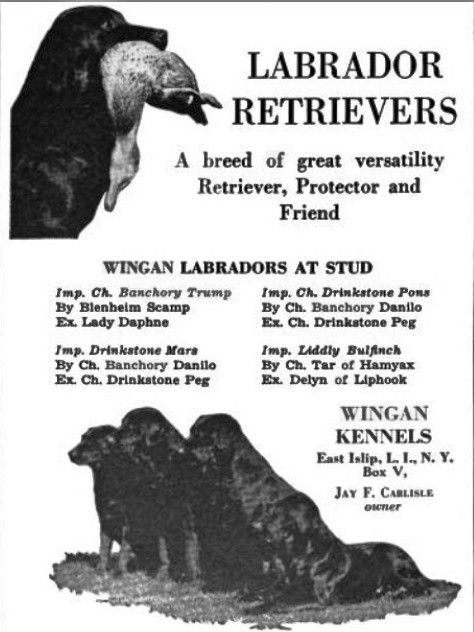

He served as President of the Labrador Retriever Club from 1935-1938. During that time he established the Amateur stake and donated a perpetual trophy so the stake would continue.
Carlisle, Anthony Bliss, Franklin Lord, Gould Remick, Henry Root Stern, and Leonard Buck formed the Long Island Retriever Trial Association. The club’s purpose was to encourage the breeding, training, and use of retrievers, and for holding of all-breed retriever trials.
David Elliot wrote a book about Labs and training them and Carlisle published it in 1936. It included training advice and many photos of Wingan Labradors.
“The efforts and absorbing interest of J. F. Carlisle, his participation in trials and at shows, and his generous offering of dogs at stud to new breeders gave the breed a tremendous push forward in this period. He helped to form a nucleus of good material to build upon, together with the superb group of imports… All this gave the breed the right start, and it was not long before history repeated itself, so that the Labrador was on its way to overtaking all the other Retriever varieties in the New World, as it had in the Old.” 9
The End and a Beginning
Jay Carlisle died in 1937, just eight months after his wife.
He was so respected, that 28 prominent men volunteered to act as pallbearers. A special train transported guests from Penn Station in New York City to Carlisle’s home in East Islip, Long Island.
The retriever community postponed a field trial so contestants could attend his funeral. However the postponement meant the trial had to be limited in order to finish in one day. This was the start of Limited All-Age stakes.
The Labrador Retriever Club, Inc. set up a Jay Carlisle Memorial Trial. It was held from 1938 to 1941 near his home on Long Island. Mrs. Hill-Wood, Morgan Belmont and Robert Morgan judged the first Memorial Trail.
On a sad note, the contents of his home went to auction in 1938 and his beautiful mansion was demolished in 1940.
Most of his dogs were given to the young Scotsman, David D. Elliot. He also received the specially-modified green and yellow dog wagon and the right to rent the Wingan kennel at a reduced rate.
Although it seems like a sad ending, the dogs did continue competing with Elliot. And many people recognized Carlisle’s contribution to Labradors and to field trials in America.

David Elliot (right) with Banchory Night Light winning the Field & Stream Challenge Cup for Outstanding Retriever of 1937.
Today
Few people recognize the Wingan name today or they confuse it with Helen Ginnel’s Whygin kennel. But Carlisle’s efforts – importing quality dogs, making his stud dogs available, and promoting Labradors – helped make the breed as popular in America as it was in England.
I’m proud to have several dogs that trace back to the Wingan Labradors.
— Chip and his descendants trace to –
* NFC Banchory Night Light of Wingan (grandsire of Dual CH Matchmaker for Deer Creek)
* Am Eng CH Banchory Trump of Wingan (grandsire of Dual CH Grangemead Precocious and FC Pickpocket for Deer Creek)
* CH Bancstone Lorna of Wingan (granddam of Dual CH Grangemead Precocious)
* Penney of Wingan (dam of NFC AFC Massie’s Sassy Boots)
— Dee and her descendants trace to –
* CH Banchory Jetsam
* NFC Banchory Night Light of Wingan (grandsire of Dual CH Matchmaker for Deer Creek)
* Am Eng CH Banchory Trump of Wingan (grandsire of Dual CH Grangemead Precocious and FC Pickpocket for Deer Creek)
* Eng FTCh FC Banchory Varnish of Wingan
* CH Bancstone Lorna of Wingan (granddam of Dual CH Grangemead Precocious)
* Bancstone Blair of Wingan (grandsire of NFC NAFC CFC Major VI, 1993 Hall of Fame)
* CH Bancstone Peggy of Wingan
* Eng Am CH Drinkstone Peg (dam of the Bancstone litter by Eng Dual CH Bramshaw Bob)
* Orchardton Doris of Wingan (dam of Pons Junior Of Wingan and Wingan’s Daily Double)
* Pons Junior of Wingan (sire of FC Timber Town Clansman and great grandsire of NFC Dual CH CFC Bracken’s Sweep)
* Wingan’s Daily Double (granddam of NFC AFC Marvadel Black Gum)
Notes:
[1] Arthur Frederick Jones, “True Labradors and Traditions Live at Wingan,” American Kennel Gazette, February 1934
[2] Henry R. Ilsley, “Carlisle’s Entries Take All Three Places in Open Novice Retriever Stake,” New York Times, December 29, 1934
[3] Helen Warwick, “The Complete Labrador Retriever” (New York: Howell Book House, 1965), 137
[4] Staff correspondent, “Carlisle’s Labrador Beats 22 Dogs in Long Island Retriever Clubs Trial,” New York Times, April 18, 1937
[5] Ned Corey, “Banchory Varnish of Wingan First in Brookhaven All-Age,” American Kennel Gazette, December 1, 1937, 94
[6] Staff correspondent, “Brookhaven Field Trials Are Marked by Splendid Work and Keen Competition,” New York Times, October 31, 1937
[7] Henry R. Ilsley, “Retriever Laurels Annexed by Carlisle’s Dog at Trials Held in Snowstorm,” New York Times, November 29, 1936
[8] A.F.J., “Whitecairn Wendy of Wingan Wins Brookhaven’s Open Stake,” American Kennel Gazette, January 1, 1936, 168
[9] Warwick, “The Complete Labrador Retriever,” 126
Glossary:
- AFC – Amateur Field Champion
- Best of Breed – At a dog show, the dog that has defeated all the other dogs of its breed.
- Best of Opposite Sex – If a male dog wins Best of Breed, the best female wins Best of Opposite Sex, and vice versa.
- BLF / BLM – Black Labrador female or black Labrador male
- Brace class – Two dogs shown together that look very much alike.
- CCW – British Challenge Certificate winner (show win, but not a title).
- CH – Dog show championship
- Dual Champion – A dog that has won a show championship AND a field championship.
- English show champion (“Eng Sh CH”) – A dog that earned a show championship, but lacks the working certificate to be a full champion.
- FC – Field Champion (British FTCh) – A dog that has won enough in field trials to qualify for the field champion title.
- FTW – Field trial winner (not a title)
- Full champion – England requires Labradors to pass a working test in addition to earning a show championship.
- Major points – In the US, Winners Dog and Winners Bitch can each receive points based on the number of dogs defeated. It can be 0-5 points, with 3 to 5 point wins called “majors.”
- NFC – National Field Champion
- QAA or *** – A dog that has proved himself in the Qualifying stake and could enter the limited Open or Amateur stakes.
- Reserve Winners – The second best dog of its sex that has not completed a show championship.
- Winners (also Winners Dog or Winners Bitch) – In the show ring, males (“dogs”) compete against other males in various classes. Then the winner of each class competes against the other winning males for Winners Dog. Depending on the number of males defeated, the Winners Dog will receive up to 5 points towards his show championship. It works the same for females.
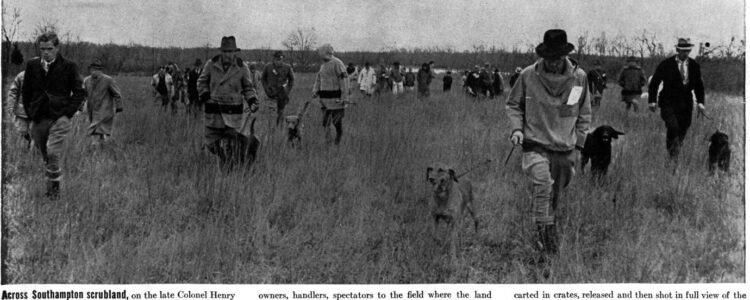
The first championship stake was held in Southampton, Long Island on November 20-21, 1938. Blind of Arden was one of twenty-two of the best retrievers in the US came to compete. They retrieved pheasants shot in the field and ducks shot over water. The dogs saw some birds shot while other birds were planted out of sight. Dogs had to be guided by their handlers to find these birds.
In the header image, you can see the judges, owners, handlers, spectators and dogs trudging across the field trial grounds. 1
The Winner
One dog, FC Blind of Arden did the work without a mistake. He clinched the win with the final blind retrieve described as follows:
“…a dead duck, unseen by the dogs, was planted on an island. At a signal from his handler, Blind jumped into the water and swam to the island. There he scented the bird, looked back only twice to the handler, who with his arm waved him in the right direction. Quickly finding the duck, Blind picked it up with a firm mouth, started swimming back to his handler.” 2
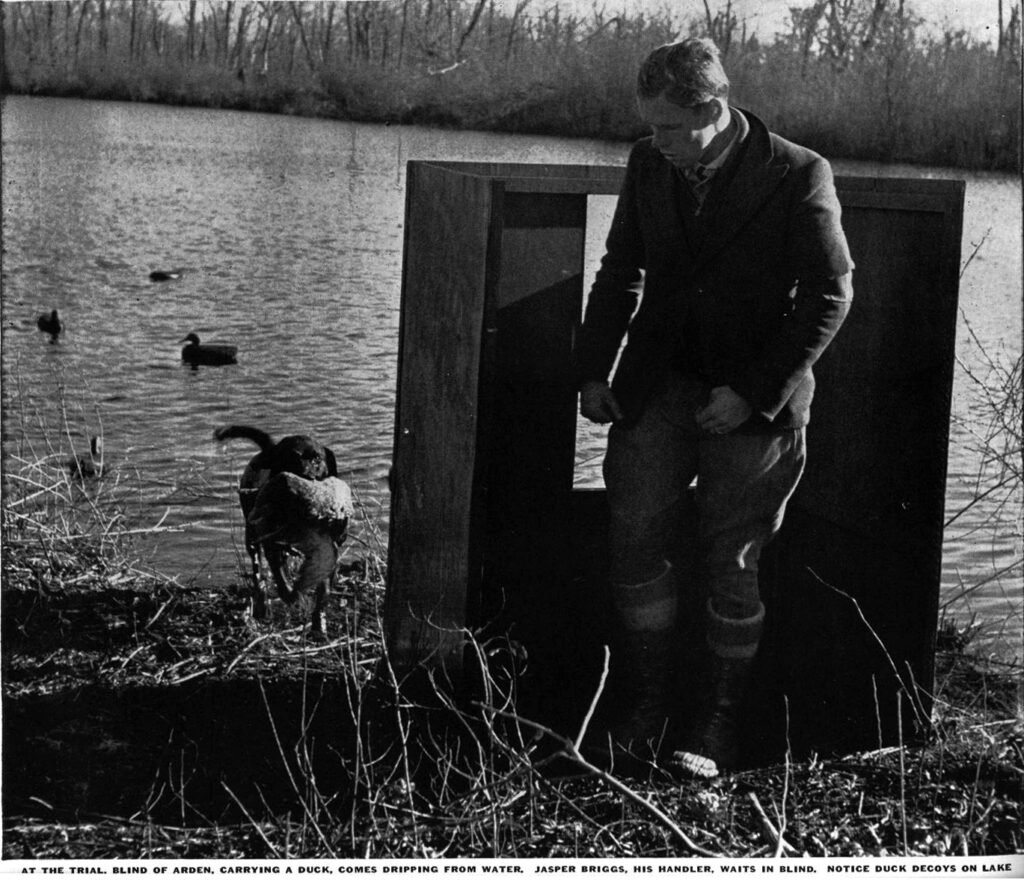
Blind retrieving a duck to his handler, Jasper Briggs.
Life Magazine featured Blind on the magazine’s cover on December 12, 1938. This was the first time a dog had ever been on the magazine’s cover.
US Field Trials
The Labrador Retriever breed was just getting started in the United States and had only been officially recognized by the America Kennel Club five years earlier.
The first retriever field trial was held in 1931. In 1935, Field and Stream Magazine provided a perpetual trophy that would be awarded each year to the dog that earned the most points in Open All-Age stakes. Blind of Arden won it the first year and his half-sister, FC Tar of Arden, won it a few years later. It was 1941 before the National Retriever Field Trial Club was formed.
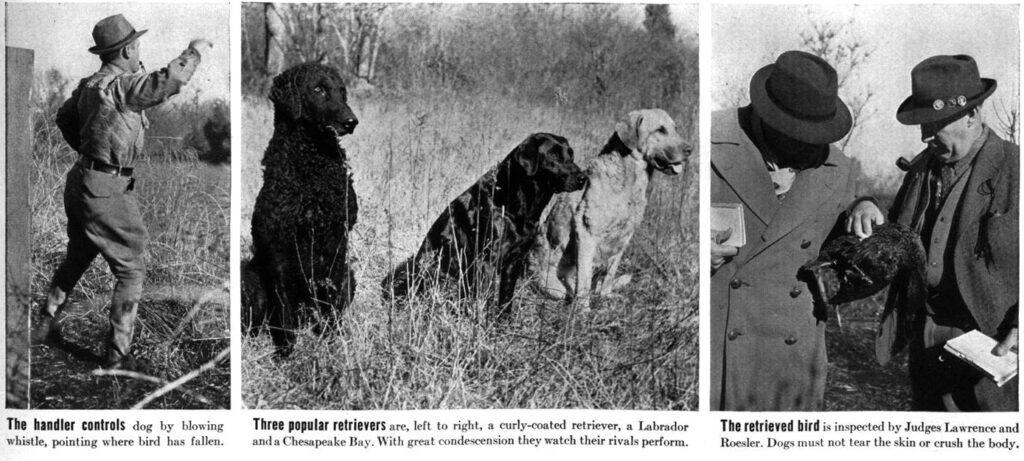
(left) A handler controls the dog using whistle and arm signals.
(center) Three retriever breeds – a Curly coated retriever, a Labrador and a Chesapeake Bay retriever.
(right) Judges inspect a retrieved bird. Dogs must hold them firmly, but gently so as not to break the skin or crush the bird. After the trial, the birds are sold.
At that time, retriever trials were the realm of the very rich. Owners imported dogs from England, enticed dog trainers from Scotland and set up amazing hunting estates on the east coast. To have a chance of winning the Field and Stream trophy, dogs had to run in many trials throughout the East and Mid West.
Blind’s owner was W. Averell Harriman of New York. He was the son of a railroad baron and, in his own career, he served as Secretary of Commerce under President Truman, served as a diplomat in relations with the Soviet Union during World War II and later served as governor of New York.
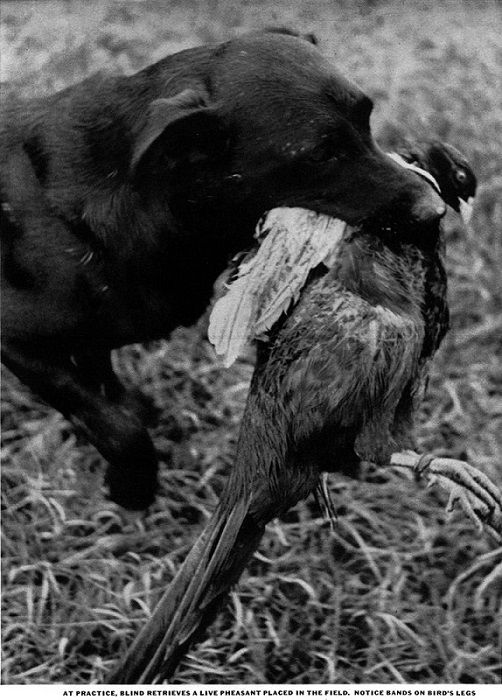
Blind of Arden training with a live pheasant.
Blind of Arden’s Pedigree
| Odds On FTW | The Favorite FTW | The Limit |
| Cache Of The Rhins FTW | ||
| Jest | Mansel’s Timothy | |
| Bess | ||
| Peggy of Shipton FTW | Ronald of Candahar | Eng FTCh Rag Tag |
| June | ||
| Gehta of Sigeforda | Eng FTCh Banchory Bluff | |
| Eng CH Balbeardie FTW |
Although Blind didn’t seem to produce any titled dogs himself, he did pass on his genetics to future generations. Some dogs that descend from him include:
- CNFC FC AFC Ardyn’s Ace of Merwalfin
- Eng FTCh Eng AFTCh Slo-Poke Smokey Of Dairy Hill
- FC AFC Jet of Zenith
- CNFC FC Rip of Holly Hill
Blind’s great great grandson
Jet of Zenith’s pedigree is interesting.
| NFC AFC Massie’s Sassy Boots Hall of Fame |
Shadow II | Black Spook of Riverside |
| Dark Lady | ||
| Penney of Wingan | Darky of Wingan | |
| Bancstone Dinah | ||
| Thornwood Rhea | CNFC FC Rip of Holly Hill | Skip of Timber Town |
| Okanagan Molly (by Varnish’s Tuff, out of Marjay of Wingan, by Blind of Arden) | ||
| Graysmarsh Christmas | 3xNFC CFC Dual CH Shed of Arden | |
| Graysmarsh Middy (by Blind of Arden) |
Starting at the bottom of the pedigree, Blind’s daughter, Graysmarsh Middy, was bred to her cousin, 3xNFC CFC DUAL CH Shed of Arden, thus doubling up on Peggy of Shipton.
A female from that litter, Graysmarsh Christmas, was bred to CNFC FC Rip of Holly Hill. Rip was a great great grandson of Blind through Okanagan Molly, thus doubling up on Blind.
A female from the Rip x Christmas litter, Thornwood Rhea, was bred to NFC AFC Massie’s Sassy Boots. Boot’s mother, Penney of Wingan, had several lines back to Eng DUAL CH Banchory Bolo and other dogs owned or bred by Lorna, Countess Howe.
Read more about the Wingan Labradors.
Blind’s sisters
Then there was Blind’s full sister – FC Decoy of Arden – who was an outstanding producer. She was the mother of:
- 3xNFC CFC DUAL CH Shed of Arden,
- DUAL CH Braes of Arden,
- DUAL CH Gorse of Arden,
- CH Earlsmoor Moor of Arden,
- CH Earlsmoor Marlin of Arden (all by CH Raffles of Earlsmoor) and
- FC Gun of Arden (by Toff of Hamyax FTW)
And Blind’s half-sister – NFC Tar of Arden (by Hiwood Risk) – who was the mother of Dual CH CFC Little Pierre Of Deer Creek.
(Click for help understanding the various titles dogs have earned)
Arden Labradors
Blind was bred and owned by Mr. Harriman.
“According to Bob Bartos, ‘Harriman had some of the greatest Labradors. His Arden dogs were bred from the best English stock and they became the first important competitive winners…’
“Harriman knew quality, played to win, and possessed the financial resources to kick out the jams. For members of his elite social class, shooting and sport hunting were revered pastimes. Harriman hunted grouse at Arden and Sun Valley, two of his personal estates, and he never missed the British shooting season. This is where he first glimpsed Labradors in action. He was awestruck.” 3
First National Field Champion Blind of Arden
Whelped: March 20, 1933
Breeder/Owner: W. Averill Harriman, Arden Kennel
Registration: 965,612
Abbreviations:
AFC – Amateur field trial champion
CFC – Canadian field trial champion
CNFC – Canadian national field trial champion
Dual CH – Dual champion (show and field champion)
Eng AFTCh – English amateur field trial champion
Eng FTCh – English field trial champion
FC – Field trial champion
FTW – Field trial winner (not a title)
NFC – National field trial champion
Notes:
[1] Blind of Arden Wins No. 1 U.S. Retriever Test. (1938, December 12). Life, 5, 26–27.
[2] Ibid
[3] Fernandez, Amy. Retriever Field Trials – The Early Days. Canine Chronicle. 2020, Aug 26. 2024, May 21. https://caninechronicle.com/current-articles/retriever-field-trials-the-early-days/
Originally published September 17, 2021. Updated May 21, 2024.

Key points:
- Blue-green algae is actually cyanobacteria that clumps together and looks like algae.
- Found in and around bodies of water during or shortly after hot, sunny weather.
- Can be clumps of blue, green, yellow, brown, or red — OR — can look like paint floating on the water.
- Dogs playing in or drinking affected water can become sick very quickly and can die.
As pet owners, we want to give our dogs the best possible care. However, sometimes even our best efforts can’t protect them from hidden dangers.
One such danger that’s becoming more common is blue-green algae, which produces toxins that are deadly to dogs.
What is Blue-Green algae?
They are a type of bacteria found in bodies of water, such as ponds, lakes, rivers, and even saltwater. It’s found throughout the world, generally when the weather is warm and sunny (or has been recently).
Usually blue-green in color, it can form dense mats, called blooms, on the water’s surface. These blooms can range in size from small patches to covering entire lakes. Or it can look shiny, oily, or like paint floating on the water.
Swimming or playing in contaminated water can cause hay fever-like symptoms, skin rashes, and respiratory and digestive distress. Drinking water contaminated with a high concentration of blue-green algae could cause liver and kidney damage. Symptoms often begin within hours.
Even short-term exposure can cause acute illnesses in people and dogs.
The dangers of blue-green algae for dogs
Dogs are generally more at risk, as they like to play and swim in the water and even drink it. Playing fetch in affected water can be twice as dangerous as the toxins may be swallowed and on the body.
Symptoms can appear within minutes of exposure, and can include:
- vomiting
- diarrhea
- weakness
- difficulty breathing
- seizures
- death
If your dog has been exposed to blue-green algae, it’s important to act quickly. Call your vet and describe any symptoms your dog has. If possible, bring a sample of the water with you to the vet to help with diagnosis and treatment.
Identifying blue-green algae
Although it can sometimes be hard to identify, tell-tale signs include:
- water that looks like pea soup, green paint, or blue-green scum
- foam or bubbles on the surface of the water
- clumps or mats on the water or along the shoreline
- a musty or earthy smell
If you think there’s blue-green algae in a body of water, keep your dog away from the water.
Test kits are available and testing can be done on-site with results in about 15 minutes. Amazon usually has these kits for about $25. Be sure to use waterproof gloves when collecting a sample. Nitrile exam gloves are readily available online or at a local pharmacy.
More dangers
Although swimming in or drinking affected water is the most common cause of illness, it’s not the only cause.
Recently a professional trainer was working the dogs in his care and when finished he let them all out to play. Several of the dogs stopped to eat something on the bank of a pond. The trainer thought it was goose poop because there were geese in the area.
That evening some of the dogs became ill. Despite veterinary care over the course of several days, six of the dogs died. Necropsies determined the dogs died from eating toxic algae. Most of the dogs were preparing to compete in field trails and were owned by the trainer’s clients.
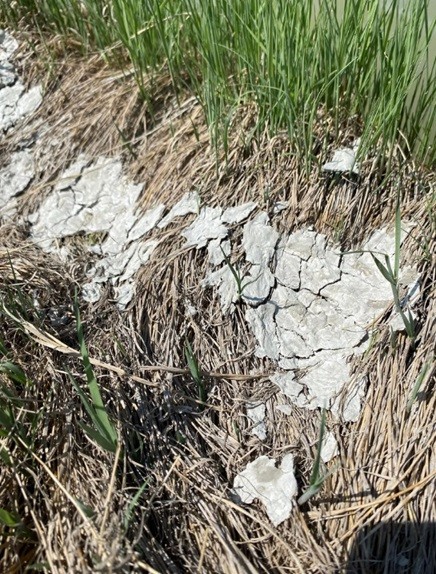
Photo provided by Utah Division of Water Quality
Protect your dog from exposure
The best way to protect your dog from blue-green algae is to prevent exposure in the first place. Here are some things to keep in mind:
- Check for local advisories.
- Many states have websites that post advisories about blue-green algae outbreaks in local bodies of water.
- If you’re not sure about the safety of a body of water, keep your dog on a leash and away from the water.
- Blue-green algae thrive in stagnant water, so it’s best to avoid ponds or lakes that don’t have a lot of circulation.
- Be vigilant.
- Watch your dog closely for any symptoms when they are swimming or playing in the water. If you see any of the symptoms listed above, contact your veterinarian immediately.
Quick Reminder
Blue-green algae often grows in ponds and lakes when the weather has been warm and sunny. The toxins it produces can be deadly to dogs.
Check for clumps of blue-green algae in the water or along the shoreline. Sometimes it will look shiny, oily, or like paint floating on the water. If you’re not sure, keep your dog out of the water.
Test kits are available and only take about 15 minutes for results.
If your dog goes in or drinks any water that you suspect has blue-green algae, contact your veterinarian immediately for advice.
Be aware of the health risks and take precautions to reduce your dog’s exposure to contaminated water. Keep your dog safe and healthy so they can enjoy the outdoors.
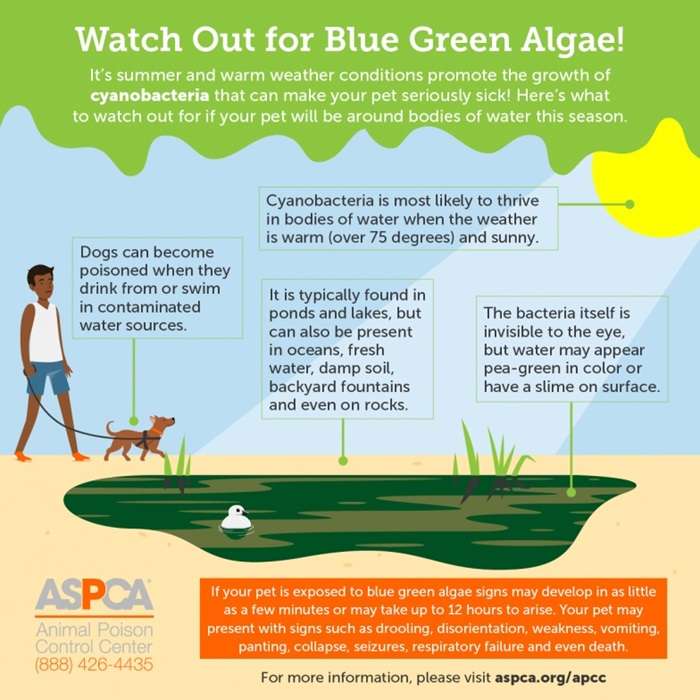
Header image courtesy California Waterboards – https://www.waterboards.ca.gov/
NOTE: The information on this website is not intended to replace your veterinarian’s advice. This information is intended to provide non-technical information in an easy-to-understand format. The website author accepts no responsibility or liability for how this information may be interpreted or construed, or any actions that might be taken as a result of the information herein.

